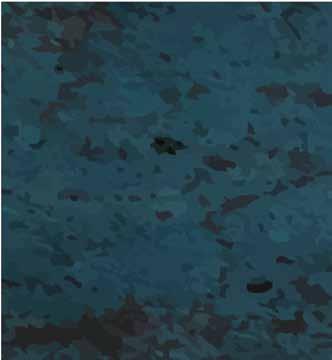SOURCING JOURNAL
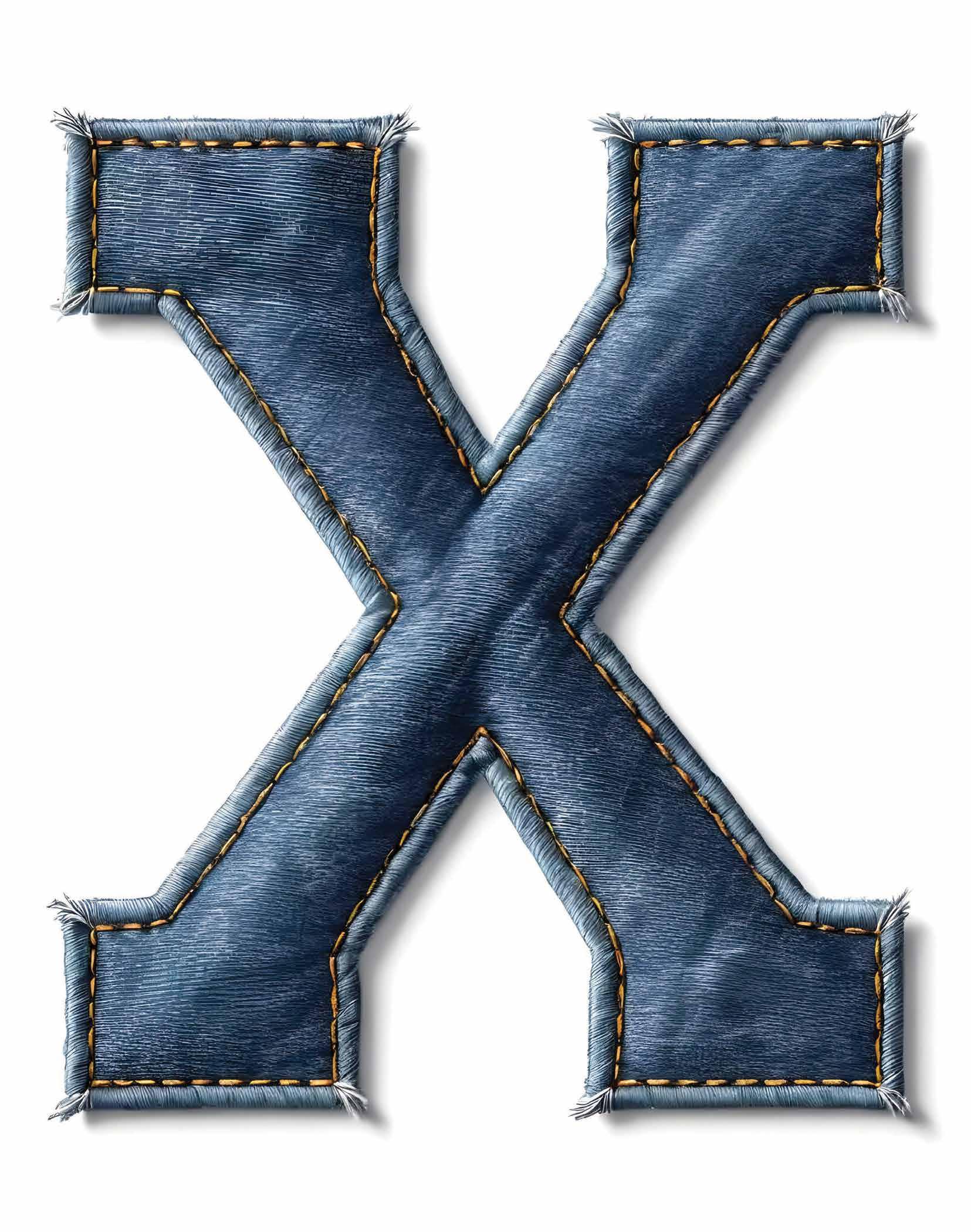






























































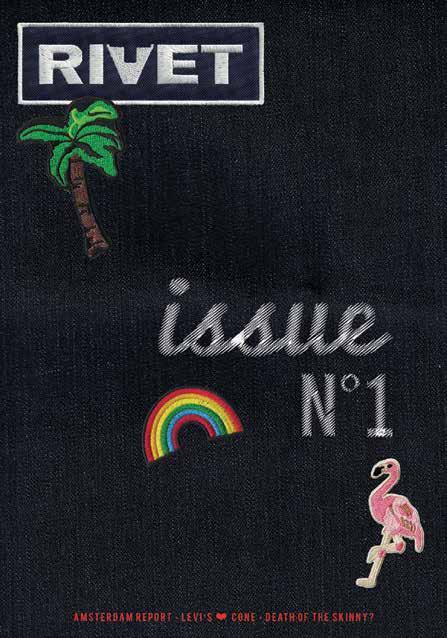
Whoever said time flies when you’re having fun clearly didn’t factor in global pandemics, shifting consumer behavior, social media, unstable economies, and rising social and political unrest.
Ten years ago, we launched SJ Denim. And while much of the journey has been exciting and rewarding, having a front-row seat to the denim industry’s evolving challenges and disruptions has been nothing short of eye-opening.
Industry veterans often point out that the denim world is perpetually nostalgic, frequently looking back on past decades as the golden age of denim, but it would be a mistake to overlook the significance and urgency the challenges denim is facing today. And it’s not just denim—nearly every apparel category (and arguably, every industry) has oscillated this year between uncertainty, pessimism, hope, and a pervasive sense of stagnation.
Still, I’m hopeful the denim industry can shake off this funk in this new season. There’s little value in dwelling for another six months—it’s time to confront the new realities of tariffs and market consolidation and start forging a fresh path forward.
One key source of hope is sustainability. In conversations with mills and suppliers for this issue, it’s encouraging to see that sustainability has evolved from a niche initiative into a non-negotiable mandate. Just a decade ago, it was often limited to capsule collections targeting a select audience— today, it’s embedded in core strategies across the board.
In “Saving Sustainability” on pg. 38, mills share how they’re preserving key programs amid shrinking budgets— and why, for many, sustainability isn’t just the right thing to do, but a smart cost-saving strategy. This issue also brings fibers into focus—the first link in the supply chain and a telling indicator of the direction denim is headed.
No matter how things feel right now, the reality is denim isn’t going anywhere—it’ll be around for the next decade and beyond, experiencing the same levels of highs and lows that SJ Denim has covered for the last 10 years. And the jeans you’re wearing today? If they’re made well, they’ll still be here too—either as a beloved staple in your own closet or getting scooped up by twenty-something Gen Alphas at vintage markets, eager to wear whatever aesthetic this strange era ends up being remembered for.
If the last 10 years have taught us anything, it’s that denim will always find a way to stay in style.
Angela Jean Velasquez EXECUTIVE EDITOR
Lauren Parker Director Fairchild Studio/SJ
INTERNATIONAL
SOURCING JOURNAL ADVERTISING
Deborah B. Baron Advertising Director
PRODUCTION
Anne Leonard Production Manager
Client Activation
Barbra Leung Director, Integrated Marketing
Alexa Dorfman Senior Marketing Manager
Kayla Gaussaint Associate Integrated Manager
OPERATIONS
Ashley Faradineh Executive Director, Operations
Rosa Stancil Media Planner
Emanuela Altimani Senior Sales Coordinator
SOURCING JOURNAL IS OWNED AND PUBLISHED BY PENSKE MEDIA
Jay Penske Chairman & CEO
Gerry Byrne Vice Chairman
George Grobar Chief Operating Officer
Sarlina See Chief Accounting Officer
Ryan Young Chief Security Officer
Craig Perreault Chief Digital Officer
Todd Greene EVP, Business Affairs & Chief Legal Officer
Celine Perrot-Johnson EVP, Operations & Finance
Paul Rainey EVP, Operations & Finance
Tom Finn EVP, Operations & Finance
Jenny Connelly EVP, Product & Engineering
Ken DelAlcazar EVP, Finance
Debashish Ghosh Managing Director, International Markets
Brian Levine Senior Vice President, Revenue Operations
Brooke Jaffe Senior Vice President, Public Affairs & Strategy
David Roberson Senior Vice President, Subscriptions
Frank McCallick Senior Vice President, Global Tax
Gabriel Koen Senior Vice President, Technology
Jerry Ruiz Senior Vice President, Oprations & Finance
Judith R. Margolin Senior Vice President, Deputy General Counsel
Karen Reed Senior Vice President, Finance
Lauren Utecht Senior Vice President, Human Resources
Marissa O’Hare Senior Vice President, Business Development
Nelson Anderson Senior Vice President, Creative
Andrew Root Vice President, Digital Marketing
Andy Limpus Vice President, Executive Search
& Head of Talent Acquisition
Anne Doyle Vice President, Human Resources
Constance Ejuma Vice President, Content Performance & Analytics
Courtney Goldstein Vice President, Human Resources
Dan Gerber Vice President, Strategic Partnerships
Danielle Levine Vice President, Associate General Counsel
Denise Tooman Vice President, Marketing, Strategic Solutions Group
Eddie Ko Vice President, Advertising Operations
Eugenia Miranda Richman Vice President, Editorial Innovation
Gurjeet Chima Vice President, International Markets
Hector Nino Vice President, Human Resources
Jennifer Garber Head of Industry, Travel
Joni Antonacci Vice President, Production Operations
Josh Qualy Vice President, Programmatic Sales
Karl Walter Vice President, Content
Kay Swift Vice President, Information Technology
Keir McMullen Vice President, Human Resources
Lise Berichel Vice President, Associate General Counsel
Matt Ullian Senior Vice President, Special Projects
Matthew Reed Head of Industry, Automotive Sector & DS Penske
Autosport Team
Michele Singer Vice President, Associate General Counsel
Mike Ye Vice President, Strategic Planning & Acquisitions
Richard Han Vice President, International Sales
Scott Ginsberg Head of Industry, Performance Marketing
Sonal Jain Vice President, Associate General Counsel
Tim Chan Vice President, E-Commerce
Tom McGinnis Vice President, Corporate Controller



A

To ensure each pair fits exactly right, customers begin with a short quiz, answering questions about their preferred style, rise and fit (there’s also a section where customers can upload inspiration pictures). After that, they submit their measurements, guided by Ali Grace’s step-by-step measurement guide to make sure everything is accurate.
Andre Claudio
From reworking thrifted Levi’s in her dorm room to landing partnerships with retailers Revolve and Anthropologie, Ali Grace is building a denim brand rooted in custom fit and inclusivity. by

“it’s an absolute nightmare shopping for jeans.”
c In 2018, Ali Grace, founder and CEO of her namesake brand, was sitting in her dorm room at the University of Massachusetts Amherst when the frustration of finding jeans that fit finally hit a tipping point. c Instead of settling, though, she decided to launch a brand dedicated to giving women the perfect fit (something she’d been yearning for). c “Denim is a timeless product, but it’s also traditionally been very exclusive. When I started, there wasn’t anything like this—nothing that offered inclusivity through custom fit at scale. Brands like Abercrombie and Good American are doing a great job now, but back then there was a real gap,” Grace told SJ Denim. “I wanted to create a one-stop shop where people could get jeans tailored to their exact measurements, something the industry had never done before.” c For the brand, Grace reworks vintage Levi’s—hand-selected from thrift stores—and tailors them to fit “every body and every size.”
While orders come with a four to seven week wait time, the process is highly personalized. In fact, someone from the Ali Grace team checks in directly with each customer to confirm details and flag anything that doesn’t look quite right.
“We ask for [each customer’s] Instagram, email and phone number because we want to have multiple ways to reach [them] in case something isn’t adding up,” Grace said.
“Since we’re working with vintage denim, we don’t want to make changes that can’t be undone. For example, if you say your inseam is shorter than it really is and you’re 5’10” asking for a 30-inch inseam, we know that’s going to be too short. Once it’s cut, it can’t be made longer. We’d rather preserve the integrity of the denim and get it right the first time. That’s why we ask for all that information…so we can deliver a pair of jeans that feels like it was made just for you.”
Like Grace, who once struggled to find the right fit, her customers are solving the same problem—and the demand is reflected in the sales.
While she initially launched the brand in college, Grace took a short hiatus during the Covid-19 pandemic. A few months later, she decided to relaunch. “I opened the site at midnight, went to bed, and woke up with $60,000 in sales in just 12 hours,” she recalled. That moment proved to be a turning point. Today, the brand is on track to generate $1.5 million in sales in 2025, with about 70 percent coming from wholesale—through partners like Revolve, FWRD and Anthropologie, and soon Neiman Marcus and Bergdorf Goodman—and 30 percent from direct-to-consumer.
“Waking up to $60,000 in sales was definitely a pivotal moment for me…it showed just how much interest there was in the brand,” Grace said. “This year, while we did fall short of our $1 million wholesale goal…it’s still surreal just to see how far [the brand has grown].”
Now, as Grace continues to scale, she has her sights set on transforming Ali Grace into a lifestyle brand that goes “beyond vintage denim.”
WAKING UP TO $60,000 IN SALES WAS DEFINITELY A PIVOTAL MOMENT FOR ME…”
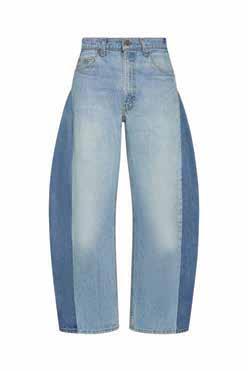
While she plans to stay rooted in jeans, she’s working on a modern line—still under the Ali Grace umbrella—that takes inspiration from vintage but expands into new product categories (which are currently kept under wraps).
Part of that growth includes exploring men’s wear. Rather than diving in headfirst, Grace is testing the waters. For example, she’s been experimenting with styles designed for women that could translate well to men, tracking how they sell before bringing in male fit models to refine silhouettes.
The goal, according to Grace, is to eventually launch a small, curated men’s offering, and over time, develop a modern line that could be fully unisex.
“I know women’s bodies best…that’s what I built the brand on,” she said. “But now, we’re in a position to grow further, learn new categories and figure out how to perfect men’s fit.”
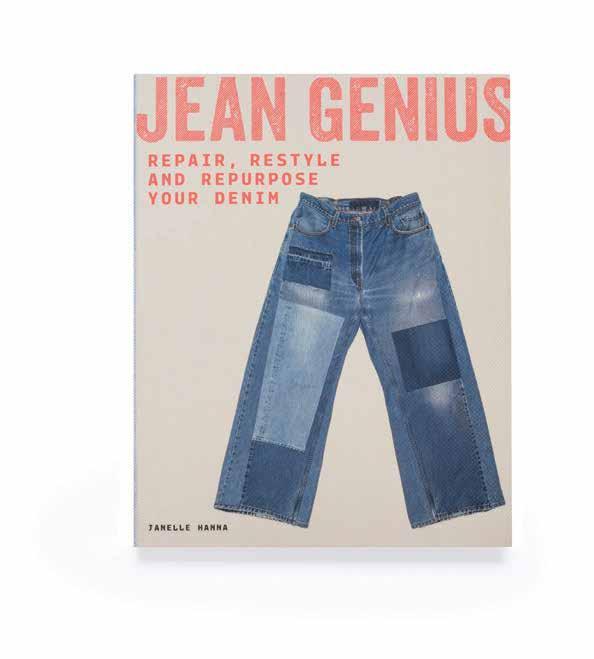

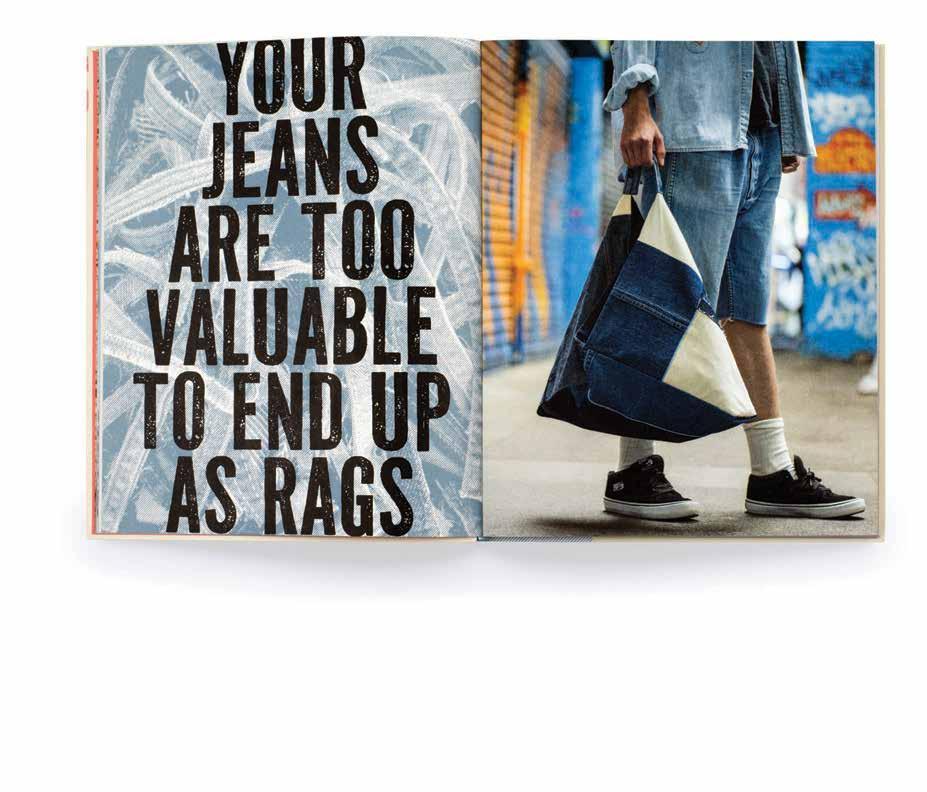
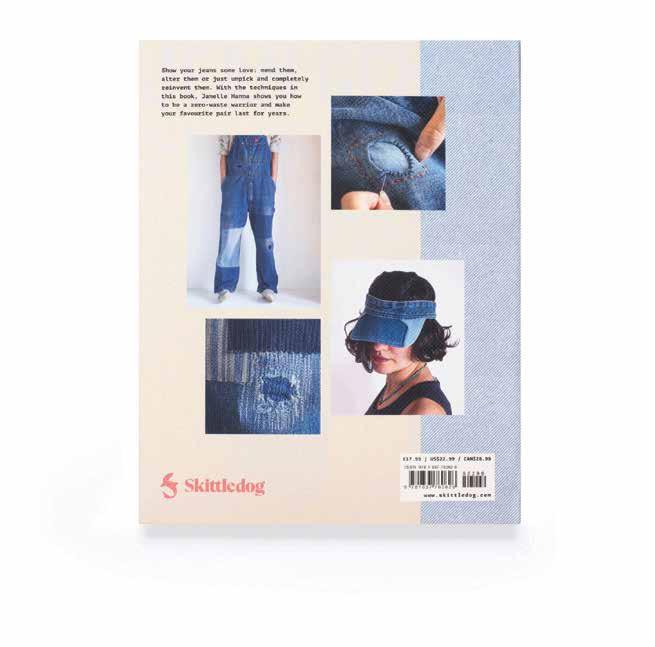
a new book shares the expert insights and practical guidance of Janelle Hanna—circular fashion consultant, denim specialist, and founder of White Weft—offering inspiration and know-how to DIY enthusiasts and aspiring upcyclers alike.
“Jean Genius: Repair, Restyle and Repurpose Your Denim” from Skittledog Publishing is a 160-page paperback that serves as a creative blueprint to help consumers give jeans a new lease of life. Packed practical tutorials, tool tips and ideas drawing from Hanna’s experience the paperback teaches sewers of all levels a range of genius jean repair, repurpose and restyling skills.
The idea for the book arrived in Hanna’s inbox. “Late one Friday afternoon, my inbox pinged,” she recalled. “For a change it wasn’t from someone offering to buy my business or quadruple my socials reach, but a publisher with a simple question: would I be interested in authoring a book on denim repair and upcycling?”
Hanna replied instantly and began work on the book in early 2024. “From the start we were very aligned on the book that we wanted to write—an accessible how-to guide for jeans lovers everywhere who can’t bear to part with
their favorite pair,” she said.
Start to finish, it took Hanna a year to nail down the 18 step-by-step repair and upcycling projects in the book. The book covers pocket, knee, crotch and belt loop repair techniques, taking in and expanding the waist, hemming, adjusting leg widths, transforming jeans to shorts and skirts, splicing. Readers will also learn how to repurpose existing garments into new items such as hats, bags, slippers and other patchwork pieces.
“People think that denim is a tricky fabric to sew but it’s quite forgiving. Things might go wrong but you can easily unpick and start again,” she said, adding that a common misconception about DIY-ing is that you need industrial machines. “Probably because too many of us have at some point broken a sewing machine needle in denim and that feels quite catastrophic and intimidating but most of the time you just need a different needle or a few tricks to get around the thickest areas.”
Through White Weft, Hanna provides design consulting services, upcycling support and denim repair for brands and individuals. She’s become master at invisible darning after acquiring a darning machine from a business
PEOPLE THINK THAT DENIM IS A TRICKY FABRIC TO SEW BUT IT’S QUITE FORGIVING.” Janelle

opposite her studio. However, her favorite projects are creative repairs where she can use her denim design skill set on commissions for brands and individuals.
White Weft is Hanna’s vision of what future business models for jean companies should look like—where brands and designers utilize old denim as they do with new denim. “I’ve realized that no amount of innovation could realistically be enough to lower our impact in line with climate targets unless we decreased production and kept the clothing we have in use for longer,” she said.
The book reflects this philosophy. “It explains to the average person why it’s so important to choose your denim well, explaining in simple terms the ins and outs of denim production. It gives them skills and confidence to try creative denim projects at home,” she said.
by Alex Harrell
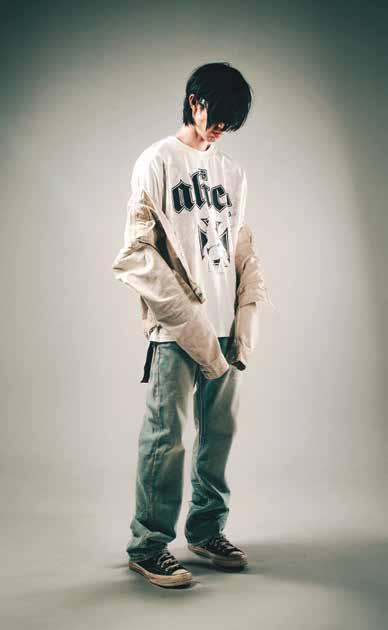

how does a label last 20-plus years in an industry built on burnout? Better yet: how does it remain authentically cool? Many may chase relevance, but few set the tone. For Australian cult denim label Ksubi, survival (and success) hasn’t hinged on chasing trends—just the opposite: by holding fast to its DNA.
Born out of Sydney in 1999 by a group of friends fed up with cookie-cutter jeans, Ksubi staked its name on provocation with an ethos forged in defiance; its 2001 debut infamously included 200 live rats on the runway.
Now, with Pip Edwards named creative director—a multi-hyphenate who started her career at the label, had her son with co-founder Dan Single, and has returned in a full-circle twist—Ksubi is betting that consistency and chaos are still the right formula for staying power.
Edwards started back in 2004, initially in the PR department before moving to the design team. This early experience allows her to “slip in with the DNA” and make creative or product decisions “with a brand lens really quite seamlessly.”
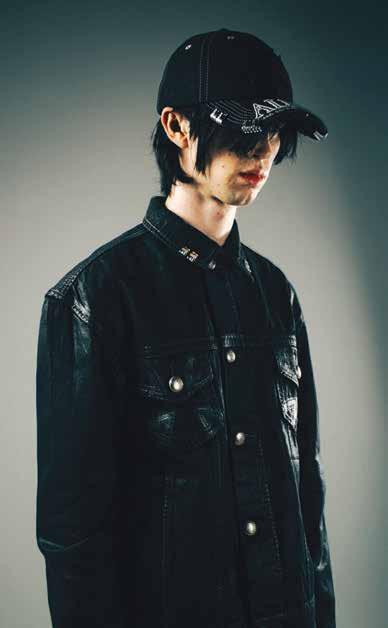
Though her return comes nearly two decades after her first chapter there, the feeling was familiar—like slipping on an old pair of jeans,” Edwards told SJ Denim.
It’s a full circle moment for Ksubi, too. Since emerging in 1999, the anarchic denim label has become a mainstay in Australian fashion and beyond, amassing a loyal following with celebrities like Hailey Bieber and Travis Scott in tow.
There’s also the family subplot. Her son, Justice, now works in one of the brand’s stores. It’s a neat, generational twist: the kid who grew up with Ksubi now literally sells it, carrying forward its swagger for a new audience.
“It’s got so many parts and aspects; you couldn’t [even] script it, really,” Edwards said with a laugh.
Ksubi’s origin story is its anchor: it was born from a genuine need, a desire for denim that didn’t exist.
The brand’s foundational “lux rebellion” spirit is expressed through signature distressed denim and an iconic box-cross logo. It’s also how a Ksubi customer from 2004 and one from 2024 can recognize the same essential brand some 20 years apart.
From a product perspective, the brand’s DNA includes the distinctive distressed denim application—what Edwards noted as still being quite prominent—as well as the iconic box cross logo.
While that DNA is fixed, its expression is what evolves. The concept is not unlike the literary trope of regionalism or local color genre—telling the same core story, just tailoring the language and presentation for new audiences and global regions. In the fashion world, that means styles shift, markets expand, campaigns look different.
Edwards is clear on the distinction.
“I don’t think roots, brand roots, shouldn’t really change, don’t really change. It can evolve in terms of product and presentation and marketing,” she said. “But in terms of DNA? That’s never changed. I don’t think it should ever change.”
Need more evidence? Ksubi’s recent collab with L.A.-based Alice Hollywood was explicitly described as a love letter to the days of unapologetic denim: the early 2000s— aligns with Ksubi’s strategy of leaning into its heritage with a modern lens.
“We’re very community led,” Ksubi chief executive officer Craig King added. King has

been with the brand for over 20 years in various capacities; something the colleagues have in common. The two worked side by side at General Pants Co. 13 years ago, where Edwards served as design director until forming her athleisurewear brand, P.E. Nation.
“We sort of built this brand from the streets—from the people that really loved the brand—rather than trying to take too much of a lead position and trend preaching,” King said.
Featuring laser-cut leather appliqués, signature metal lighter clips and nods to indie sleaze, the synergistic capsule doesn’t invent something new. Instead, teaches a new audience about a pivotal moment in Ksubi’s history, suggesting that success lies in knowing how and when to reintroduce your past.
“Do things your way,” she said. For Ksubi, that way is rather big—even a “bit brassy,” per Edwards. But it’s their own.
FFOUNDED IN New York City in 1945 by Harry Copen, a visionary entrepreneur with a progressive spirit, Copen began its journey with a clear mission: to bring innovation, quality and reliability to the textile industry. Eight decades later, that vision has grown into a global legacy that continues to shape the future of garment interiors.
As we celebrate 80 years, we look back with pride at how Copen has become a trusted market leader in pocketing, linings and waistbands. From precision jacquards and smooth viscose linings, to sporty mesh fabrics and seasonal pocketing collections inspired by stripes, geometrics, checks, nature and abstract prints, our products combine technical performance with style and craftsmanship. This broad portfolio has helped our partners create garments where the inside truly matches the excellence of the outside.
Over the years, our strategic expansion has been key to success. With warehouses and sales offices across North Africa, Europe, Asia, the U.S. and Latin America, we have built a supply chain designed to deliver closer to the needle point. This global footprint ensures that our partners—from leading luxury houses to large-scale retailers— receive the service, consistency and reliability they expect.
Our leadership journey is also a story of continuity. From Harry Copen’s founding vision in 1945, to Barry Emanuel guiding Copen into the new millennium, to today’s third-generation leadership of Louis King and Avi Chamiel, our DNA has remained constant. Together, they are building Copen United Limited into the world’s most recognized and responsible supplier of pocketing, waistbands and linings—all while preserving the values that have defined us for 80 years.
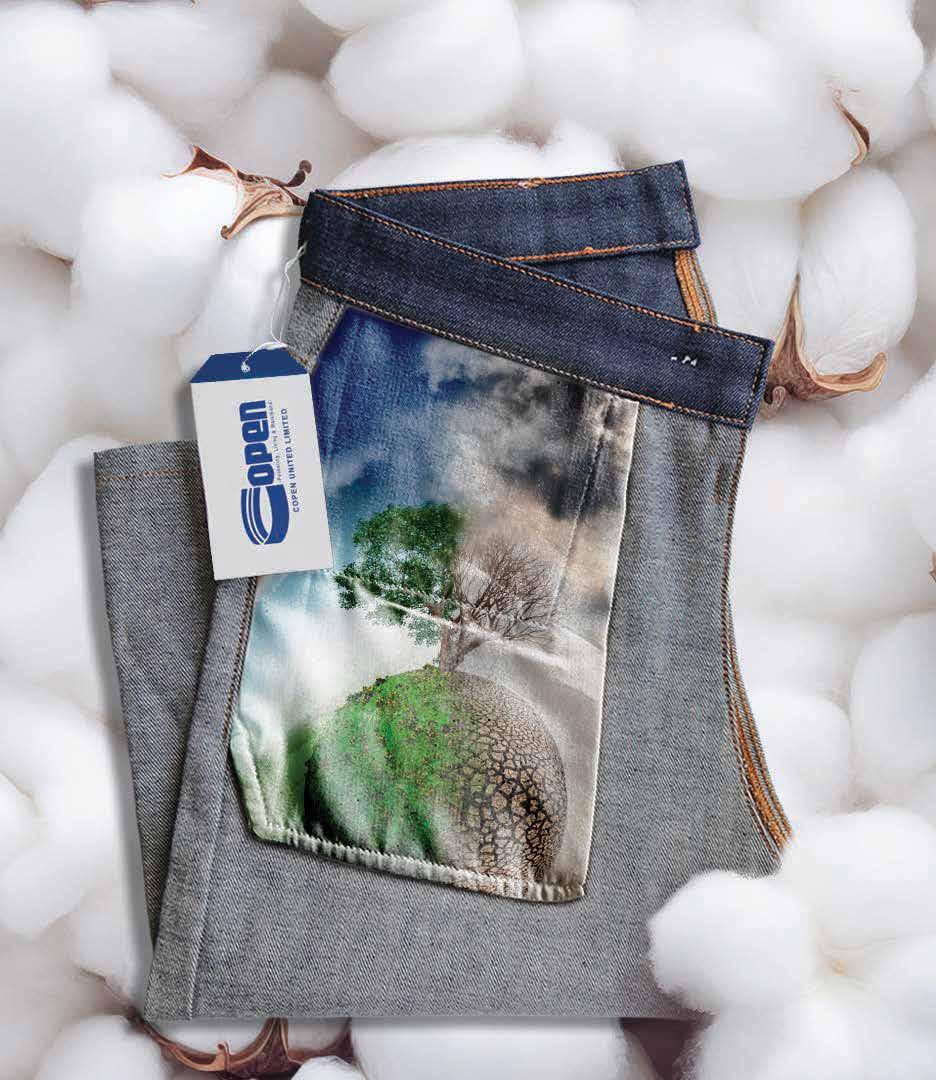

“BUT OUR STORY IS NOT ONLY ABOUT GROWTH. IT IS ALSO ABOUT RESPONSIBILITY. IN TODAY’S WORLD OF SUSTAINABILITY TRANSPARENCY AND RESPONSIBLE SOURCING, COPEN HAS BEEN AT THE FOREFRONT OF CHANGE.”
HARRY COPEN , Founder, Copen
But our story is not only about growth. It is also about responsibility. In today’s world of sustainability, transparency and responsible sourcing, Copen has been at the forefront of change. Through our use of recycled polyester, we have removed more than 100 million plastic bottles from landfills—living up to our motto of “saving the
planet, one pocket at a time.”
Our sustainability journey continues with the introduction of regenerative cotton, as well as ongoing innovations that reduce impact and improve garment performance.
Looking ahead to 2026 and beyond, the future looks brighter than ever. From expanding into new regions, to advancing performance-
related fabrics, to investing in the next generation of textile talent, our mission remains the same as it was 80 years ago: to serve our partners with innovation, reliability, and passion for excellence.
To everyone who has supported Copen on this journey, thank you. Here’s to the next chapter of innovation, sustainability and growth. ■
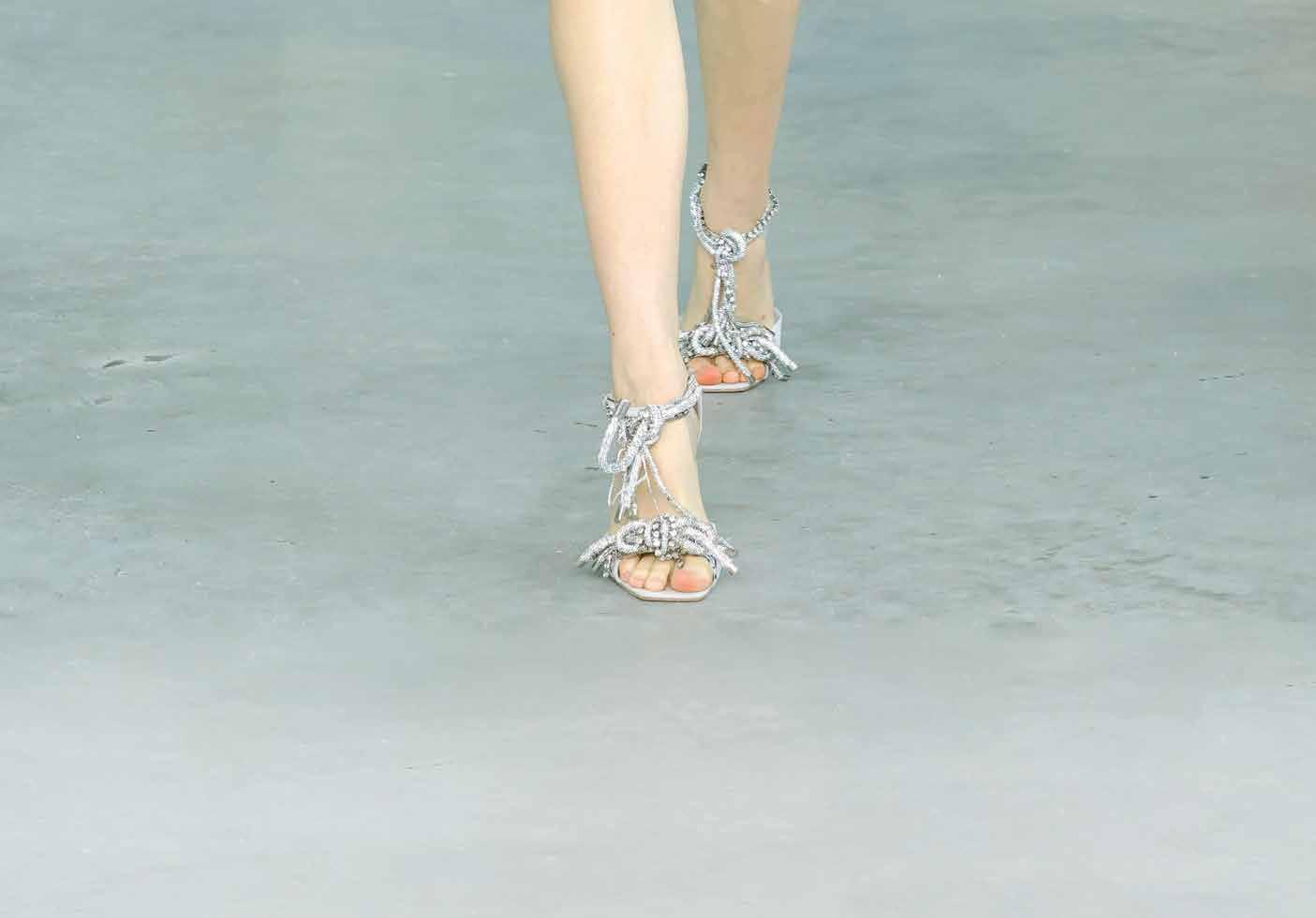
Designers have bold ideas for Spring/Summer 2026 denim. by Angela Velasquez
in a sea of safe , traditional blue jeans, some designers are taking a risk and reminding the world of denim’s boundless potential for reinvention. From Diesel’s introduction of satin denim to Harri’s mind-bending optical illusion laser work, and Area’s sculptural silhouettes that demand more than just a passing glance, these designers are pushing the boundaries of what denim can be. Spring/Summer 2026 collections are a canvas for innovation, expression and high-concept creativity.


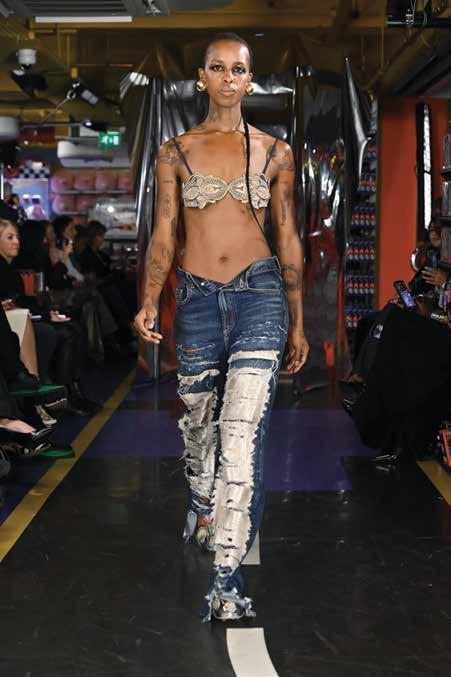
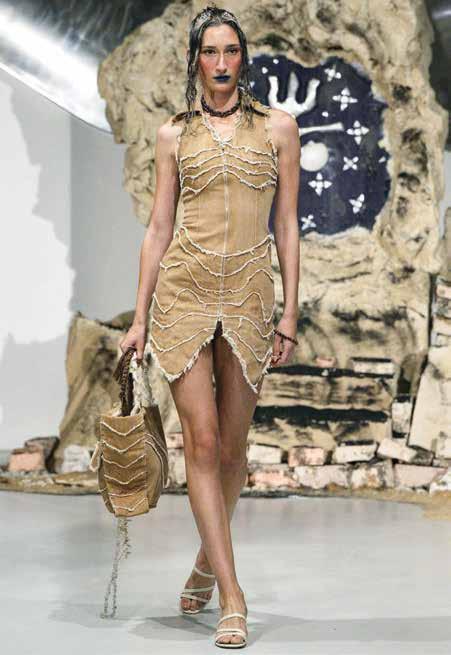
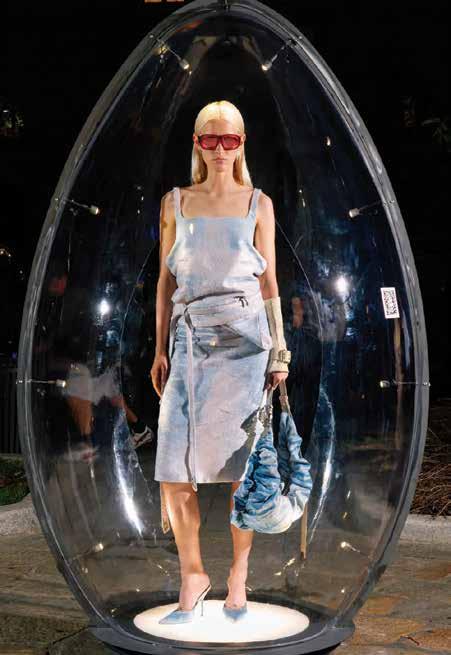
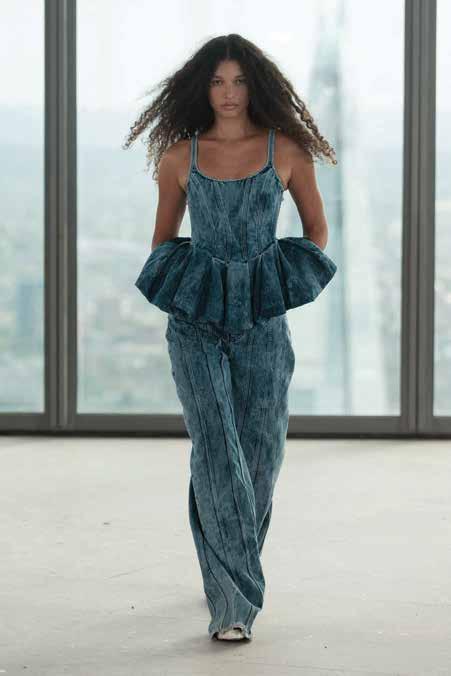
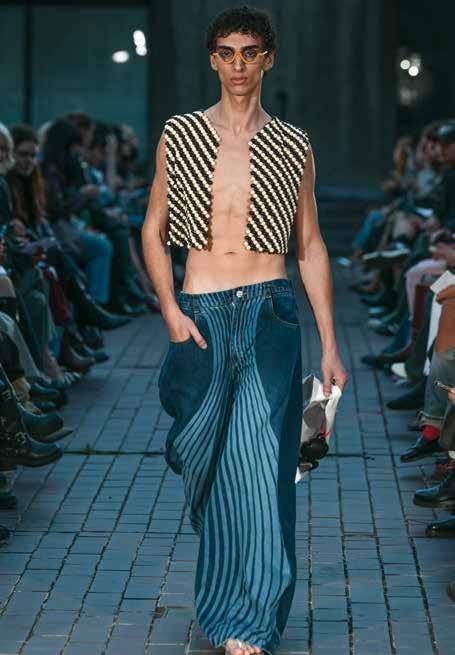
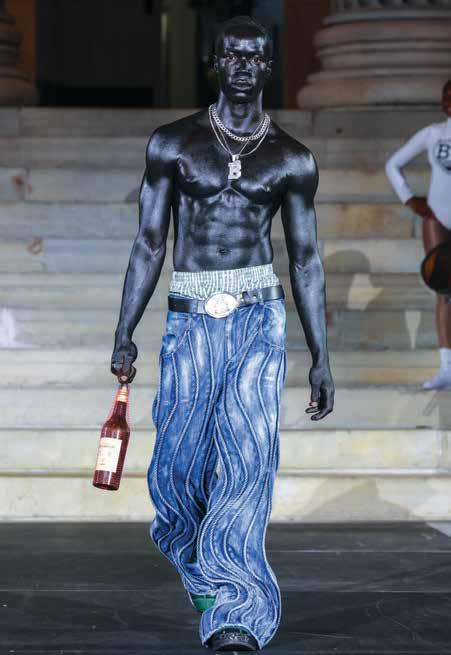
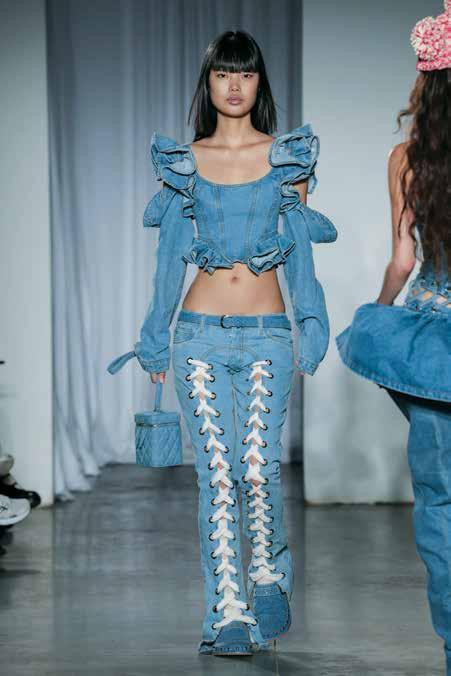
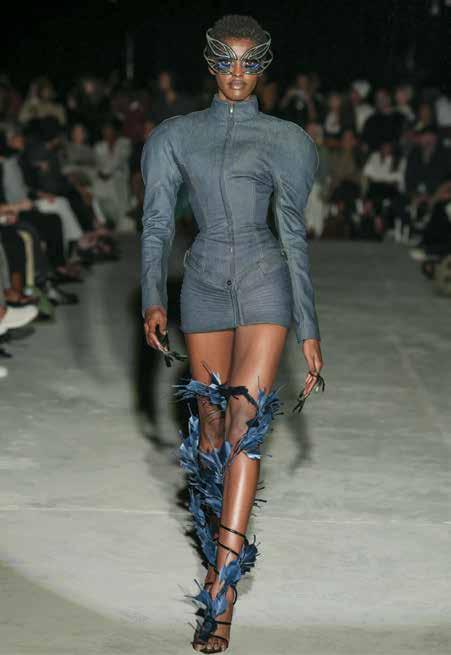
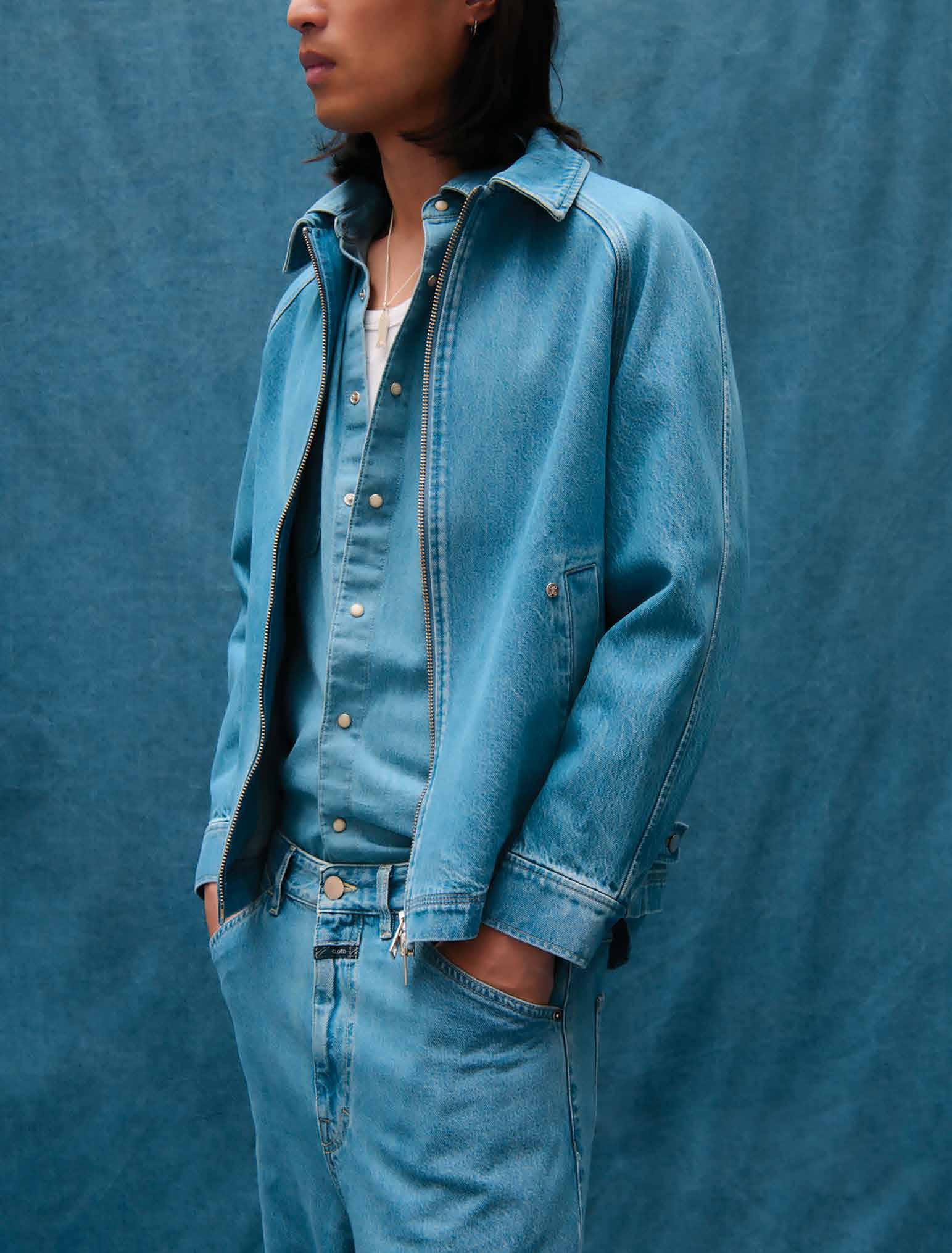
Leaders inside denim brands give the scoop on their Spring/Summer

men’s denim is ready for a season of ease Brands have turned to vintage influence, Western roots and coastal cool as inspiration for their Spring/ Summer 2026 men’s collections. They’re delivering relaxed styles built for comfort, with looser fits, lighter fabrics and sun-streaked washes dominating the market for next year for a consumer interested in an effortless, easygoing feel. The market has displayed an openness for deviations from the status quo, and brands are counting on nostalgia-tinged, casual-coded styles to keep propelling their men’s businesses.
c Here, creatives and executives from crowd-favorite denim brands share more about the trends, ideas and innovation shaping their upcoming men’s collections.
Uwe Kippschnieder
senior denim developer and designer
On the men’s business [Men’s] is quite stable, but we’ve seen some growth since about a year [ago]. Our sales in the shops for full price are developing quite well. I [recently] got the news that we see growth on the menswear [side] in the U.S. For our main market, which is still in Germany, it’s steady. We have a few brand shops in Germany that are doing well, and online business is stable.
• On fits and washes We are trying to keep the overall selection for our men’s fits quite tight at the moment, so we have four existing fits that were complemented by just one new fit, which is, for us, also the most fashionable fit. It’s a mix of a five-pocket [style] but with slightly different pocket solutions in the front. It’s not like the regular scoop pocket, but we have more slanted, worker-related pockets, and it’s our widest fit for the denim. We are continuing a little bit of what we had focused on in winter, which is to play with the casts and with the tinting. We are giving denim a new approach by changing the blues, with sometimes more vintage-related beige tints. We also have a blue denim which we washed down over dyed black, washed again and then tinted with a brown, so there’s a lot of changing the casts by tinting. My favorite [for] summer was a blue denim which we washed and then overdyed with indigo.
• On non-jean denim styles This is, for us, always an important topic in the collection. We like the idea of building suits, which doesn’t necessarily mean that it’s combined with a formal jacket. It can also, as we have it in the [SS26] collection, mean that you have a postal zip-up denim jacket combined with a worker denim shirt, with this new, wider leg jean—and this is all in the same color. The denims we used for shirting come from the same mill; they have the same base color, and we also washed it exactly the same.
• On inspiration for S/S ’26 [This] is one of the few collections which does not have a real topic. We were having a look in our archives, which is always quite inspirational for us, especially when it comes to the workmanship and the details. We were pulling some [fit] inspiration from there—and same with some of the wash developments.
• On opportunities I personally hope that the customer will appreciate—even more than he’s doing it right now—the fact that we are making our denim production [more] ecologically friendly. This is something we’ve worked since 2018 on…and when we started, it was very heavily pushed by the mills and the laundries, but also the end consumer, especially the younger ones. For them, it’s not just nice to have, but they are really looking for the jeans, or clothing in general, that is made in a greener way.

Jon Geller, men’s president
On the men’s business Men’s, especially when you have a women’s counterpart as big as ours, tends to fly a little bit under the radar. But our business is fantastic, both domestically and internationally. I think we’ve seen a return to sort of classic denim dressing as silhouettes have started to move a little bit wider.
• On fits and washes Slim-straight and straight-leg are our two dominant fits. We saw a lot of guys transition from slim and skinnies into slim-straights, but there’s [also] the group of guys that were already in our slim-straight fit, not moving up to straight legs or relaxed. I think the super relaxed and super-relaxed straight legs have been left to the youngest consumers…Naturally, right now, slim straight is probably our biggest focus as we continue to move forward.
• On non-jean denim styles We tend to bring in our lightest-weight denims and chambray fabrics for summer. In terms of chambray for summer, we have both short-sleeve and sleeve offerings. And [for] a denim jacket, we brought in our lightest-weight denim fabric that we like to use in summer for the hotter months… [We’ll have] two different color offerings—there’s a summer pop color as well as a washed-out indigo for that sun-faded jean jacket look.
• On inspiration for S/S ’26 Spring and summer have one overarching, holistic theme for us as we move into next year, which is this idea of courtside polished. Sporting events have become fashion shows, not only in the
crowd, but also for the athletes as they enter the tunnel. The two things that grabbed our attention for the upcoming season was one, the U.S. Open last year—the color palette. There was a lot of crossovers with what we were doing: whites, pastel blues and yellows, this idea of courtside polish. And then as we move into summer 2026, we’re going to have the World Cup here in the U.S., and a lot of our design team are big sports fans and big European soccer fans. We pulled inspiration from World Cups from the past… and really leaned into some classic styling for the World Cup.
• On opportunities Most guys aren’t going to go back to wearing sandpaper or rigid denim once shown that you can look as good, if not better, wearing comfort fabrics… We’ve added additional fabrications, but we’re never going to go out and do 100 percent rigid denim. Other brands that do that stuff, and they do it great, [but] we feel that we do stretch and comfort denim better than anyone, and that’s where we want to continue to focus and bring that to the world. I’m yet to find the guy that you know puts it on, looks good, feels good and wants to wear something else.
Eran Kaim
, chief product officer
On the men’s business Since we refined our denim vision and assortment in our F/W ’24 collection, we’ve experienced a strong positive response across multiple markets. Our e-commerce platform continues to lead in denim sales, reinforcing its importance as a primary channel. Retail stores and wholesale
MOST

partners now benefit from streamlined replenishment of key fits and washes, ensuring consistent availability and supporting sustainable growth.
• On fits and washes Our S/S ’26 collection draws heavily from our seasonal theme, Way Out West, showcasing a diverse range of fits. From authentic straight-leg cuts to flared silhouettes and workwear-inspired styles, the lineup reflects a noticeable shift toward looser, more expressive shapes, while still offering classic, timeless options.
Vintage-inspired blues continue to be essential, but this season we’re also introducing standout shades such as sun-bleached and faded yellow tones. These washes capture the essence of a sun-worn desert aesthetic, in line with our collection’s narrative.
• On non-jean denim styles This season, we’ve expanded our offering to include a denim jacquard fabric, crafted into coordinated shirt and short sets that add a unique, textured dimension to the collection. For more classic tastes, our chambray shirts— featuring signature Scotch & Soda detailing— offer a polished yet relaxed option. Additionally, for pre-Spring 2026, we’ve reintroduced our iconic denim jacket, now refreshed with heritage-inspired embroidery in celebration of our 40th anniversary. Seasonal washes will also be available to complement summer styling.
On inspiration Our collection, Way Out West, is inspired by the nomadic charm of Marfa and the boundless creativity of the Texas desert. Marfa embodies a free-spirited approach to living—where art, community and selfexpression unite under vast open skies. This ethos informs our latest collection, distilling desert craft through a modern lens.
Hand-finished embroidery, sun bleached fabrics, washed denim and soft tailoring pay homage to tradition while embracing effortless ease. Rooted in movement and individuality, Way Out West reflects the spirit of the modern nomad—where creativity knows no limits, and the journey is the destination.
• On opportunities We’re observing significant momentum in seasonal trousers, statement shirts and knitted sweaters. Outerwear, in particular, presents strong potential for future growth—both in terms of stylistic innovation and category expansion.
Janice Marks senior vice president of design
On the men’s business Our men’s denim business has remained a strong performer. Guys are shopping the way they always have, with comfort, durability and ease leading their choices. What’s changed is how we’re leaning into that mindset. Spring 2026 builds on those core values but brings in newness where it counts. We’ve expanded our Big Guy assortment with wider silhouettes, new workwear options and the introduction of Big Guy XL. That’s brought new energy to both our wholesale partners and our direct channels.
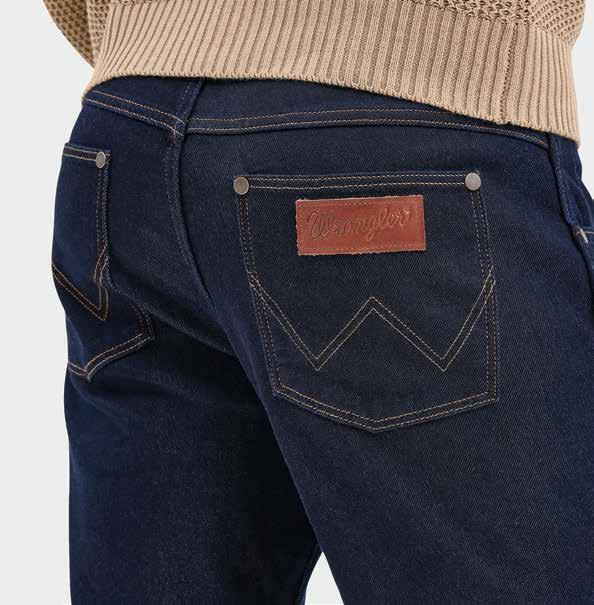
On fits and washes We’re seeing a strong move toward looser, more relaxed silhouettes. This season includes expanded baggy fits, updated Relaxed Straights with added volume, and more room in the thigh and rise for a better overall fit. A key addition is Big Guy XL, our widest silhouette yet, designed to offer more balance and comfort for larger builds. Long-line shorts are also gaining traction, hitting at the knee with a casual, easy shape.
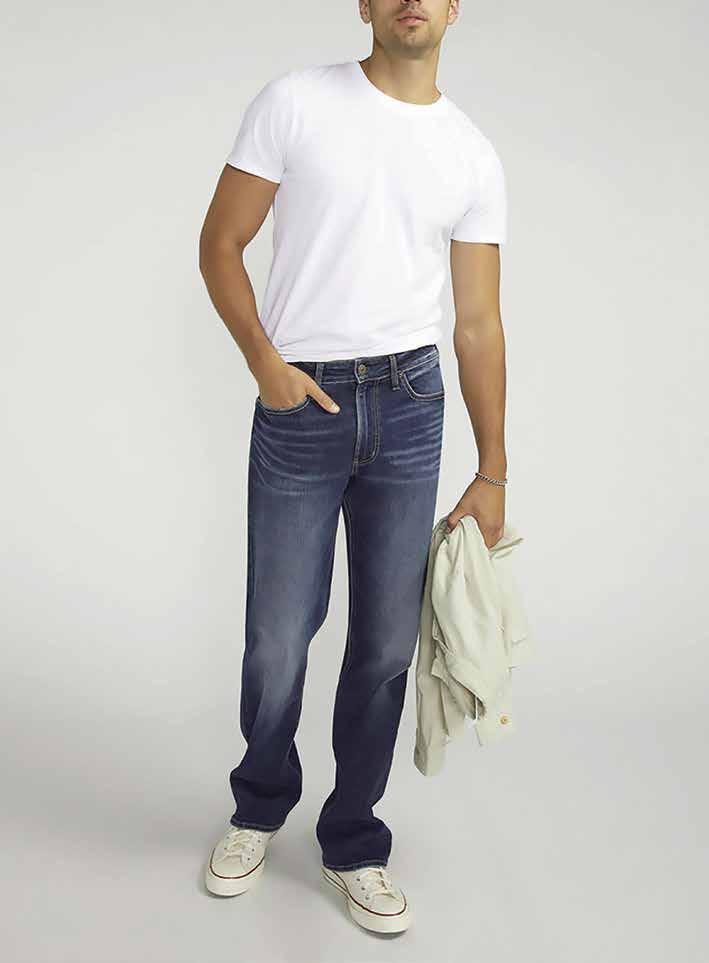
workwear styles and ultra-wide silhouettes has shown there’s demand for modern denim that’s built to fit real bodies, not just standard sizes. There’s also room to grow in lifestyle dressing. Men are looking for more than just jeans. They want well-made staples like denim jackets, longer shorts, and soft washed tops that add value to their everyday wardrobes.
Vivian Rivetti vice president of global design
On the men’s business: Wrangler has always found strength in its core male consumer, who loves our original Cowboy Cut jeans and some of our other more “traditional” denim offerings. However, we’ve also been able to tap into a newer, and generally younger, male consumer in the past few years thanks in part to the ongoing Western fashion trends. However, we as a brand don’t necessarily see this as a trend, but as something that led consumers to what are now closet staples, like a great pair of jeans.
Spring 2026 features a well-balanced mix of light, mid, and dark washes that tie back to the Coastal Roots theme. Light and sunfaded blues are a standout, with mid-blue shades washed down to feel worn-in and easygoing. We’ve also grounded the collection with deeper tones like clean dark rinses and vintage-fade indigos, which add range and versatility… New this season are washed-down greys, green-grey casts and soft neutrals. These colors layer easily and transition well between casual and more elevated looks.
• On non-jean denim styles We’ve been thinking a lot about how guys want to wear denim beyond just jeans. That shows up in a range of new styles for Spring 2026, starting with the Knit Flex Field Jacket. It’s structured like a classic denim jacket but made from our Knit Flex fabric, so it wears more like a hoodie: soft, flexible and easy to move in. It’s a perfect spring layer and now comes in a wider range of colors to make it even more versatile.
Denim shorts are also a key focus this season. We’ve leaned into longer inseams, wider leg openings and a relaxed, utilityinspired fit. The washes are sun-faded and broken-in, which ties into the laid-back feel of the collection. We’ve added more denim shirts and overshirts too.
• On inspiration The Coastal Roots theme was our starting point. We were drawn to that feeling of being near the water—unrushed, grounded and easy. That translated into denim that feels lived-in from the start, through soft abrasions, faded tones and washes with natural highs and lows.
We also pulled references from ’90s coastal skate and surf culture, especially in the looser fits and long-line shorts. It wasn’t about nostalgia but about bringing that relaxed energy into something wearable today. As always, the biggest inspiration comes from real life, what guys are reaching for and how they want to feel when they wear it.
• On opportunities We see opportunity in reaching more men with better fit solutions. Expanding our Big Guy assortment with new
• On non-jean denim styles: In S/S ’25, we saw a lot of interest in our flare and bootcut jeans, which we attributed partially to Kendrick Lamar wearing flare jeans during his Super Bowl Half Time Show. However, for S/S ’26, the straight leg and looser fits are having a comeback. To match demand, Wrangler will be offering a Greensboro Jean, a straight jean with a mid-rise waist, and a Straight Loose Jean. Lighter washes are on the rise for S/S ’26 and will continue into fall. Our Wrangler brighter blue cast of indigo, whether light, mid or dark wash, has been an ongoing desire for a few seasons already and is continuing. Medium to dark to even raw denim washes are also important to consumers, especially from an occasion perspective; we are seeing more and more denim being dressed up, and the darker washes are amazing for a clean look.
• On non-jean denim styles Thanks to the ongoing Western trend, head-to-toe denim looks or really any look that incorporates denim is popular, and we’re taking that into consideration for S/S ’26… Though our jeans are still our best-selling men’s category, we have seen a lot of interest in our other denim offerings the past few seasons. For example, we’ll have fun new denim overshirts in the spring lineup to offer consumers a variety of denim options.
• On inspiration Always authenticity! Staying true to who you are as a brand and delivering to the consumer what they never knew they wanted.
• On opportunities Though men have historically tended to stick with the style of denim they know, we’ve recently seen an openness to trying new cuts and washes. As a brand that always incorporates its triedand-true pieces as well as new looks into each collection, this is an opportunity for Wrangler to either introduce new consumers to our classic denim (like the Cowboy Cuts) or to get the more traditional Wrangler denim fans into our newer styles. But no matter which style a male consumer ultimately chooses, we still pride ourselves on making sure that all of our denim is approachable from a price perspective, as well as durable and comfortable.
by Alex Harrel
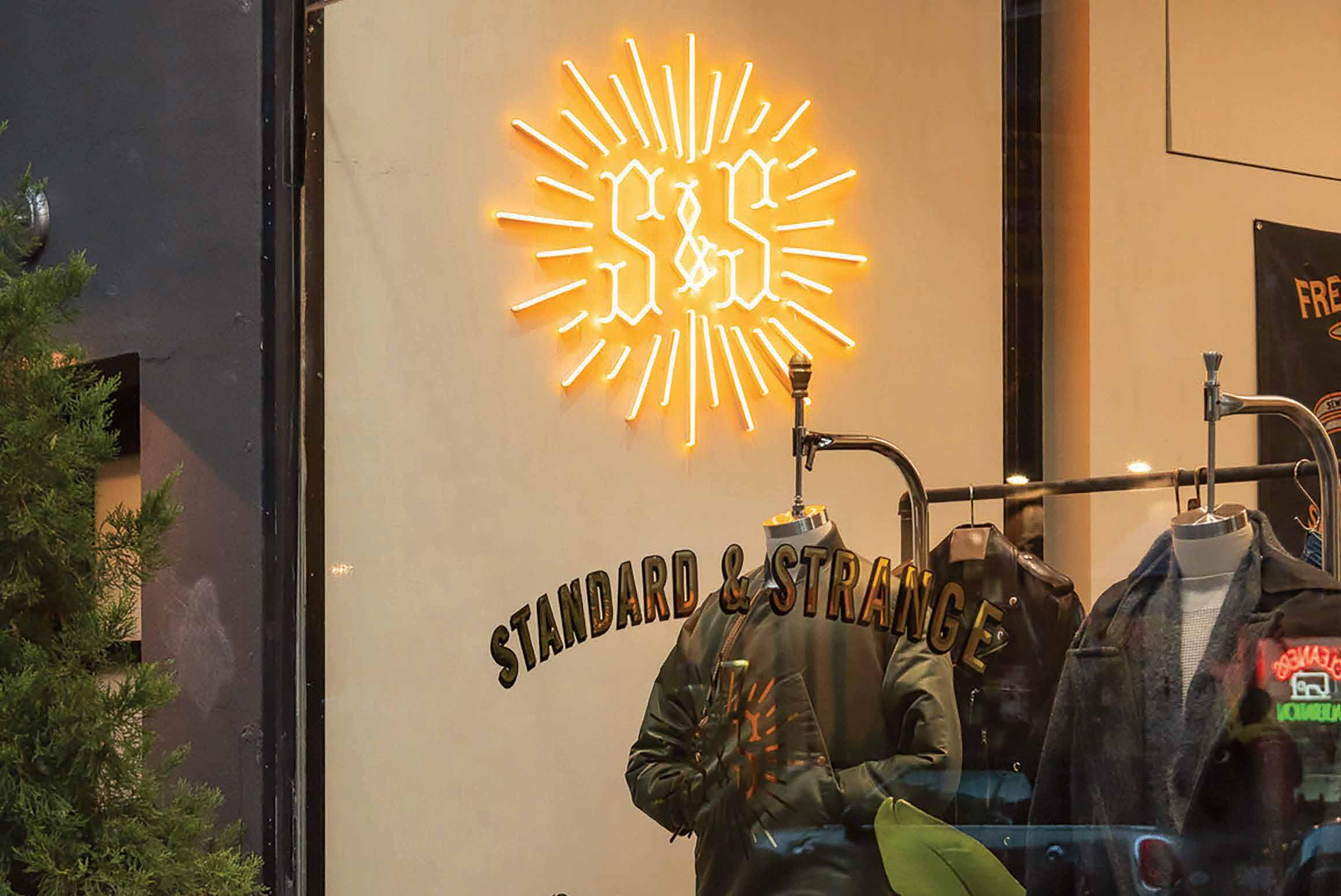
amassing a cult-like following requires cultivating cult-like logic, and at Standard & Strange (S&S), that logic applies to both the brands it carries and the customers it serves. c From a 200-square-foot stable in Oakland, Calif. to a trio of stores in Berkeley, Santa Fe and New York, the retailer has grown by upholding high standards on both sides of the counter—and across coasts. Brands must show commitment to craft and longevity before making it onto the shelves. Customers receive equally exacting service. c S&S began in 2012 on Oakland’s Temescal Alley, where Jeremy Smith and Neil Berrett were creating Cali-made merino wool jerseys. The two met through the Bay Area cycling scene. The partners positioned the shop, located in a rather hip district, as a hub for quality, made-in-America apparel—particularly for denim and heritage styles.


Berrett parted ways with the indie retailer earlier this year. Though the business has evolved, its mission remains unchanged. The once-small indie has grown into a bicoastal men’s wear destination, continuing its focus on USA-made goods and rare brands out of Japan and Europe.
“We have a number of criteria that all need to be met in order to carry a brand of denim,” Smith said. “At one point, we had around 50 choices for fit—probably 100 or more counting variations in denim per style.”
S&S follows a more pared-down strategy for merchandising nowadays. While S&S has tried to carry some big brands like RRL and Red Wing Heritage, the heritage powerhouses were never quite the right fit. “We need that personal relationship in order for the brand to succeed with the way we do business,” Smith said. “If we can’t sit down with the founder or owner and designers of a brand, it’s not for us.”
Also not for S&S? One-hit wonders.
“There are a number of brands out there that, for lack of better words, are rather cynical and opportunistic in their choice to make denim in our category,” Smith said. These are also the brands that tend to drop off, he added; another reason it’s never worth engaging. “We want to work with people who are dedicated to denim and willing to put in the years of work that it takes to make a truly great brand,” Smith said.
That’s also why onboarding brands need to offer something that S&S doesn’t already have.
“There are an infinite number of Japanese denim brands—and denim brands around the world all using Japanese denim,” Smith said. “Very few offer a unique perspective.”
Take, for example, the Vocalion from Black Sign. Made from 100 percent cotton, the highrise, wide, straight leg jean boasts finished seams and bar tacks. It’s one of Standard & Strange’s top-selling jeans. “It’s a unique silhouette while still being legible as a fivepocket,” Smith said. “It’s wide without being overwhelming and has a shape that will still be wearable even after the fashion pendulum swings back to skinny jeans.”

WE WANT TO WORK WITH PEOPLE WHO ARE DEDICATED TO DENIM…” Jeremy Smith
H Standard & Strange has stores in NYC, Berkeley and Santa Fe.
E Freenote Cloth is one of the store’s popular selvedge denim brands.
G OrSlow’s militaryinspired designs are always in demand.
Considering these “nice and hairy” 15-ounce Japanese selvedge jeans cost a cool $300, S&S requires excellence in fit, construction and materials. This is non-negotiable, per Smith, applicable regardless of price point.
“We have significant expertise across our team in denim; we can spot products that don’t meet our standards,” he said. “We also have in-house hands-on patterning and sewing knowledge, which further allows us to dig into how a pair of jeans is sewn.”
On that note, S&S provides hemming, tailoring and repairs for everything it sells. The retailer can renew almost any product it sells, too. As such, cultivating connections with players across the finish line (such as specialty leather shops and shoe cobblers) is of equal value—especially since most of those tweaks are made in-house.
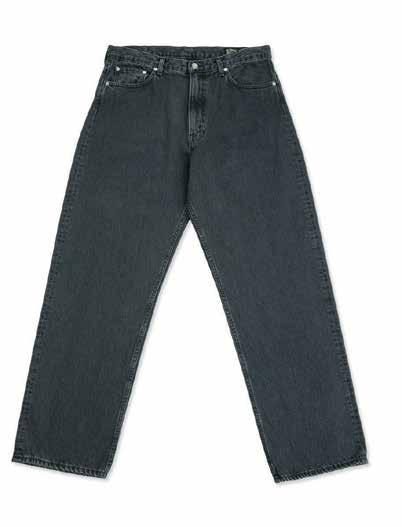
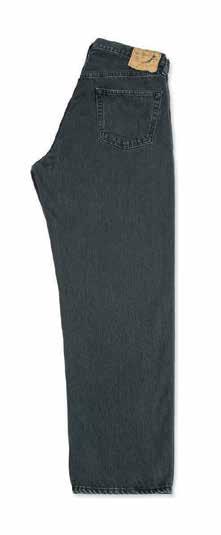
So, what is Standard & Strange’s unique selling point, exactly? Combining stellar service with deep product and brand knowledge, while selling rare and hard-to-find brands from around the world.
“Our commitment to customer service runs deep and starts long before we enter into a relationship with a customer,” Smith said. “For every product online, we photograph it, measure it—by hand, not AI tools— write accurate and complete copy about the garments, and provide fit advice.”
That knowledge is used in-store as well, with staff staying current on all offerings. As it stands, S&S employs 16 people across the three storefronts. The bicoastal company brings as many team members to meet brands worldwide as possible and vice versa, Smith said.
A low turnover rate means employees have opportunities to build personal relationships with clients. These days, those clients are interested in taking things slow. The company’s most popular wash is “Used Wash” from OrSlow. The Japanese label takes its name from designer Ichiro Nakatsu’s desire to make the opposite of fast fashion.
“We mostly sell raw or one-wash denim, because that’s what we specialize in; the few heavily washed styles we have sell out quickly, but we don’t invest heavily in that category to avoid being stuck with excess inventory when the trend toward washed denim ends,” Smith said.
Other popular brands include USAmanufactured Freenote Cloth and the aforementioned OrSlow for its militaryinspired Japanese workwear. For velocity, Ooe Yofukuten takes the cake; Smith said S&S typically sells an entire 80-pair delivery from the Ichinomiya, Japan-based husband-wife duo, within 20 minutes.
“Our current top selling fits are wider—but with a well-fitting waist, rather than an antifit streetwear aesthetic,” he added, noting demand for all fits due to the fragmentation of trends in recent years.
While specialized, S&S doesn’t have a single customer type and refrains from making assumptions based on who walks through the doors of its three stores. Granted, the merchandise is about 80 percent overlapped across the locations, with each assortment dialed in for the local customer base.
“Every time we think we’ve nailed our customer profile, we discover another one,” Smith said. “The only commonality is the appreciation and understanding of quality— whether expressed explicitly or implicitly.”
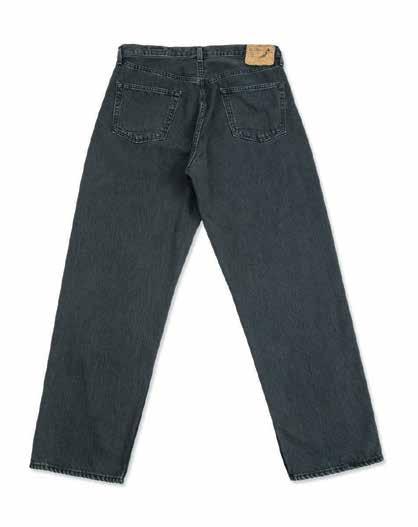
With DL1961, CEO Sarah Ahmed
shows that style doesn’t have to come at the expense of substance.
when dl1961 was founded by Faisal and Maliha Ahmed in 2008, they weren’t just thinking about denim—they were thinking about the future. Backed by decades of expertise in fabric development from Artistic Denim Mills, the family’s mill in Karachi, Pakistan, the New York City-based women’s, men’s and children’s premium brand was uniquely positioned to rethink how jeans could be designed, produced and worn. c At the helm of the brand is Sarah Ahmed, DL1961 CEO and the daughter of Faisal and Maliha. Through innovative waterless treatments, circular fibers and a growing range of elevated, non-denim essentials, Ahmed—with the continued support of her family—is shaping a future where cuttingedge sustainability meets modern design. c In this conversation, Ahmed speaks with SJ Denim about how DL1961’s vertical integration and multi-generational insight contribute to a business that is as transparent and responsible as it is agile and trendsetting.
Take us back to 2008.
What inspiredthe launch of DL1961, and what gap in the denim market were you aiming to fill?
Sarah Ahmed: When we launched in 2008, the denim market was crowded, but most brands were relying on outdated, unsustainable manufacturing practices and producing jeans that either looked great but weren’t comfortable or were comfortable but didn’t hold their shape. We saw a clear opportunity to create premium denim that combined fashion and function—using innovation in fiber and fabric technology to design jeans that fit well, feel incredible, and are made responsibly.
How has your vision for the brand evolved since its launch?
SA: In the beginning, our focus was on making technically advanced jeans that solved fit issues. Over time, that vision has expanded to building a sustainable, vertically integrated essentials brand that challenges the fashion industry’s broken systems. Today, DL1961 is not just about great-fitting denim—it’s about creating a more responsible model for how clothes are made, from fiber to finished garment, while continuing to innovate in design and category expansion.
Can you walk us through what vertical integration looks like at DL1961—from raw fiber to finished product?
SA: All of our denim—from fiber to finished garment—is manufactured in our familyowned factory. We own and operate every step of the process, starting with spinning certified sustainable fibers into yarn, weaving them into fabrics, and cutting and sewing the final garments. Along the way,
by Angela Velasquez

we use advanced water recycling systems, solar-powered facilities, and state-of-theart finishing technologies that dramatically reduce water chemical use.
By overseeing the full supply chain, we’re able to prioritize traceable, scalable practices that minimize environmental impact without ever compromising on quality. Vertical integration also allows us to continually invest in new sustainable technologies and audit at each stage for accountability. And as we’ve expanded beyond denim, we’ve built a network of like-minded, highly vetted partners to produce the industry-leading knits and wovens that round out our wardrobe essentials.
How does DL1961’s vertical setup benefit the business?
SA: It gives us stability, agility and sustainability. Because we manage our own supply chain, we can better control costs, avoid many of the disruptions that impact brands reliant on third parties, and protect our margins even in volatile markets. It also allows us to scale innovations quickly—for example, implementing water recycling across facilities or developing proprietary fabric blends. And most importantly, it lets us stay true to our sustainability commitments because we aren’t outsourcing critical processes.
Have recent tariff policies impacted your sourcing or pricing strategy, and how has vertical integration helped buffer those effects?


SA: Tariff shifts always impact the industry, and we are no exception, but our vertical model does help insulate us to a degree.
DL1961 continues to expand into new categories. What’s your strategy for product expansion? Which are proving to be successful?
SA: Our expansion strategy is driven by our customers—they look to us for high-quality, versatile wardrobe staples for every stage of life, so we’re building out adjacent categories that complement denim, like tailored separates, shirting, outerwear, and kidswear. Denim remains the core, but categories like jackets and elevated everyday essentials have been especially successful, since they align with how people are dressing today.
When working outside your vertical denim setup, what specific qualities do you look for in suppliers and factories?
SA: We look for partners that share our values around sustainability, transparency and innovation. And beyond that, they have to deliver the quality that our customer expects from us. We have an amazing team who sources and explores partnership with different factories. It takes lots of trial and error to find an optimal partner.
What are some consumer trends that are shaping the future of denim right now?
SA: We’re seeing two major shifts. First, consumers expect jeans to feel effortless. Comfort, all-day wear and versatility are non-negotiables—and they also want to know how their clothes are made. Traceability and responsibility have moved from “nice-to-have” to essential. On the style front, the market is broadening in exciting ways. Relaxed and baggier fits continue to resonate, but for Fall ’25 we’re also seeing a strong return to tailored wide-leg silhouettes with clean, elongating lines that balance ease with refinement. Barrel and curved shapes are gaining traction as well, offering a sculptural, fashion-forward update that still works for everyday wear. And interestingly, after several seasons of looser fits dominating, there’s renewed appetite for refined skinnies—sleek and streamlined styles that pair perfectly with staples like knee-high boots, structured outerwear, and oversized knits.
Over the years, DL1961 has worked with notable influencers and models, partnered with Frieze London and collaborated with other brands. What is the brand’s current marketing strategy? And what is proving to be the most effective way to connect with consumers?
SA: Our most effective strategy has always been rooted in authentic storytelling. Whether that’s through collaborations, cultural partnerships or digital campaigns, we focus on highlighting the innovation and intention behind each product. We’ve found that consumers connect most when they understand the “why” behind our collections—why a fit was designed the way it was, or why a certain sustainability initiative
NEVER UNDERESTIMATE THE IMPORTANCE OF SUPPLY CHAIN—HOW YOU MAKE SOMETHING IS JUST AS IMPORTANT AS WHAT YOU MAKE.” Sarah Ahmed, DL1961

matters. For the upcoming year, we’re focusing on partnering with talent that resonates with our audience and with collaborators that bring something fresh to our assortment, while still speaking to our core customer. We have a well-rounded mix of marketing efforts lined up for the next year and we can’t wait for everyone to see them roll out.
What’s one piece of advice you’dgive to someone looking to build a fashion brand today?
SA: Start with your values and build around them. The market is too saturated to succeed with product alone—you need a clear purpose that resonates with consumers and guides your decision-making as you scale. And never underestimate the importance of supply chain—how you make something is just as important as what you make.
Where do you see DL1961 in the next five to 10 years?
SA: We’ll continue to push the boundaries of what sustainable fashion can look like. That means expanding globally, growing our lifestyle categories, and investing in new technologies that make production even more efficient and responsible. Ultimately, my vision is for DL1961 to be a leader not just in denim, but in reimagining how the entire fashion ecosystem operates. Beyond that, we’re excited to see DL1961 continue to evolve as a lifestyle brand, entering new categories that fulfill a need for our customer.
Do you have a favorite pair of DL1961 jeans—and what makes them special to you?
SA: Right now, I’m living in our Kaylen High Rise wide-leg. It’s polished enough to dress up, relaxed enough for every day, and really captures the balance we always strive for: timeless style, modern comfort, and sustainable design. When I’m looking for something a little more polished and elevated, I reach for our Kristy High Rise.
What’s the story behind DL1961’s name?
SA: “DL” stands for Denim Limited, and “1961” is the year my father was born. We’re a family business through and through, and there’s always a funny story behind every decision. My mom came up with the idea for Denim Limited, then when my dad went to register the name, he added 1961. Plus, it adds up to 8 in numerology, which means infinity. Very apt for a sustainable company aiming for circularity.
In what ways is DL1961 still a family business?
SA: DL1961 is very much a family business, and that spirit of family is embedded in everything we do. Over the years, we’ve expanded and brought in other company leaders, but my parents and I still work together every day to run the company. I have two siblings who are involved in the business as well, so there really isn’t much of a separation between our family life and our professional lives. My father built the foundation of our manufacturing business more than three decades ago, specializing in innovative denim fabrics made with stateof-the-art, sustainable processes. Today, I lead DL1961 along with my mother, and we continue to make decisions together with the same long-term, values-driven approach. That heritage allows us to combine decades of technical expertise with a forward-looking mindset—delivering jeans that embody the perfect fabric, fi t, and function while using significantly less water, dyes, and energy than traditional denim. For us, it’s never been about building for the next season—it’s about building for the next generation.
From home goods to beauty, denim brands are diversifying their offerings to meet consumer demand and drive new revenue.
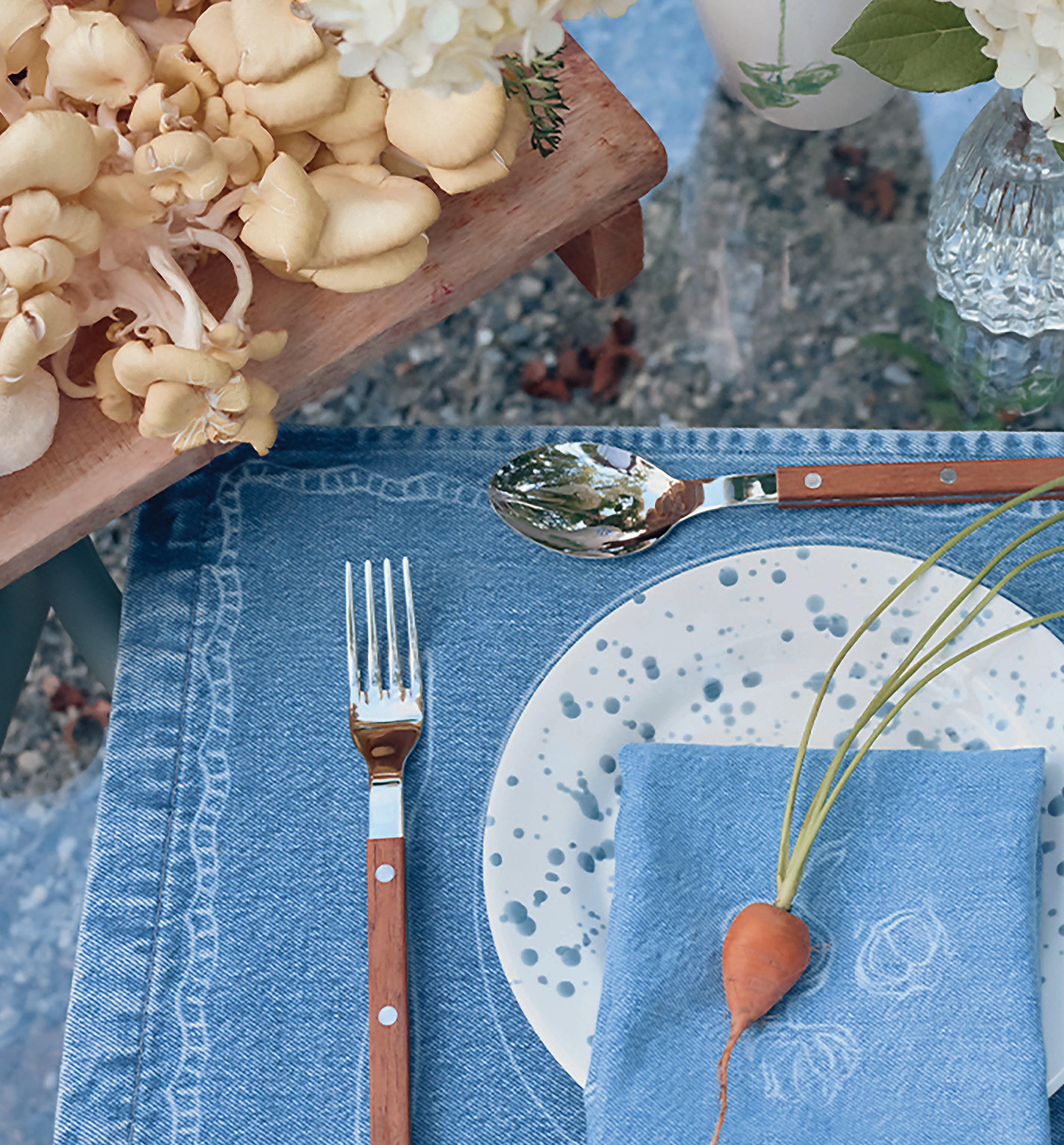
by Andre Claudio

despite consumers becoming more cautious with spending and rising production costs squeezing profit margins, denim brands have emerged as one of the few players still showing growth.
Levi Strauss & Co. had a strong start to the year with net revenues up 3 percent on a reported basis and 9 percent on an organic basis compared to the first quarter of the year. The Levi’s brand alone posted an 8 percent increase in organic global sales.
Wrangler also notched gains, with global revenue up 3 percent to $420 million, while Gap Inc. saw a 2 percent rise in both net and comparable sales, totaling $3.46 billion in the first quarter of fiscal 2025.
The momentum isn’t limited to a handful of players either. The global jeans market is projected to reach roughly $91.2 billion this year, with steady growth expected in the years ahead, according to the Denim Jeans Market trends analysis report.
So, with denim showing no signs of slowing down, what factors are fueling its resilience in a market where most categories are losing steam?
Well, according to Greg Petro, CEO of First Insight, the denim players seeing the strongest momentum are the ones expanding their offerings and services beyond jeans.
“What we’re seeing isn’t just diversification for revenue’s sake—it’s about loyalty, frequency, relevancy and pulling the next generation into the brand,” Petro told SJ Denim. “Denim is often a seasonal or twice-ayear purchase, but categories like beauty and accessories are bought far more frequently and are generally considered lower risk. If retailers can get a shopper to add a fragrance, mini lip gloss or travel spray while they’re buying jeans, you’ve grown both the trip frequency and the basket size.”
For Citizens of Humanity, product expansion was an opportunity for the Los Angeles-based brand to bring its regenerative agriculture story into home goods. In August, the brand partnered with Moda Operandi to launch an exclusive line of denim placemats, napkins, coasters a farmer’s market tote and apron.
A press trip last year to Bloom Farm, a 300-year-old property in Pennsylvania’s Oley Valley, hosted by Citizens of Humanity, inspired the collection.
Licensing deals are another way that denim brands are extending their reach into new categories.
Wrangler offering everything from blankets and pillows to sheets, luggage, duffel bags, knives, lunch boxes and more through licensing partnerships. By diversifying into these categories, the brand is strengthening its position as what Douglas Parker, director of licensing at Wrangler, calls a “360 lifestyle brand—one that builds the kind of loyalty that can last generations.”
“The ‘Wrangler way of life’ isn’t just about what you wear; it’s a mindset rooted
in authenticity, comfort and durability,” Parker told SJ Denim. “By offering products like bedding and home décor, we’re not just selling a blanket or a pillowcase. We’re providing a way for our loyal fans to infuse their homes with the same heritage and quality they trust in our denim. It’s about taking the feeling of a well-worn pair of Wrangler jeans and extending that comfort into the most personal spaces of their lives.”
WITHit.
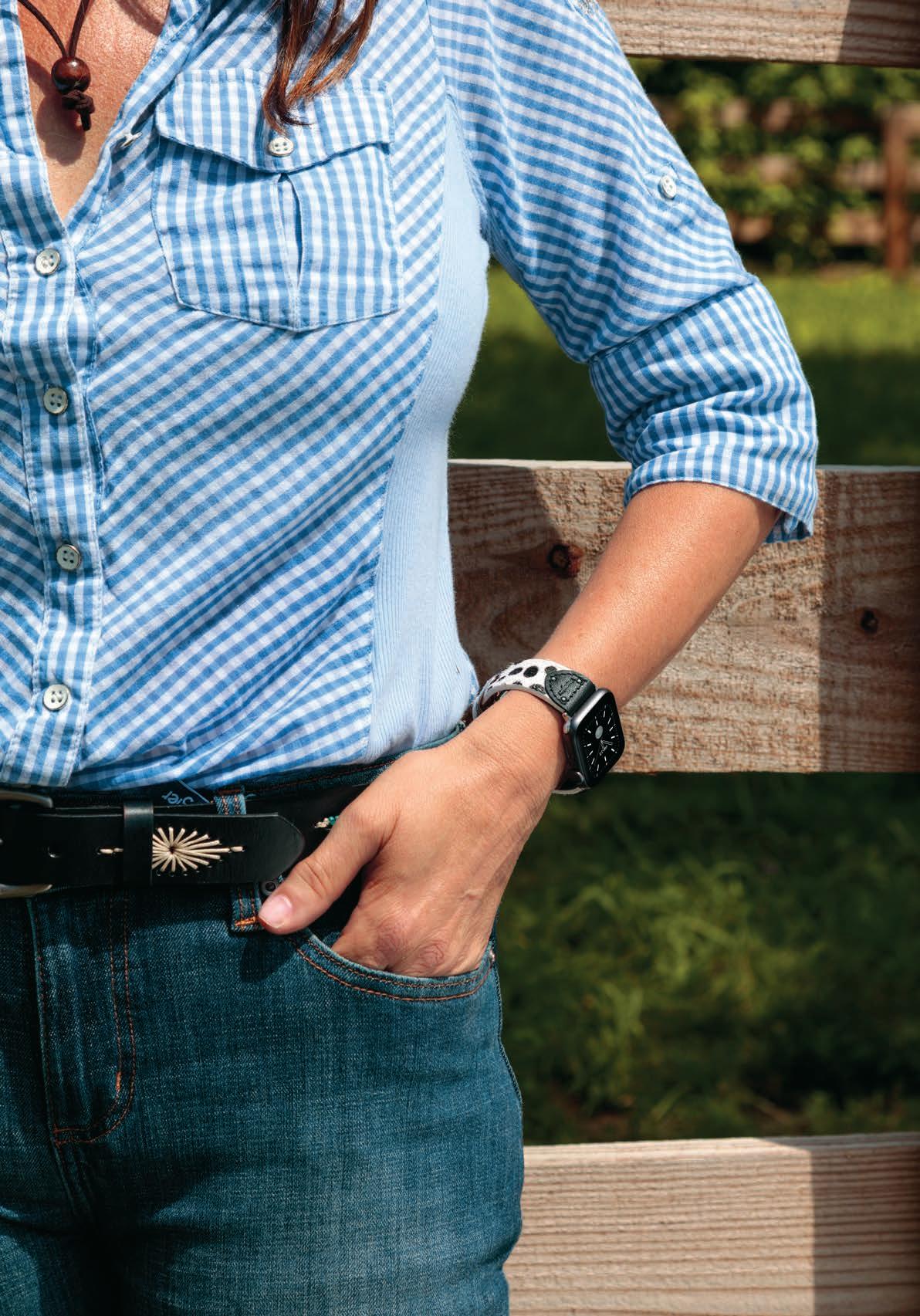
The Kontoor Brands-owned label recently partnered with companies like tech accessories company, WITHit, to launch Apple Watch bands and phone cases.
“This expansion is about creating new touchpoints for consumers and deepening their emotional connection to the brand,”
Joe Broyles, vice president of collaborations at Wrangler, told SJ Denim. “When a customer can find a Wrangler-branded product in multiple areas of their life…it reinforces the idea that Wrangler is a trusted companion for any adventure [and] turns a product purchase into a brand relationship.”
Broyles added that Wrangler is “Essentially transitioning from a brand people wear to a brand people live. This strategic expansion allows us to extend our brand equity and connect with consumers in a way that goes far beyond a single pair of jeans, building a more expansive and enduring legacy for the next 75 years.”
The strategy has also paid off for partners. WITHit calls its licensing deal with Wrangler a “pivotal moment for the business.”
“rigorous, multi-stage approval process” to ensure every licensed product upholds the brand’s quality and design standards.
Beyond revenue, the company also measures success through social engagement, repeat purchases and cross-category shopping— whether that’s a customer who first encounters Wrangler through a collaboration and later returns for denim or home goods.
“For us, a strong licensing partnership isn’t just a business transaction; it’s a deep, strategic connection. The most important factor is finding a partner who truly understands and respects the brand’s core values,” Parker said. “It’s not about slapping a logo on a product—it’s about ensuring the licensee shares our commitment to quality, authenticity and the ‘Wrangler way of life.’ We look for partners who can translate the rugged durability and timeless style of our denim into their own categories, whether that’s footwear, home goods or other lifestyle items.”
Lee is also expanding reach through new licensing deals.
Last year, the Kontoor Brands-owned U.S. heritage brand announced that it entered a licensing agreement with U.S. footwear manufacturer, wholesaler and retailer Jack Schwartz Shoes, marking the first major expansion into footwear for the brand.
While the line hasn’t officially launched yet, Steve Armus, Kontoor’s vice president of global licensing and collaborations, said it focuses on contemporary takes on athletic and casual styles including a classic court sneaker, basketball and skate-inspired designs, a casual comfort/city sneaker and a heritage lace-up boot inspired by ’90s footwear. He added that each style balances style and value, offering a variety of options for our customers.
“Our partners align with our commitment to quality and craftsmanship and appreciate the heritage that Lee has. They understand our target audience, and how the brand is evolving through our new creative vision and the global ‘Built Like Lee’ campaign,” Armus said. “[Like Lee], Jack Schwartz Shoes has
WHAT WE’RE SEEING ISN’T JUST DIVERSIFICATION FOR REVENUE’S SAKE— IT’S ABOUT LOYALTY, FREQUENCY, RELEVANCY AND PULLING THE NEXT GENERATION INTO THE BRAND.” Greg Petro, First Insight
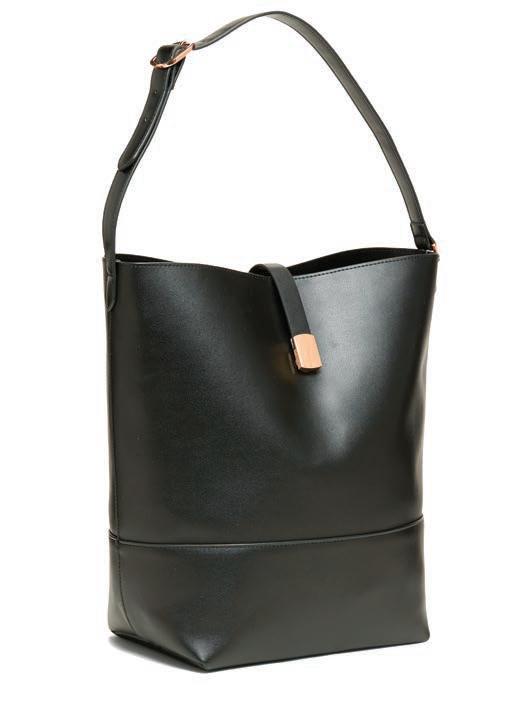
“[Wrangler] embodies a legacy of authenticity, craftsmanship and durability that has resonated with generations of consumers,” said Bill Devaney, chief operating officer and co-founder of WITHit. “By extending their influence into wearable technology accessories, we’re giving consumers the chance to experience the brands they know and love in fresh and relevant ways.”
Expansion comes with a cautious approach. According to Parker, Wrangler uses a
a long-standing heritage and is an expert in this industry. They understand how to create quality products that provide value.”
Furthering its commitment to outfitting customers beyond denim, Lee has also branched into home goods and travel accessories, including luggage. Most of its accessories today—including socks, belts, wallets and hats, to name a few—are designed to complement its mainline collections, according to Armus, and are distributed both through Lee.com and mid-tier or value retailers.
“It’s important to understand our target audience and what they want,” Armus said. “Our global ‘Built Like Lee’ campaign is grounded in research on today’s denim enthusiasts and how they’re discovering Lee.”
Other denim players are taking a different route, moving into entirely new markets like beauty, which is projected to surpass $100 billion in revenue this year, according to Euromonitor.
Just last month, Gap Inc. announced its expansion into beauty and accessories, calling it a way to reinforce [its] commitment to
becoming a high-performing house of “iconic American brands that shape culture.”
Gap’s entry will begin with a “test-andlearn” rollout at Old Navy this fall, including curated assortments of beauty and personal care products in 150 stores. Select locations will feature dedicated shop-in-shops staffed by Beauty Associates. By 2026, Gap plans to scale the business within Old Navy while introducing “brand-right” beauty concepts across its broader portfolio, the brand noted.
The company will also merchandise its private-label products alongside established names like e.l.f. and Mario Badescu—a move analysts say can help build shopper trust.
“When a private-label line sits next to established names, it gives shoppers permission to believe the quality is there,” Petro said. “But credibility alone isn’t enough—discovery has to feel easy and low-risk. That’s why trial sizes, bundles and introductory offers are so effective; they make it simple for shoppers to experiment. And when those products are tied to the core shopping mission—offered as an add-on to apparel or accessories—it builds trial, bigger baskets and loyalty across categories.”
On top of beauty, Old Navy reintroduced its handbag range—the brand’s most cohesive lineup to date. Spanning three collections, the bags offer refined materials, clean lines and thoughtful utility details.
“We drew inspiration from beloved designer styles, but made each piece uniquely Old Navy, creating a cohesive assortment that can’t be found anywhere else. Our goal was to create durable bags designed for every moment in life—all at an accessible price point that delivers incredible value,” said Zac Posen, Old Navy chief creative officer.
While expanding into new categories seems to be paying off for Kontoor and Gap Inc., not every apparel brand will be successful.
In fact, nearly 80 percent of new products fail, Petro noted, often because retailers lean too heavily on instinct or chase fleeting trends. The rare successes, he added, are the brands that bring customers into the process from the very beginning.
“Retailers must ask consumers what feels authentic, test concepts and validate pricing and positioning. When customers and artificial intelligence [AI] are part of the process, the odds of success rise dramatically,” Petro said.
“Expanding into new categories is not just about adding more stock keeping units [SKU]— it’s about extending a brand’s identity in a way that feels natural to the customer. The retailers that succeed will be the ones with a strong community, a clear lifestyle point of view and the discipline to execute consistently.”
Success will also hinge on how well brands connect with the next generation of shoppers.
Petro noted that younger consumers— specifically Gen Z, with an estimated global spending power of more than $450 billion in 2024, and Gen Alpha, whose annual direct spending power topped $100 billion by mid-2025, according to Statista—see brands as more than just product providers. To them, Petro said, brands function as cultural markers.
“Gen Z and now Gen Alpha expect the brands they trust to extend naturally into other parts of their lives, and they’re quick to reward those that feel authentic in doing so,” Petro added. “That means loyalty isn’t tied to a single category, but to whether a brand reflects their lifestyle and values—a much higher bar, and one that only a handful of apparel players are likely to clear.”


Vintage festivals and markets are more than just shopping events—

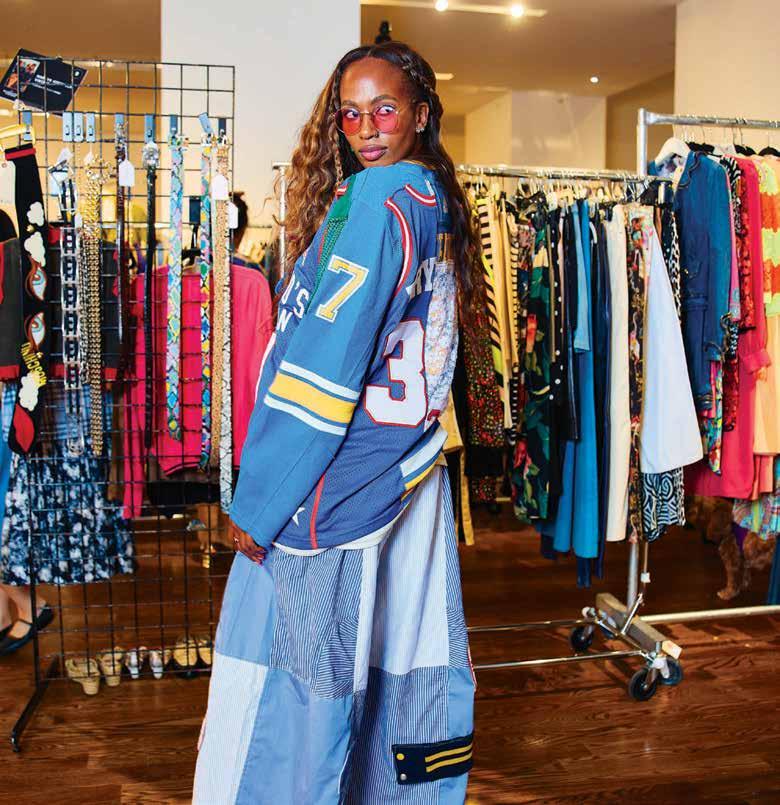
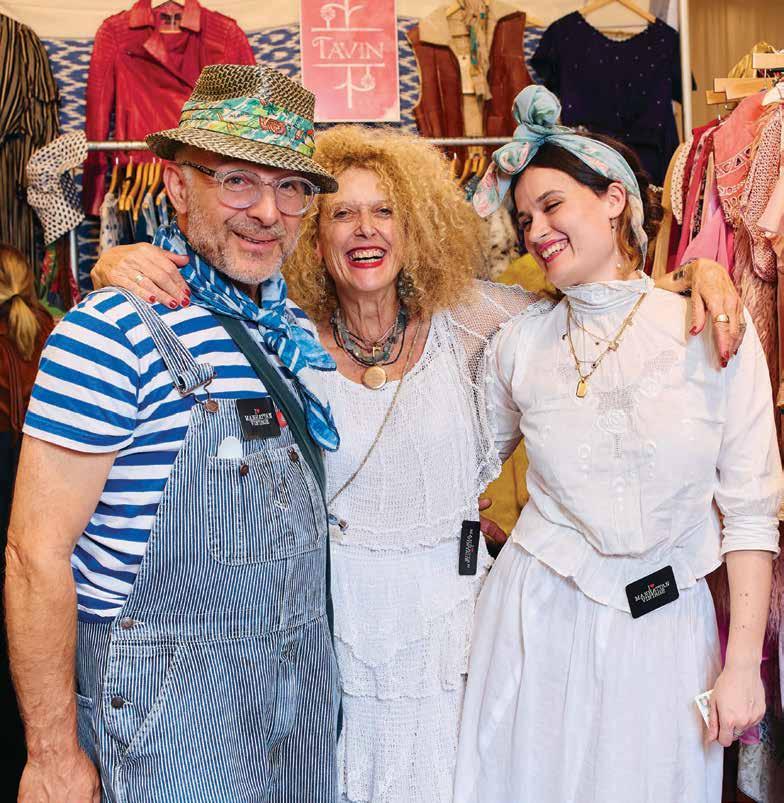
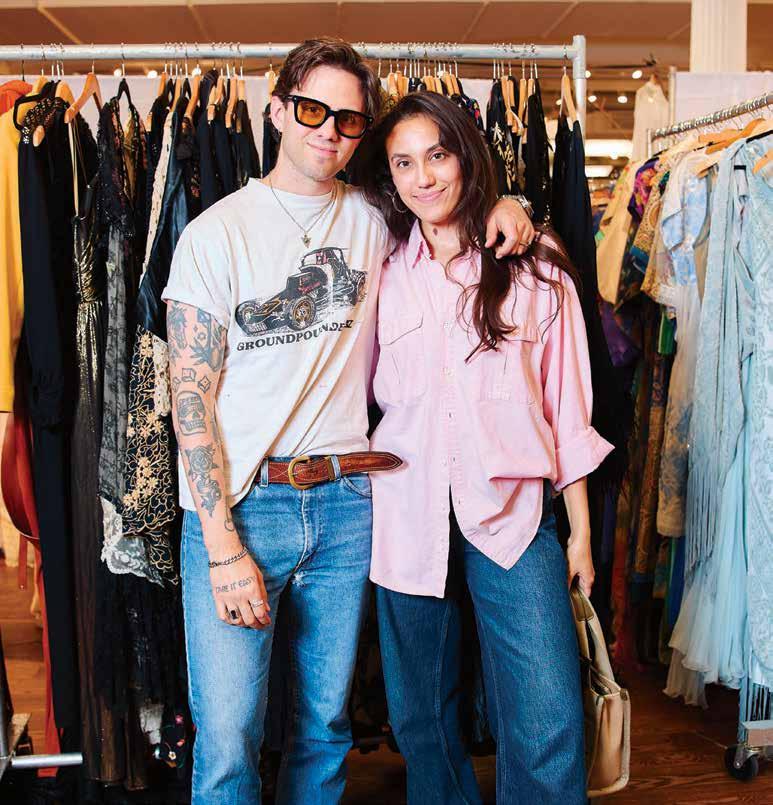
they’re spaces where sustainability, community and creativity intersect.

once a niche pursuit for collectors and creative outliers, vintage fashion has exploded into the mainstream— driven by new festivals and markets that showcase secondhand style and promote sustainable consumption. c Beloved events like Brimfield Antique Flea Market, —a multi-day treasure hunt for antique fashion and furniture held in New England three times year— A Current Affair, which welcomes a wide cross-section of vintage vendors on the West and East Coast, and ThriftCon, the traveling exhibition of vendors specializing in ’70s to 2000s clothing and collectibles, have not only grown in popularity but also inspired a new host of events celebrating vintage culture, sustainable fashion, and niche collecting communities across the country.
Vintage has reached critical mass—perhaps even oversaturation—a shift that surprises some longtime dealers, according to Abe Lange, founder of Distressed Fest. “Vintage used to be this very eclectic, off-the-beatenpath interest like folk art and craft. And now we’re seeing young bro types who would have been into sneakers five or 10 years ago now getting into vintage,” he said.
This rise in vintage festivals reflects more than changing tastes—it signals a generational shift in shopping habits. Ryan Smith, founder of Pensacola Vintage Collective, said young consumers are turning away from mass retail in favor of peer-to-peer exchanges, where every seller and purchase tells a story.
As awareness of fast fashion’s environmental toll grows, it’s weighing more heavily on consumers—especially younger ones. With many sustainable brands priced out of reach, vintage shopping has become a popular, ecofriendly alternative. “Younger generations feel a moral responsibility,” said Sarah Frick, founder of Time Travelers Vintage Expo. “For them, supporting fast fashion or dismissing secondhand clothing is almost unthinkable.”
Expressing individuality through fashion is also more celebrated by younger people. Distressed Fest was born from Lange’s passion for vintage fashion, which began in his teenage years in North Carolina, and from a growing frustration with the sameness of the vintage festival circuit.
Determined to shake things up, the now 28-year-old, who also serves as a vintage clothing appraiser on PBS’s “Antiques Roadshow,” set out to create the kind of event he wanted to attend. At Distressed Fest, shoppers can find almost anything with “visible history” like patinas or repairs. Most pieces are from the 1940s to the 1980s, though there are some items from the 1890s that have come through.
Beyond denim, shoppers can find graphic tees, old sweatshirts and vintage French and European workwear—like canvas chore jackets and trousers splattered with paint. “Some vendors are super on-brand and sell exclusively this kind of stuff. And others will bring a curation of their distressed stuff, plus whatever flavor they can add to it,” he said.
What you won’t find at Distressed Fest is Y2K or ’90s band tees. While technically vintage because they’re over the 20-year mark, Lange said Distressed Fest “is a little bit more nuanced than that.”
Indeed, the vintage scene is splintering into two factions—an “old guard” focused on “true vintage” (typically pre-1975), and a newer wave embracing broader eras, including ’90s and 2000s fashion.
Distressed Fest debuted in Brooklyn in March 2024 with 10 curated exhibitors. Its success led to a fall expansion in Los Angeles with over 40 vendors. To support the West Coast edition, Lange partnered with local vintage dealer Connor Gressitt.
Since then, second editions have been held in both cities, with strong attendance and celebrity interest. Lange said vendors— including some from as far away as France—have praised the event’s gallerylike atmosphere and the engaged, thoughtful shoppers. Drawing musicians, visual artists and other creatives, Distressed Fest has a community-driven atmosphere, where vintage fans can geek out over pieces. “Our event is more tantamount to people who are leading an examined life and want something that’s meaningful to them and makes them happy to see,” he said.

Most of the aged garments at Distressed Fest fall short of traditional valuations and are less likely to have an established book value. “You can’t look up a completed eBay listing to see what it goes for. A lot relies on gut feeling and aesthetic sensibility from other things,” Lange said.
It’s a sharp contrast to the typical vintage market scene that he described. “A lot of shows have the same energy where people are running in, looking to find steals. They are primarily vintage dealers buying from other vintage dealers, which is both weird and a little incestuous and unsustainable,” he said.
Smith acknowledged that the vintage scene can be competitive, saying, “This is a very cannibalistic world.” But as a vendor at other events, he sees the benefits. “As the vendor, you don’t really mind,” he said, pointing out that at the last Pensacola Vintage Collective, some vendors made up to $1,000 just on setup day—selling exclusively to each other.
This peer-to-peer model benefits both parties, allowing sellers to offload inventory

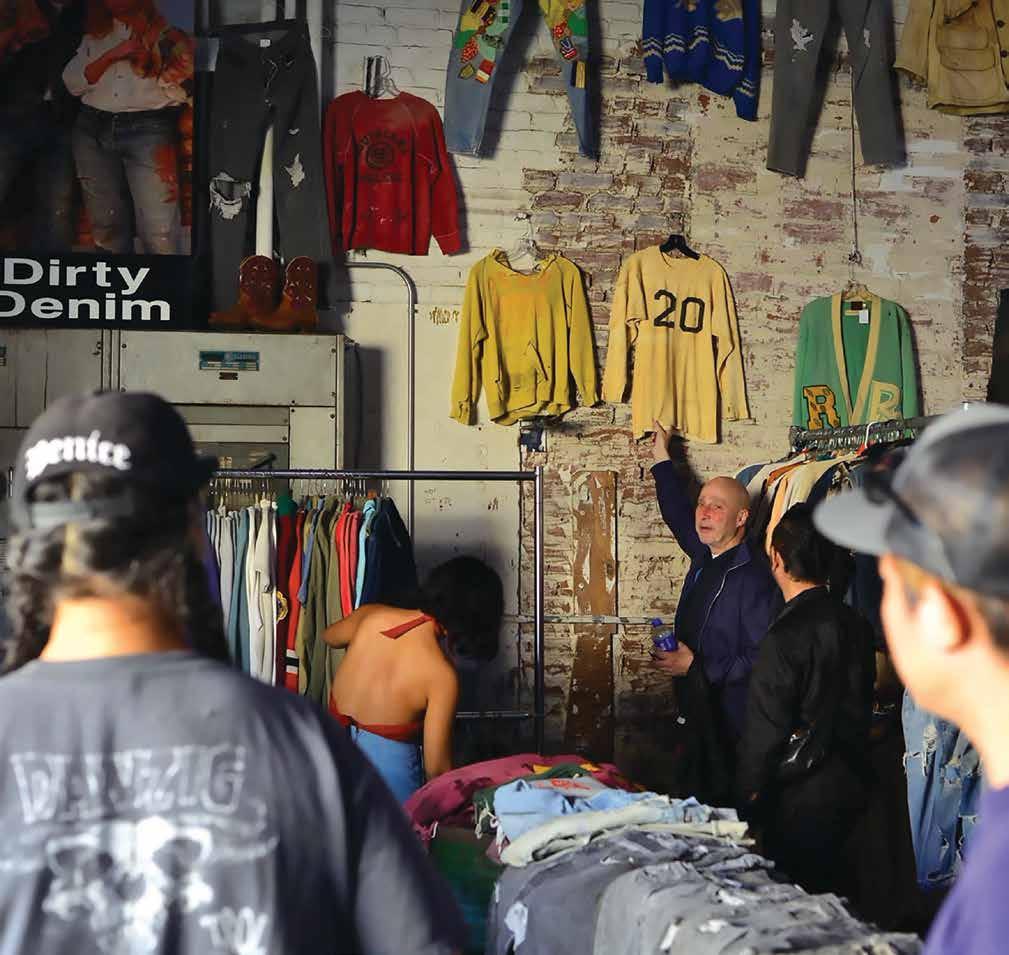
while ensuring items reach the right audience. For example, Y2K fashion like baby-doll tees and low-rise jeans is a hot commodity in Pensacola. The event draws a wide mix of vendors, from Western and rockabilly specialists to Levi’s collectors and T-shirt dealers. “Everyone gets to celebrate their niche passion. It’s like a walk down memory lane, even if you don’t buy anything,” Smith said.
Amy Abrams, founder of Shop Extraordinary Enterprises—the parent company of Artists & Fleas and Manhattan Vintage—is driven by the evolution of the vintage market. When she acquired Manhattan Vintage in 2021, a 25-yearold event held three times a year in New York City, she recognized its deep roots in the industry. “The previous owners were pioneers who really put it on the map,” she said.
Originally known as an insider event catering to stylists and collectors, Abrams saw an opportunity to broaden its reach. Her vision was to transform Manhattan Vintage into a retail experience that is accessible to a wider audience beyond just industry professionals. Rigid definitions of what qualifies as vintage can take the fun out of the hunt— and run counter to the spirit of conscious consumption. “I think any opportunity for people to wear and consume things that exist already is really positive,” Abrams said. That philosophy drives her inclusive approach to curating vintage—offering a wide range of eras, styles, and price points. “People respond to different things,” she explained, emphasizing that vintage means something different to everyone. “For some, having something that’s 50 years old is really important. For others, it’s just about finding something they absolutely love.” Her goal, she added, is to “invite everybody to the table who’s interested in buying things that exist already.”
Extending the flagship event from two days
IT’S LIKE A WALK DOWN MEMORY LANE, EVEN IF YOU DON’T BUY ANYTHING.”
E Distressed Fest draws collectors, artists, musicians
to three days and curating a wider variety of dealers—90 in total—has enhanced the Manhattan Vintage experience. Abrams has also introduced smaller pop-up events such as a denim edition in New York City and destination markets in the Hamptons and Austin, Texas.
“I think that vintage is the future of fashion. The more that people have access and opportunities to buy vintage, the better,” Abrams said, adding her goal is to grow the vintage community—not just by supporting our existing dealers who are eager to reach new cities, but also by bringing the unique Manhattan Vintage experience to new audiences across the country.
Smith, who also runs Obsolete Heat Vintage Clothing, launched the Pensacola Vintage Collective in July 2024 after years of hosting smaller markets. The first event featured 50 vendors. The second, held this summer, expanded to 75 and attracted nearly 3,000 attendees, with vendors traveling from cities like New Orleans, Atlanta, Nashville, and Mobile.
“Pensacola is not a particularly giant market, but, you know, the need is there,” Smith added.
While cities like New York and Los Angeles remain meccas for vintage, markets are trickling into mid-size cities and smaller ones.
Appealing to all ages with products that span decades, Time Travelers began in 2022 as a small local market held in the backyard
I WORRY ABOUT HOW LONG WE REALLY HAVE UNTIL THE GREAT STUFF BECOMES IMPOSSIBLE TO FIND.” Adam Irish, Threadbare Show

of a Tulsa bar. It now takes place across 16 cities in the Midwest and Southwest. “We call them the ‘underdog’ cities, where maybe they don’t have as much access to vintage stores, or they don’t have a very established vintage community. We always have done well in those cities because I think the people there are hungry for it,” Frick said.
While Frick said it varies by city, most Time Travelers events showcase an equal number of local businesses and vendors trying to reach new markets. “Every city we go to, we pick up new people on the caravan that start traveling with us, and we have seen growth every year,” she said.
Regional demand plays a big role—what sells in one city might be overlooked elsewhere. L.L. Bean staples may appeal to New Englanders but hold little sway in the South, where Nascar T-shirts are prized, Smith said. Team merchandise, too, fluctuates in value based on geography. “Some teams are so hot, they go for so much money. Then you go 500 miles down the road and nobody cares about it,” he said.
Lange pointed out that vintage, once resistant to fashion trends, is now seeing regionally distinct preferences emerge. In New York, demand is skewed toward sleek, wearable black fashion. On the West Coast, shoppers gravitate toward hippie and rockabilly styles, though graphic tees remain universally popular. Even international buyers are rethinking their approach. “It’s been fun to see the transition of how people think about [vintage],” he said, referencing how Tokyo-based dealers are now considering more tattered items once overlooked.
The Threadbare Show emerged from Adam Irish’s years vending at the Sturbridge Show. More of an antiquarian show for vintage clothing, antiques and textiles, Sturbridge drew an industry audience of dealers and fashion designers. However, the event has changed as the clientele for traditional antique textiles aged out.
To fill that void, Irish launched Threadbare in 2021. The market features vintage and antique textile dealers selling across categories—men’s and women’s vintage, early fabrics, quilts, advertising, and more. Held in Southbridge, Mass., just before Brimfield, it also travels to Brooklyn each June.
Vendors at Threadbare range widely, offering goods from the 19th century through the 1970s, with occasional ’90s “strays.”
“The thing about vintage is, it’s just a matter of time. Eventually, everything becomes true vintage,” Irish said.
Still, he stressed that older garments typically offer superior construction. “There’s a remarkable change in quality that occurs basically from the mid or early ’90s going forward. The quality of manufacturing is nothing like it once was,” he said. “Take a brand like Banana Republic, for example— what they produced in the ’80s and early ’90s is a completely different caliber of quality compared to what came later. It’s like comparing apples to oranges.”
While pieces like denim and workwear can last generations, not all Y2K items may stand the test of time. He added, “I worry about how long we really have until the great stuff becomes impossible to find.”
Despite clear divides between “true vintage” and newer interpretations, organizers share a purpose: to keep clothing in circulation and encourage conscious consumerism.
Frick envisions vintage festivals becoming key dates on the shopping calendar, much like the back-to-school season. “I would love to see people really save up and plan for these kinds of events so that they can do as much of their shopping secondhand as possible,” she said.
Irish is optimistic about the resurgence of vintage, especially as the older generations of antique dealers fade away. “I’m 39 and I would consider myself one of the oldest people in the room,” he said. “What’s exciting about the vintage clothing space is that there are so many young dealers interested in getting involved, and it’s a very vibrant market for younger folks.”
Festivals and markets are also economic lifelines for small businesses, many of which began during the pandemic when unemployment soared. Smith added that most vendors are one or two-people operations, and for many, vintage is their side hustle. And as Irish pointed out, these gatherings also double as networking spaces where new relationships form—and sometimes lead to collaborations with major designers.
At the heart of it all is a shared love for vintage and the community it fosters. “I’m just really happy that we’ve created this environment for vintage,” Lange said. “Connor and I both had a love for this stuff, not just when it was worth less, but when it was literally worthless. We were into it before it was good business, so it’s nice to see how it’s paid off.”
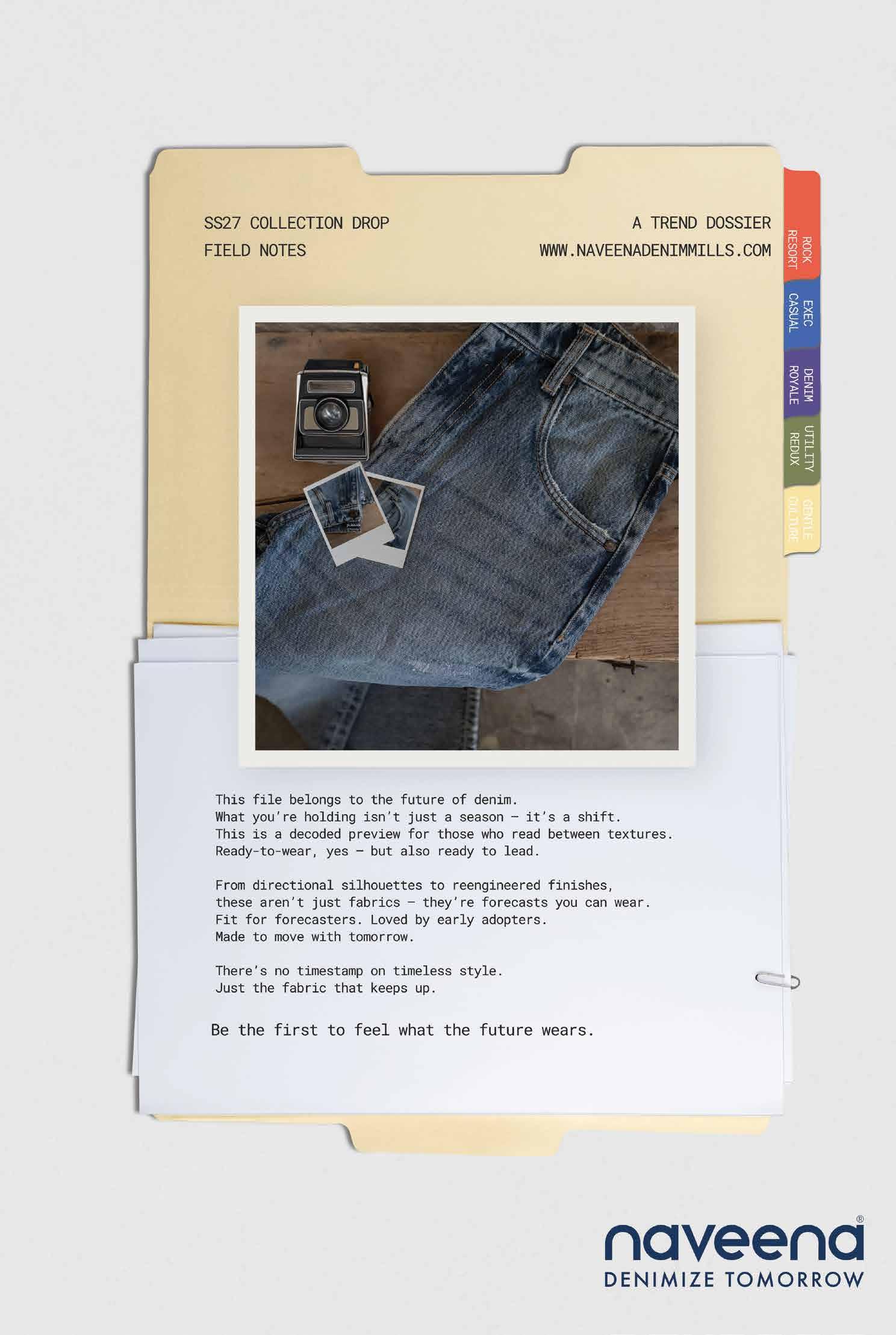

by Jessica Binns
along a quiet strip in kurashiki , Japan, known as Kojima Jeans Street, denim purists from around the world make their pilgrimage. It’s not just a shopping destination—it’s a living museum of Japanese craftsmanship, home to some of the finest selvedge denim in the world and city buses wrapped in Jeans Street branding. Yet, while the indigo-dyed legacy remains strong, Kojima’s denim culture is undergoing a transformation, shaped by shifting customer preferences, global demand, and the pressures of succession in a labor-intensive industry. c Once considered a niche destination for denim aficionados, Kojima is now enjoying a moment of renewed visibility. The coastal city, long known as the birthplace and bedrock of Japanese jeans, is churning out more denim than ever, thanks in part to the post-covid rise in e-commerce and international collaborations. But the real story lies in the streets: who’s keeping the legacy alive, what’s changing, and what Kojima’s future might look like.
Far from being a museum stuck in time, Kojima is experiencing a wave of fresh energy. In the past few years, several new brands have hung their shingle and opened storefronts, each with a slightly different take on what Japanese denim can be.
Tugg, for example, is just two years old. A store employee shared that the seller of jeans, overalls, skirts and more was born from a simple impulse: “We saw what was missing and decided to make it ourselves.” Their vision balances the respect for tradition with the desire to design something new. Though their clientele is still predominantly Japanese, the products are unisex, and shoppers are increasingly diverse.
Another newer label, Encrust, has operated a storefront for two years, though the brand it houses—Sasanqua by Trees—is now six years old. The shop features contemporary styles rooted in Japanese aesthetics, highlighting how even newer entrants nod to the signature visual language of Kojima denim while reaching for broader appeal.
Setto, a popular shop along Kojima Jeans Street, sees its highest foot traffic during Golden Week in May. It’s a pattern repeated among most of the local stores. “Golden Week brings a lot of visitors,” says a Setto store employee, noting that while international tourism is growing, most customers are still Japanese. “About 70 percent of our shoppers are local.”
This domestic focus, however, doesn’t mean Kojima isn’t attracting global interest. Setto’s customers are discerning—often on the hunt for pure selvedge denim, the kind that emphasizes durability, visible craftsmanship, and tradition over newer stretch or comfort blends. There’s a sense that people come here seeking the real thing, and the shops deliver.
One of the most promising additions is Omoto, a boutique and brand just ninemonths old. Despite its youth, Omoto is helmed by founder Kishimoto Hiroki, who brings two decades of experience in denim fabric development, including time with Japan Blue Jeans. The result is a line that feels deeply rooted in tradition yet timely in execution.

The name “Omoto” is inspired by the omoto plant, known for changing its appearance daily—mirroring the way denim evolves with wear. Like many Kojima brands, Omoto leans into unisex fits, though patterns are designed with the male form in mind. “Fit should be perfect, no matter your age or sex,” says Omoto employee Keita Hinamoto, highlighting the inclusive ethos behind the brand.
Omoto’s international ambitions are already coming to life. The brand recently finalized plans to wholesale at Standard & Strange in New York City, a SoHo boutique known for stocking Japanese brands. Participation in international trade shows has also unlocked opportunities
with European retailers. The brand’s global launch is paired with a recent push into crossborder e-commerce.
Yet, even with this outward gaze, Omoto maintains its commitment to traditional craftsmanship. Cotton is sourced from Texas (warp) and Zimbabwe (weft), each chosen for its unique character. Production is local within Okayama prefecture. Sustainability, in the Japanese spirit, is about making something that stands the test of time and is a cherished component of an individual’s wardrobe.
“The factory quality is the same as it’s always been,” says Hinamoto. “Foreigners are just discovering it now.”

Despite the seeming health of Kojima Jeans Street’s denim industry, a labor crisis is quietly simmering beneath the surface. Like many traditional industries in Japan denim is grappling with a serious shortage of successors. The craft, once passed down through generations, is now facing the reality that fewer young people—seduced by highflying, big-city office jobs—are interested in toiling in its timeworn factories. The industry is undeniably admired globally for its heritage and quality, but that admiration doesn’t always translate into a desire to join the ranks of the artisans who create the denim.
As the average age of skilled denim artisans continues to rise, the industry faces an impending crisis. With veteran craftsmen hanging up their tools in retirement, more and more factories are being forced to shutter their looms. It is estimated that in recent years, between 10 to 20 factories have shut down due to aging ownership and a dearth of successors to take the reins and write the next chapter.
With an eye to the trials and tribulations facing the Kojima denim community, Omoto’s Hinamoto describes this shortage of newgeneration workers as one of the biggest challenges currently plaguing the region’s denim industry. “Like many traditional local industries in Japan, the denim industry is facing a serious shortage of successors,” Hinamoto explains. However, he also believes that the global recognition of Japanese denim could be the key to reversing this trend.
“As Japanese denim gains more recognition around the world, it helps raise awareness and appreciation here at home,” he notes. This increased visibility not only promotes the craft abroad but also creates an opportunity to inspire the next wave of artisans who might otherwise overlook this profession.
Despite the challenges, there are signs of hope. In nearby Ibara—just an hour’s drive from Kojima—denim-related industries continue to thrive. Ibara plays a pivotal role in the supply chain, producing much of the fabric that shows up as finished goods displayed in the shiny store windows on Kojima Jeans Street. While Kojima itself is renowned for its cut-and-sew expertise, Ibara’s contribution is essential to keeping
the textile side of the business humming.
Occasionally, new energy is injected into the scene as enterprising individuals revive dormant factories, breathing new life into the old spaces that once powered the industry.
While this rejuvenation offers some hope, it doesn’t solve the larger issue of attracting young blood into the workforce.
Hinamoto is keenly aware of the importance of continuing the tradition of Japanese denim, not just in terms of production but as an integral part of Japan’s cultural heritage.
“That’s why Omoto Denim is committed to sharing this industry—with its global recognition—with the world,” he explains.
“We see this as part of Japan’s cultural heritage, and we’re leading the way in keeping it alive for the future.”
Hinamoto credits the legacy of Kojima’s denim industry to its craftsmen—those who tirelessly protect the quality and spirit of “Made in Japan” every single day. “Some have over 50 years of experience, while others are in their twenties, learning the craft from the ground up,” he says.
“There’s nothing flashy about what they do— but they find joy and meaning in working with their hands and take real pride in their work.
It’s their quiet dedication that continues to
shape the denim and jeans culture of Kojima, and of Japan as a whole.” This dedication is, according to Hinamoto, the lifeblood of the industry—the uncelebrated workers whose craftsmanship ensures the survival and global reverence of Japanese denim.
The challenge remains: how to convince young people not just to love denim but to make it. Kojima’s denim industry is at a crossroads, where the love for its heritage and the desire to preserve it must meet the need for new generations to step in and carry the torch forward. Without the next generation of artisans, the industry may struggle to maintain its global stature and remain a beacon of Japan’s unique cultural craftsmanship.
Recognizing the need to protect and elevate Kojima’s unique role in the global denim landscape, the Kojima Jeans Street Cooperative has become an increasingly active force. It designated Oct. 26 as “Denim Day”—a celebration of the region’s deeprooted denim culture. While the day has yet to reach its full potential as a promotional platform, plans are underway to build an event around it, further positioning Kojima as Japan’s sacred ground for denim.
The cooperative believes it has earned credit for safeguarding Kojima’s traditions, helping ensure that the spirit of Japanese denim continues to evolve rather than fade. As they point out, while global denim has a history of around 130 years, domestic Japanese production—including Kojima’s contribution—spans just six decades.
Although it’s impossible to close the historical gap entirely, Kojima has carved out a distinct, respected niche within an international denim landscape dominated by stretch-blend fabrics and the constant churn that comes with chasing trends.
For brands that join the cooperative, the perks go beyond a logo on a flyer or a name on a shared email blast. There’s a real ecosystem at work here—cross-brand collaborations that actually mean something, doors opening to sales channels they didn’t know existed, and introductions that spark product ideas they wouldn’t have dreamed up solo. There’s also practical muscle behind the scenes: support from the local Chamber of Commerce that

helps brands navigate everything from financing options to tax breaks and regional subsidies. But make no mistake—this isn’t just about logistics. Kojima’s edge—its aura—has always been about something deeper. This place was built on reclaimed land and relentless effort, where cotton fields first took root during Japan’s Edo period. Out of that fertile history grew a vibrant textile legacy that today lives on through denim. The jeans made here aren’t just good—they’re soulful. Woven with a kind of muscle memory passed down through generations, they carry the weight of craftsmanship you can see and feel. That’s the power of Kojima: it’s not just making denim, it’s making history wearable.
FOOT TRAFFIC REBOUNDS AS KOJIMA REEMERGES
Kojima is having a moment—and the foot traffic proves it. Before the pandemic, around 250,000 people made the denim pilgrimage to Kojima Jeans Street each year. That number dipped to 150,000 during the height of covid, as restrictions limited visitor flow—but by 2022, the crowds were creeping back. And now? Visitor numbers are once again brushing up against that 250,000 mark, right where they left off in 2019.
What’s driving the comeback isn’t just denim diehards. International tourists are ditching the cookie-cutter sightseeing traps and hunting down places with soul—spots that feel lived-in, local, and layered with meaning. Kojima checks all the boxes: history, heritage, industry, and street-level fashion culture you can see, touch, and shop.
For years, the unassuming hub—where even ice cream gets a denim-colored makeover— largely flew under the radar. But lately, some smart marketing and broader outreach have started to shift the spotlight. And there’s more momentum on the way. Kojima sits in prime position to ride the wave of the Setouchi Triennale, a boundary-pushing art festival that hits the islands of the Seto Inland Sea every three years. It draws an international crowd of curious, culture-seeking travelers—the kind of people who geek out over slow-made jeans and the stories behind them. That crowd is exactly who Kojima was made for.
In the West, sustainability tends to be all charts and carbon audits—numbers, metrics, lifecycle breakdowns. In Kojima, it hits closer to home. Here, sustainability is tactile. Personal. It’s about honoring what’s already in front of you. Take Webber, for example—a scrappy, five-year-old label that’s quietly redefining what “made from waste” can look like. They scoop up leftover factory scraps— odds and ends that might otherwise get tossed—and rework them into pieces that are cool, intentional, and wildly wearable.
The price point doesn’t hurt either. Webber sells at around half what you’d pay at neighboring stores, making it a magnet for younger shoppers—designcurious, budget-aware, and hungry for something with story and soul.
“Japanese shoppers really appreciate the beauty and cost-efficiency of upcycled fashion,” says a Webber employee. It’s a natural extension of the Japanese principle of mottainai, the philosophy of not wasting what still retains value.
Other brands, like Edge of Line, have been
flying the flag for playful innovation long before it became a marketing buzzword. The 13-year-old label leans into the offbeat while staying rooted in craft—case in point: a full line of pet denim launched five years ago. It sounds quirky (because it is), but it’s also a clever, on-brand way of expanding what Kojima denim can be—and nods to Japan’s passion for pets. It’s proof that tradition and experimentation aren’t opposites here— they’re co-conspirat ors.
Inside the shop, Miwa Tanaka, who’s worked the floor for years, says the flow of foot traffic
Keita Hinamoto, Omoto

still pulses with seasonality. New Year’s and Obon in August are high tides, when loyal regulars and curious newcomers flood in, reminding her that denim in Kojima isn’t just heritage—it’s habit.
TOURISM RETURNS, INTERNATIONAL CURIOSITY GROWS
Since the pandemic, international tourism in Kojima hasn’t just bounced back—it’s leveled up. At Mayuka, staff say the surge in foreign visitors is outpacing even pre-covid highs, and the boost in foot traffic is showing up on the sales floor. What’s drawing them in? The same thing that’s always made Kojima special: craftsmanship you can see, authenticity you can feel. It’s not just window-shopping— curiosity here often turns into checkout bags.
Over at Flui, a boutique that blends silver accessories with denim from neighboring Ibara, the vibe is less tourist trap, more treasure hunt. Everything’s handmade, locally rooted, and built to last—souvenirs with soul. And then there’s Ritawco, a fresh face on the scene. The brand is helmed by Tatsuya Kowatari, who spent years sewing in the shadows of the industry before flipping the script to launch his own label. It’s classic Kojima: artisans stepping into the spotlight, rewriting what denim retail can look like. Even the heavy hitters are pushing their boundaries. Momotaro, arguably Kojima’s most globally recognized name, is shaking things up with elevated drops like silk denim and cashmere denim—heritage silhouettes cut from fabrics that whisper luxury. The lines
E
stepping into wholesale and crossborder e-commerce.
remain mostly unisex, though the aesthetic still skews slightly masculine, a tip of the hat to the brand’s roots. But the direction is clear: even icons aren’t standing still.
There’s a quiet reverence that reverberates in Kojima—a feeling that denim here isn’t just made, it’s lived. It’s ritual, it’s rhythm. But this isn’t a museum of indigo past. New voices are adding layers. A wave of younger designers, shop owners, and customers is reshaping the landscape—bringing with them a mindset rooted in sustainability, inclusivity, and a global point of view.
You see it in the thoughtful scraps-to-style creations at Webber, in the artisan accessories at Flui, in the understated precision of Omoto. These brands aren’t breaking from tradition— they’re remixing it, thread by thread, adding new chapters to an already rich story. Of course, challenges persist. Labor shortages and succession gaps loom large. But talk to the locals and the vibe isn’t one of decline—it’s quiet confidence. “Kojima’s denim market is getting better, not worse,” says one shop owner, standing beneath shelves stacked with selvedge and soft light. You can feel that belief in the Golden Week buzz, in the openings of new storefronts, in the uptick in curious travelers from across the globe. Kojima isn’t just holding on—it’s evolving with intention. Anchored by craft, lifted by vision, it offers more than just jeans. It offers proof that when heritage meets heart, the result is something timeless.
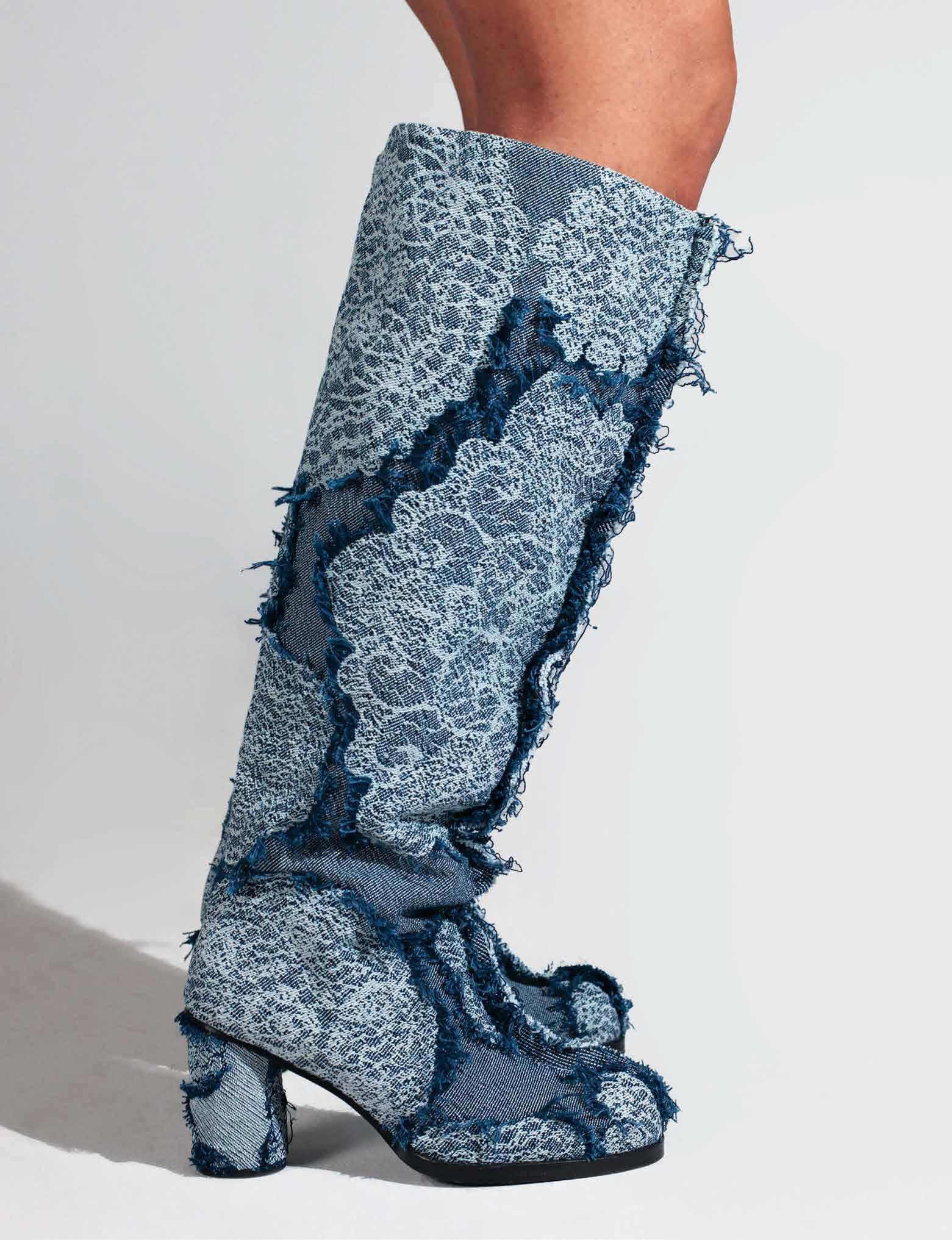
Mills are weaving magic with jacquard denim. by Angela Velasquez

it’s a key fabric in Glenn Martens’ arsenal as he continually redefines Diesel’s denim collections season after season. Etro often uses the technique to tell its lush botanical stories. It fits right in with Versace’s baroque-style motifs, and it has been one of the most coveted and commercial highlights in Louis Vuitton Men’s collections since cultural curator Pharrell Williams took the helm as creative director last summer. c All of fashion’s cool kids are exploring the possibilities of jacquard denim. c Over the past few seasons, trend forecasting firm WGSN has observed an increase in detailed patterns, including distressed and eroded textures, historical florals and damask patterns, geometric quilting and double cloths. “Brands are enriching their collections as jacquard designs move from niche markets to the mainstream, showcasing strong growth potential,” said Nicole Ajimal, WGSN’s fabric and sourcing strategist.
Jacquard denim is a woven fabric that has detailed patterns made directly during the weaving process, not printed or embroidered later, explained Işıl Sena Candan, export sales chief for Kilim Denim. “It’s made on jacquard looms, which control each warp yarn separately. This allows us to create patterns like logos, textures or designs directly into the fabric while still keeping the strength and look of real denim,” she said.
Advance Denim is seeing demand for jacquard grow. “We have had an increased number of requests for jacquard development over the past two to three years. This is mainly due to the resurgence of jacquards in runway shows,” said Mark Ix, director of North America marketing for Advance Denim, adding that the mill has been producing custom jacquard patterns for Vivian Tam’s collections for the past four years.
At Denim Première Vision in May, Kelly Konings, a Swedish textile designer specializing in jacquard weaving and finished product weaving, partnered with Italian fabric manufacturer Gommatex to showcase jacquard denim as a wearable art form.
Inspired by traditional “female craft practices,” the collection of tops, bottoms, dresses and footwear used cutting-edge 3D technology to pay homage to artisan traditions.
“As a textile designer, I have always regarded textiles as a narrative of culture, locality, and craftsmanship. Jacquard weaving, with its capability to produce intricate, expressive patterns within the structure of the textile itself, presents an especially rich language of tactile storytelling,” Konings said.
Beyond aesthetic reasons, jacquard aligns with wider narratives in the denim industry. Allowing for visual and textural expressions that go beyond surface embellishment, aligns with a broader industry movement towards craft-informed innovation, Konings said. Additionally, the durability and design-intrinsic nature of jacquard reduce the need for postproduction finishes, which can help reduce a garment’s overall environmental footprint.
“Weaving enables the design to be integrated structurally rather than superficially. This reduces the need for additional dyeing, printing, or embroidery processes, which are often chemically and labor-intensive,” she said. “In essence, jacquard allows for ‘design into the fabric,’ minimizing post-production steps. Also, jacquard weaving can be used to upcycle or recontextualize waste yarns or deadstock.”
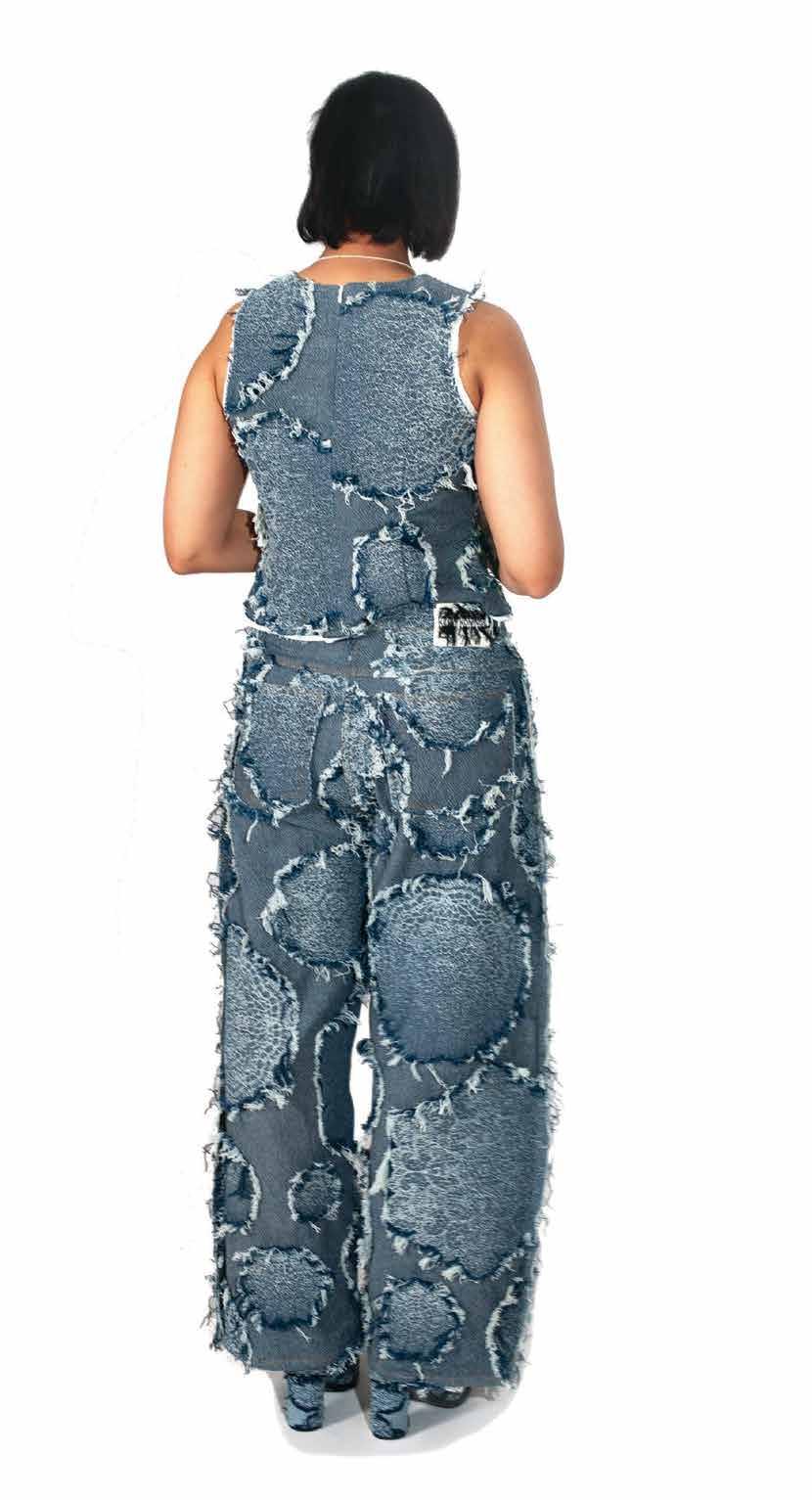
Jacquard weaving has come a long way from its 18th century roots to make opulent French brocade and damask textiles. Today, mills use digital programming to lift individual warp threads, enabling for complex patterns.
Mills are getting increasingly creative with jacquard denim, using the technique not only for intricate patterns but also to add dimension and texture, according to Manon Mangin, Première Vision’s fashion product manager.
Denim weavers have adapted the technique to suit the fabric’s complex finishing process and consumers’ needs. Notable approaches include combining jacquard weaving with stretch yarns to create both visual complexity and comfort, Mangin said. Some mills are also using tonal or reverse effects within the weave structure to simulate vintage or wornin looks without additional washes.
“Certain finishes, especially those that highlight surface relief and color contrast can enhance the dimensionality of jacquard patterns. These techniques reveal the structural interplay between warp and weft, creating a kind of visual archaeology of the woven structure,” Konings added.
In terms of finishing technologies, said Mangin laser finishing is often applied to enhance or distress jacquard patterns, adding a layered aesthetic. Ozone and e-flow treatments are also being used to soften jacquard denim and give it a more natural, sustainable finish.
“It is completely possible to make sustainable jacquard denim, and this fits very well with the growing need for eco-friendly solutions in fashion,” Sena Candan said, noting the mill already uses organic or recycled cotton and environmentally friendly dyeing and finishing methods for its jacquard fabrics.
The technique also aligns with the industry’s efforts to reduce waste. Ajimal noted that a benefit of jacquard is efficient use of materials, particularly with innovative woven 3D zero-waste garment constructions.
While laser technology has revolutionized denim printing and made printed denim more accessible and mainstream, jacquard weaving offers a distinctly elevated, premium alternative—delivering intricate patterns with depth, texture, and timeless craftsmanship that printing simply can’t replicate.

The weaving technique enables creative storytelling brought to life through statement pieces, capsule collections, and collaborations with artisans or artists—breathing new life into this traditionally durable workwear fabric, Ajimal said.
Building on that creative potential, Mangin emphasized jacquard’s ability to elevate denim to a new level: “Jacquard is a unique way to stand out in an increasingly saturated denim market. As consumers seek more individuality and storytelling in their garments, jacquard allows for intricate, woven-in designs that go beyond traditional prints or surface treatments. It fills a gap between basics and overly decorative pieces—offering depth, craftsmanship, and subtle luxury.”
On a macro level, she said the interest in jacquard aligns with broader trends around texture, tactility, and heritage-inspired design. “There’s a clear shift toward garments that feel more artisanal and expressive, without compromising comfort or wearability,” she said.
Paolo Gnutti, creative director for Isko Luxury by PG, agrees, adding that it’s clear jacquard is becoming a key player in the evolution of modern denim design. “With jacquard, we’re no longer working with just a fabric—we’re working with texture, depth, and storytelling. It allows denim brands to go beyond traditional limits and design pieces that feel luxurious, personal, and truly unique,” he said.
From clean geometric patterns to individualistic elements like lettering, logos, and custom messages, the weaving technique is a key component to the storytelling of his premium collections with Isko. Season after season, he sees designers drawn to the unique possibilities the textile has to offer. “What makes jacquard so special is that it allows for personalization and customization to begin right at the weaving stage. This opens incredible creative freedom, as the fabric itself becomes a medium of expression from the very moment it’s placed on the loom,” Gnutti said.
Advance Denim creates jacquard styles to customers specifications, modifying weight, shade and weave to incorporate their own design or branding. Ix pointed out there can be multiple weave constructions within the same style depending on the pattern. Jacquard has opened endless possibilities for denim
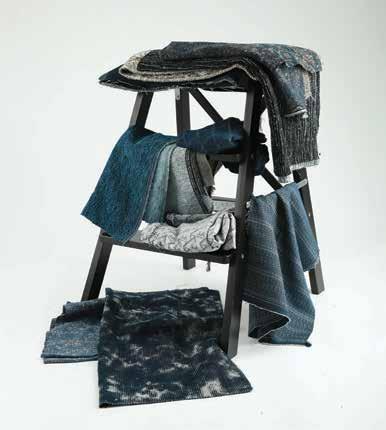
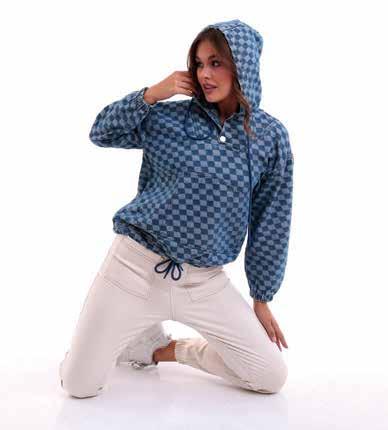
designers to customize weaves with detailed patterns and even pictures. “Each jacquard pattern tends to be personal to the designer or brand,” he said.
Both high-end and modern fashion brands are showing interest in jacquard—especially those who like storytelling, customization, and bold pieces, Sena Candan said, noting that jacquard is often used for outerwear, statement jeans, jackets, and sometimes in accessories.
“We also see more brands using it in capsule collections or limited editions,” she added.
Nature-inspired designs like flowers and leaves are in demand from Kilim’s clients.
Abstract and geometric shapes are also trending. She noted many brands are also using logos or monograms in the fabric, to
make their identity part of the design. Vintage and cultural themes are also trending.
Developing jacquard denim often requires more time and collaboration than traditional denim, with a longer lead time and deeper involvement from the design team to ensure their vision is fully realized, Ix explained.
At Kilim, the process begins with a creative discussion, followed by technical development tailored specifically for the jacquard loom. Sena Candan said the mill works closely with designers to ensure the pattern translates beautifully onto the fabric.
“Once the design is approved, production time is similar to other special fabrics, but it needs more planning at the start,” she noted.
This is especially true for custom jacquards.
“We do our best to give fast service. We prepare trial samples in about two weeks and send them to our customers as sample meters or hangers,” Sena Candan added. “A big advantage is that we don’t require a minimum order quantity.”
The cost difference between standard denim and jacquard denim can be significant, largely due to differences in production complexity, machinery, and time, Gnutti said. Whereas standard denim is typically woven in a simple twill structure and is
WHAT MAKES JACQUARD SO SPECIAL IS THAT IT ALLOWS FOR PERSONALIZATION AND CUSTOMIZATION TO BEGIN RIGHT AT THE WEAVING STAGE.”
E Jacquard and animal prints resonate with Isko Luxury by PG’s trend-forward clients.
H Advance Denim has seen an uptick of jacquard denim on the runway.
G Kilim Denim works with brands to develop custom designs.
relatively fast and cost-effective to produce, especially at scale, the process to make jacquard denim is slower and requires more advanced programming and setup. This not only increases production time but also raises labor and maintenance costs, he said.
On average, Gnutti said jacquard denim can cost 30 percent to 100 percent more per meter than standard denim, depending on the complexity of the design, yarn composition and the scale of production.
While standard denim might cost around 3 to 7 euros per meter, jacquard denim can range from 6 to 15 euro or more per meter. Ultimately, he said jacquard is seen as a premium fabric, used for adding uniqueness and luxury to denim collections.
“Jacquard denim is certainly more prevalent in certain categories, particularly in premium and designer segments where craftsmanship, innovation, and storytelling are key value drivers. The technique’s complexity and production costs often position it at a higher price point, making it more common in statement pieces, limited editions, or seasonal capsules,” Mangin said. Despite the higher production costs, many brands are increasingly willing to invest in jacquard for its visual impact, storytelling potential, and ability to stand out, said Sena Candan.
Although jacquard remains a niche compared to traditional denim, Kilim sees rapid growth ahead.
“Jacquard gives brands a special way to tell stories or show their identity through the fabric itself,” she said, adding it opens up a wide range of design possibilities and creates a more unique, elevated look—something that’s increasingly valuable in today’s competitive fashion market.
Source: Cotton
2) Source: Marielis C. Zambrano
on

(2021).
p. 112030. https://doi.org/10.1016/j.marpolbul.2021.112030.
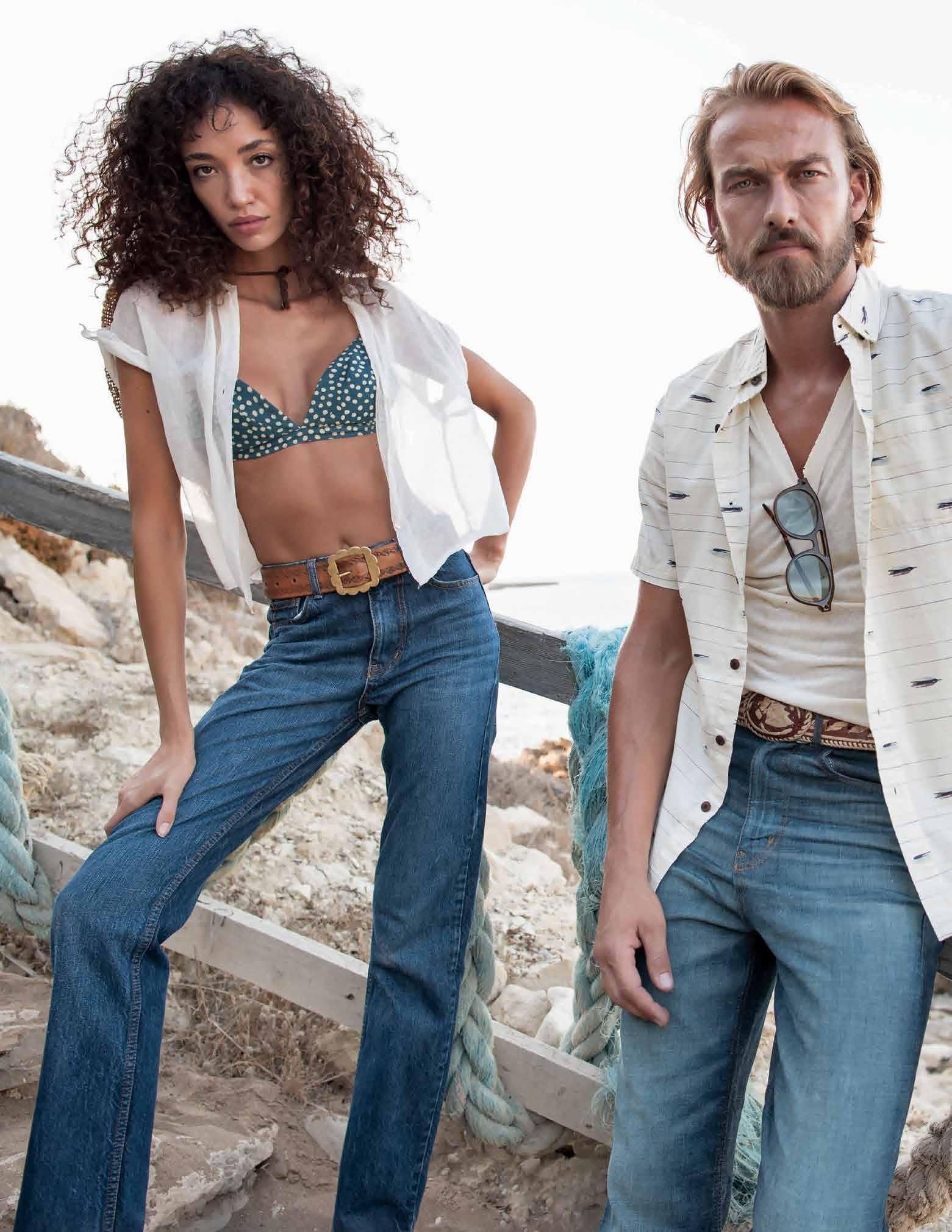

Even in the face of financial constraints and market volatility, sustainability remains a strategic priority for many companies in the denim supply chain.
by Angela Velasquez
having weathered economic recessions, the rise of athleisure, and the Covid-19 pandemic, the denim supply chain remains committed to the sustainability initiatives it has spent years and millions investing in—with no intention of throw in the towel. Economic uncertainty and global trade disruptions continue to strain corporate budgets—and sustainability efforts are feeling the pressure. But rather than abandoning their goals, many companies are simply recalibrating.
Companies in the denim supply chain are not seeing sustainability projects scrapped. Instead, brands and manufacturers are becoming more selective—targeting initiatives that deliver the biggest environmental impact and the strongest business value.
“Sustainability is no longer a nice to have; it’s a business imperative especially with the in-coming legislation, and that mindset is helping to buffer against short-term economic turbulence,” said Barbara Oswald, Bluesign chief commercial officer.
At the same time, suppliers accustomed to competing on volume rather than value are feeling the squeeze. In contrast, companies that have embedded sustainability into both their business model and brand ethos may be better positioned to navigate the pressure.
“We recognize today’s constant instability,” said Eda Dikmen, Soorty’s senior marketing and communications manager. “The level of economic, climate and political concerns cannot be neglected, and neither can the growing demand for ‘more for less.’ And this is exactly why we don’t approach sustainability as a choice but rather keep it central to our strategy.”

This is a pivotal moment for mills to remain steadfast in their sustainability strategies. “Sustainability is not a peripheral goal for us; it’s a core part of who we are. In the face of adversity, we move forward with clarity, resilience, and purpose,” said Abdul Jabbar Athar, US Group’s director of projects and sustainability.
That shift in mindset is echoed across the supply chain. “Ultimately, we believe that by prioritizing transparency, scalability, and circularity, companies can stay on track with their sustainability goals while building resilience and cost-efficiency for the long term,” said Alfredo Ferre, Recover chief product, innovation and sustainability officer.
That’s not to say that sustaining momentum hasn’t become more challenging—even when sustainability is built into the DNA of companies. To stay on course, Lahore, Pakistan-based US Group is streamlining operations, prioritizing high-impact initiatives and fostering deeper collaboration across teams and suppliers, according to Jabbar
DESPITE THIS UNCERTAINTY, WE HAVE STAYED TRUE TO OUR SUSTAINABILITY INITIATIVES BECAUSE WE BELIEVE IT IS THE CLEAREST ROUTE TO LONGTERM SUCCESS.” Jimmy Summers, Cone Denim
Athar. “While financial discipline is essential, we continue to invest where it matters most. “Our customers still expect responsible leadership, and we remain committed to delivering it,” he said.
As a supplier, Cone Denim’s chief sustainability officer Jimmy Summers said it is imperative to shift quickly with changes in the market and our customers’ requests. “Despite this uncertainty, we have stayed true to our sustainability initiatives because we believe it is the clearest route to long-term success. No matter how regulations ebb and flow, we have seen that consumers are consistently demanding more sustainable products, and that is what we will continue to deliver,” he said. Maintaining consistent investment is difficult, especially as clients pivot away from
experimental technologies, according to Sundus Sohail, Naveena Denim Mills sustainability manager. The newly vertically integrated firm is streamlining processes by linking sustainability KPIs into operational performance. “We’re also exploring external funding, partnerships, and carbon-reduction-linked incentives to offset the burden,” she said.
Rising operational costs, currency fluctuations, inflation, tariffs and energy cost have impacted the pace and scale of Naveena Denim Ltd.’s environmental initiatives. Umair Masood, the mill’s director, said the company is taking strategic measures to optimize its sustainability investments to ensure long-term viability. The Lahore-based mill continues to move forward through phased implementation, technology upgrades and collaborations with expert solution providers while remaining grounded in the current economic realities
“Considering the ongoing challenges and constraints, progress toward these sustainability goals may require more time than originally planned,” Masood said.
While some mills are adapting their pace to cope with today’s economic pressures, others are leaning into sustainability as a strategy for resilience and long-term growth.
Soorty stands behind its motto: denim as a force of good. Sustainability is a powerful way for the Pakistani company to build resilience and efficiency. “With the scale we operate at, making the right choices has a measurable impact, helping make this motto a reality,” Dikmen said.
Investments help the vertically integrated operation design bespoke solutions, from traceability tools to resource-efficient manufacturing techniques or regenerative seed labs, ensuring better-performing operations and results over time. Dikmen said these solutions are designed to drive impact, efficiency and sustainable growth.
“This forward-thinking approach helps us meet the increasing demand from customers and brands for verifiable data, which is now proven to be essential for trust and authenticity,” she said.
“The global economic climate and financial constraints are absolutely influencing how companies like ours manage their sustainability investments. Rising input costs, currency volatility, and inflationary pressure are being felt across the board,” said Raffay Bin Rauf, Sapphire Finishing Mills Ltd. sustainability head.
However, instead of pulling back, the Pakistani mill has shifted to smarter, leaner sustainability strategies. “We’re investing automation, process optimization, and workforce upskilling to reduce external consultancy reliance and long-term costs. These measures help us maintain momentum while staying agile and financially resilient. The goal isn’t to reduce our sustainability ambition, but to streamline how we execute it,” he said.
Similarly, Artistic Milliners—with operations in Pakistan, Mexico, Guatemala, and the U.S.—remains firmly committed to its sustainability goals. Murtaza Ahmed, CEO of Artistic Milliners, has emphasized the company’s philosophy that reducing waste and improving circularity recovers money lost in the bottom line.
“We don’t view sustainability as a cost center that can be cut; it is a core driver of our business efficiency and a hedge against future risk,” added Baber Sultan, Artistic Milliners’ director of product development and research. Investments
in energy efficiency, water recycling and waste reduction directly improve operational profitability. For instance, the implementation of Kaizen principles in Artistic Milliner’s central warehouse simultaneously reduced fuel costs and CO2 emissions 40 percent.
“In challenging economic times, this integrated approach to sustainability becomes more critical than ever, making our business more resilient, efficient, and valuable to our partners,” Sultan said
While the impacts of the U.S. trade war are indeed real and unfolding across industries, the resulting price volatility has also given denim brands a convenient pretext to push for cost reductions and scale back sustainability efforts. Yet, a deeper look behind the scenes reveals a supplier-client relationship long driven by a relentless focus on low cost over long-term responsibility.
Mills report clients “ticking the box” of what it takes to be perceived as a responsible brand. While they often request recycled cotton, BCIcertified materials or low-impact dyes, there is frequently little willingness to pay a premium or invest in the innovation required to bring meaningful change to market.
“Despite continued rhetoric around sustainability, most brands remain highly price sensitive,” said Jabbar Athar. “While sustainability is often emphasized during strategy or initial discussions, cost continues to dominate final decisions in both product development and bulk orders.”
He added that retail pressures, inventory overhangs and cost-cutting measures are prompting brands to prioritize affordability. Most clients request sustainable options, but in the absence of a marketing push or regulatory driver, orders usually default to cost-effective basics.
Brands are also navigating their growth targets amidst these uncertainties, which naturally influences their investment strategies.
“We observe a nuanced landscape among brands,” Dikmen said, adding that it’s a “complex operating environment.”
She noted that while some partners are genuinely open to deeper collaboration and shared investment in sustainable fabrics and technologies—recognizing their longterm value—others remain more cautious, preferring that the production side bears much of the responsibility.
Increasingly, Turkish mill Isko is hearing that brands want transparency, proof of impact and ready-to-market, next-generation solutions that can easily be integrated into their supply chains, but Utku Varol, Isko’s sustainability manager, said the reality is more complex.
“Some brands are indeed under more short-term commercial pressure, which can influence their sourcing decisions. However, many of our partners remain strongly committed to sustainability—particularly when solutions are both scalable and accessible,” he said.
Panther Denim sees a wide range of approaches among brands. Tim Huesemann, Panther Denim sales director, described how some clients treat BCI as a baseline and only allow recycled synthetics, while others prioritize organic or regenerative cotton and place strict limits on all synthetic materials. Many brands are also developing their own internal sustainability standards for fabric development, while a few have yet to implement specific sustainability requirements.
“That said, it’s encouraging to see that most brands are moving toward more sustainable practices, even if their approaches vary,” he said.
While high-end brands and ones that built their brand on sustainability remain fully committed even at higher costs, Stafford Lau, Prosperity Textiles director, said mass market brands are seeking cost neutral solutions. As
such, the Chinese mill is “actively developing more affordable, sustainable alternatives and emphasizing long-term savings in terms of durability, compliance with future regulations,” he said.
Lau added that brands can take costsaving steps to mitigate current and future challenges. He suggests focusing on highimpact, lower-cost initiatives first like energy efficiency upgrades before large solar investments. Incorporate blended materials (i.e. recycled cotton and conventional cotton) into collections before leaping into high percentage of sustainable material and leverage government grants and tax incentives for green projects.
While there is understandable budget caution across the industry, Bin Rauf said sustainability hasn’t disappeared from brand priorities. Instead, he said its evolving.
“More than ever, our clients are asking for traceability, verified data and transparency. Tools like Life Cycle Assessments (LCAs) and Digital Product Passports (DPPs) have become crucial differentiators,” he said. However, there is a growing disconnect between brand sustainability and sourcing teams. While sustainability departments champion responsible practices, Bin Rauf said sourcing teams often make final decisions based on price. “This misalignment can delay or derail sustainability-driven decisions, especially in cost-sensitive markets,” he said.
Despite conversations suggesting that brands are becoming more cautious about sustainability investments, Tonello is experiencing the exact opposite when it comes to its sustainable finishing technologies.
DESPITE CONTINUED RHETORIC AROUND SUSTAINABILITY, MOST BRANDS REMAIN HIGHLY PRICE SENSITIVE.”

“Brands and laundries are looking for technologies that help them save water, energy, chemicals and time. That translates into more efficient operations, lower running costs, and faster ROI—factors that are critical to remaining competitive today,” according to Alberto Lucchin, Tonello’s marketing and sustainability manager.
Additionally, technologies like laser and ozone allow clients to expand the range of creative effects they can achieve on garments. Lucchin said this combination of environmental impact reduction, process efficiency, and aesthetic flexibility is exactly what the market is asking for right now.
The feedback Artistic Milliners receive from partners is a clear and consistent demand for more innovation in sustainability and transparency, not less. “The narrative that sustainability is a discretionary spend is outdated. For leading global brands, it is a non-negotiable aspect of brand value, consumer trust and regulatory preparedness,” Sultan said.
However, sustainability is not a path brands have to walk alone. From co-creating the world’s first Cradle to Cradle Certified Gold denim with G-Star Raw to promoting equality with Gap Inc. through the P.A.C.E. program to receiving the 2024 Power of Partnerships Award from Levi Strauss & Co., Artistic Milliners has a long history of working with partners to scale sustainable initiatives.
“These are not fair-weather relationships; they are deep-seated partnerships built on a shared commitment to pushing the boundaries of what’s possible. Brands are not just buying sustainable products; they are investing in resilient, transparent, and ethical supply chains. That is where the future lies, and that is where we are squarely focused,” Sultan said.
Budget constraints are real for some of Bluesign’s partners, especially in regions facing inflationary pressures or supply chain disruptions. However, Oswald said the feedback is not about stepping away from sustainability, it’s about finding smarter, more efficient ways to implement it.
“Many clients are asking us to help them optimize their use of the Bluesign system, streamline assessments, and identify costeffective improvements. This is where our collaborative approach becomes especially valuable,” she said.
Challenging times also often bring out the best in collaboration. Oswald is seeing more cross-industry partnerships, shared innovation platforms and joint sustainability initiatives— all steps Bluesign actively encouraging pilot projects or open dialogue between brands and suppliers. “The more we collaborate, the more resilient and impactful our sustainability efforts become,” she said.
Echoing this, Laura Vicaria, program director of the Denim Deal, emphasized that collaboration becomes even more essential during times of uncertainty—precisely the foundation on which the Denim Deal was built.
Collaborative models such as Denim Deal, can help reduce development costs and avoid duplication. The public and private organization unites brands, manufacturers, recyclers and policymakers in its mission to catalyze the production of jeans containing at least 20 percent post-consumer recycled (PCR) cotton.
knowledge, pool resources, and access readymade solutions like plug-and-play supply chains.”
While Recover continues to see momentum around recycled materials, the Spanish company recognizes that meaningful progress depends on scalable, credible solutions, especially in a tough economic environment. Without clear standards or transparency, implementation can become fragmented and may not deliver the intended impact. That’s why the mechanical textile recycler advocates for industry-wide adoption of standardized benchmarks and robust traceability systems.
“A key part of this is our commitment to the Global Recycled Standard (GRS), which ensures the authenticity and integrity of our recycled cotton fiber across the entire supply chain. This allows brands to make informed, confident choices even when facing market uncertainty,” Ferre said.
“We’re also supporting our partners through practical innovations like our close the loop model, which enables brands to utilize their own post-industrial textile waste as input for future production. This not only reinforces a truly circular approach but can also help offset material costs, an increasingly important consideration given today’s economic pressures,” he added.
regulatory bodies is empowering responsible producers like Soorty at scale. “It validates our strategic investments in transparency and traceability, providing a compelling standing point for brands to engage with partners who can offer this verifiable proof,” Dikmen said.
“We believe this evolving landscape ultimately drives the industry towards authentic, evidence-based progress, as sustainability becomes integral to brand resilience, longterm growth, and maintaining trust in an increasingly transparent world.”
Though some regulation deadlines have been postponed, Besim Özek, director of strategy and business development for Bossa, said policymakers are not backing down. However, the delays are slowing efforts. As the EU delays, brands are also delaying, Özek said. On the other hand, U.S. brands seem less motivated compared to their EU counterparts.
“Economic uncertainty can slow down innovation, but we believe sustainability and resilience go hand in hand,” she said. “Being part of the Denim Deal enables brands to share
For any company operating in Europe or the U.S., verifiable sustainability is no longer optional.
“This is not only consumer preferences anymore; it’s being driven by fundamental shifts in consumer behavior towards more conscious, informed choices as well as a high scrutiny from legal authorities,” Dikmen said. “Regulations like the EU Green Claims Directive, UK Green Claims Code, and lawsuits in the U.S. are setting new precedents, demanding facts, numbers, and robust data to validate environmental assertions.”
This pressure from end-customers and
THE NARRATIVE THAT SUSTAINABILITY IS A DISCRETIONARY SPEND IS OUTDATED.”
Baber Sultan, Artistic Milliners

E
“My personal belief is that sustainability will remain a crucial topic for the industry globally, including the EU and beyond,” he said. “The green revolution may move more slowly than I had hoped, but it’s certainly not stopping.”
AGI Denim is noticing a shift in how brands, particularly in the U.S., are approaching sustainability. While not completely stepping away from it, Salima Hemani, the Pakistani mill’s head of sustainability, said many are placing greater emphasis on technologies that offer clear, consumer-facing benefits such as enhanced comfort, durability and moisture management.
“Technologies that are easily communicated at the point of sale or directly improve the wearer’s experience tend to be prioritized. While sustainability remains an important consideration, brands are increasingly looking for solutions that combine performance with a compelling and accessible story,” she said.
The delays are a non-issue for chemical company Rudolf Group. “We welcome the current delay in the reporting obligation. This allows us to build global structures in a planned manner and not look for quick solutions. We are continuing to pursue our goals and want to drive forward intrinsically sustainable growth,” said Alberto DeConti, head of Rudolf fashion division.
While uncertainty may temporarily reshape budget priorities, the denim industry’s commitment to sustainability remains steadfast. Efforts to scale circularity, adopt natural and renewable materials, and encourage more conscious consumption not only endured the pandemic—they emerged stronger. In fact, many players across the supply chain came out of the global health crisis with a clearer understanding of their long-term sustainability goals.
“Our industry moves in longer, more mature cycles. Immediate reactions may slow down certain investments, but the structural need for sustainability remains,” said Alves de Oliveira, founder and strategic director of the consultancy Be Disobedient. “In fact, challenging times often lead to smarter innovation. For companies that see sustainability not just as a trend but as part of their core DNA, it becomes non-negotiable, regardless of market pressure. What changes is how we innovate, with sharper focus, more purpose and long-term vision.”




Leading denim mills worldwide share progress on their journey toward achieving 2030 sustainability targets. by Angela Velasquez
there are numerou s factors that can cause companies across industries to pull back from sustainability efforts. In the denim supply chain, the situation is particularly challenging. Brands and retailers are demanding lower prices, while expecting mills and suppliers to shoulder the cost of sustainable investments. At the same time, wages are rising, sales are declining, and many companies are being forced to downsize or consolidate. All the while, customers continue to expect more for less.
On top of these external pressures, companies in parts of the world are feeling growing pains.
“Like any growing industry, Pakistan’s textile sector faces its share of complexities. From rising energy costs to limited renewable infrastructure and shifting policies, the path isn’t always smooth. Access to sustainable cotton can also be a hurdle. And while we’re investing in people, building skills in a diverse workforce takes consistent effort,” said Salima Hemani, AGI Denim’s head of sustainability.
“But Pakistan is also a place of resilience and possibility. We believe in its potential, and in our teams. Every challenge is an opportunity to learn, adapt and move forward, with purpose.”
Sundus Sohail, Soorty’s sustainability manager, said a key challenge in maintaining sustainable goals has been balancing capital
expenditures for sustainability with short-term operational cost pressures.
“Technology adoption, regulatory unpredictability, and the need for employee training across departments also pose hurdles. However, internal alignment is improving, and a growing understanding of long-term value is helping sustain momentum,” she said.
Despite the challenges, companies in the denim supply chain are resistant to dial back their sustainable investments and goals for 2030. Rather, they are being more strategic and intentional about where they invest.
A new reporting process helps Tonello stay focused and accountable and ensures that the company invests where the impact is real, relevant, and trackable. “We’re fully aware of the economic pressure companies are facing today. But for us, sustainability is part of our DNA: a long-term commitment, not a trend. If anything, this context reinforces the importance of making decisions based on measurable environmental and economic value,” said Alberto Lucchin, Tonello marketing and sustainability manager.
One example is the construction of Tonello’s new headquarters, currently underway, which follows strict sustainability and energyefficiency standards. “It’s a clear signal that we are not slowing down but instead building the next chapter of Tonello with a forward-looking
and responsible mindset,” he said.
“There’s no denying that we’re operating in a tough economic climate. But at AGI Denim, we don’t see sustainability as a cost; it’s a core part of our business strategy. As a B Corp and LEED-certified company, responsibility is hardwired into how we operate,” Hemani said.
While some companies view sustainability as a burden in challenging times, others see it as an opportunity for innovation and resilience. Industry leaders emphasize that with the right approach, sustainability can drive both environmental and economic value.
“My advice would be to focus on integration and efficiency,” said Barbara Oswald, Bluesign COO. “Sustainability doesn’t have to be expensive; it should be strategic. Use data to identify where your biggest environmental impacts are and target those areas first. Leverage certifications and systems like Bluesign to avoid duplication and reduce compliance costs. And most importantly, communicate transparently with your stakeholders. Consumers and partners appreciate honesty and progress, even if it’s incremental.”
The following takes a closer look at how companies across the denim supply chain are progressing toward their 2030 sustainability goals—and the challenges and strategies shaping their journey.

goal Reduce Scope 1 and 2 greenhouse gas emissions 38 percent by 2029, compared to the 2021 baseline.
status “We’ve mapped out a clear decarbonization roadmap and are already cutting emissions by at least 4.2 percent annually. One of our biggest steps was phasing out coal in 2023. We’re also investing in renewable energy—with a total of 14 MW in rooftop solar capacity planned by 2029. So far, 12.5 MW of that is already installed across several phases. On top of that, we’re improving energy efficiency across the board by upgrading machinery and using ISO 50001 and TPM frameworks,” said Utku Varol, Isko sustainability manager.
goal Achieve a 42 percent absolute reduction in Scope 1 and 2 emissions.
status “We are firmly on track to meet our 2030 goals,” said Baber Sultan, Artistic Milliners director of product development and research. “We have made substantial strides by investing over $100 million in clean energy. Today, we have 100 MW of operational wind power and 14 MW of rooftop solar across our facilities. Our targets have been officially validated by the Science Based Targets initiative (SBTi), and we are expanding our portfolio with new solar and biomass projects currently in progress.”
goal Reduce Scope 1 and 2 greenhouse gas emissions 45 percent, compared to the 2022 baseline.
status “We’ve mapped our emissions baseline and are in the process of setting science-based targets, which will be submitted to the ScienceBased Targets initiative. Our decarbonization strategy includes energy efficiency improvements, transition to cleaner fuels, and increased renewable energy procurement. We’re on track with planning, though implementation timelines depend on regulatory and technical factors,” said Sundus Sohail, Naveena Denim Mills sustainability manager
goal Reduce Scope 1 and 2 emissions by 50.4 percent and Scope 3 emissions by 30 percent by 2032.
status “By 2024, we had already reduced Scope 1 and 2 emissions by 78 percent. This was achieved through a complete transition from coal to 100 percent biomass-based cogeneration (CHP) and the addition of solar power across our facilities,” said Raffay Bin Rauf, Sapphire Finishing Mills Ltd.’s sustainability head.
SOORTY
goal Reduce Scope 1, 2, and 3 emissions by 54.6 percent by 2033 and 90 percent by 2050.
status “We’re on track to meet near-term targets through significant investments in energy transition, including 11.2 MW of on-site solar (scaling to 15 MW by 2027), 5 MW of on-site wind, 50 MW of off-site wind, and 85 percent thermal transition to biomass boilers,” said Eda Dikmen, Soorty’s senior marketing and communication manager.
RUDOLF
goal Reduce Scope 1 and 2 emissions by 50 percent.
status “Since 2023, our headquarters has been operating a 100 kWp photovoltaic system, with further renewable energy potential under evaluation. Additionally, we have begun transitioning our vehicle fleet to electric and reducing natural gas consumption in production. The headquarter already sources 100% green electricity,” said Alberto DeConti, head of Rudolf fashion division.
NAVEENA DENIM LIMITED
goal Achieve 95 percent ZDHC level 3 chemical Conformance by 2027.
status “We are currently at 85 percent of achieving our target of ZDHC Level 3,” said Umair Masoon, NDL director. “Some of process chemicals are not yet available in ZDHC Level 3-approved category. While we’ve made significant progress. ZDHC Level 3 compliant chemicals are often priced higher, and their limited local availability results in longer lead times and increased procurement complexity. This affects both cost-efficiency and process continuity. In some cases, replacing a noncompliant chemical with a Level 3 alternative impacts performance or requires process reoptimization, which involves time, trials, and risk of quality deviation.”
PROSPERITY TEXTILES
goal Increase sustainable fiber usage by over 90 percent.
status “Currently at 75 percent bulk production having contained sustainable fibers. [We are] on track but need to accelerate adoption especially in cost-sensitive segments,” said Stafford Lau, director of Prosperity Textiles.
goal Increase recycled fiber usage so 70 percent is GRS certified.
status “As of today, approximately one-third of our production is GRS certified. We aim to double this number. To achieve this, we are increasing the number of certified articles in our collection,” said V. Besim Özek, Bossa’s strategy and business development director.
goal Increase the use of sustainable materials to 75 percent by 2030.
status “Currently 50 percent of our fabrics are made from recycled cotton, recycled polyester, organic cotton, and other ecofriendly fibers,” said Tim Huesemann, TatFung sales director.
goal Transition to 100 percent preferred and low-climate-impact fibers.
status “By sourcing responsible fibers such as cotton, verified by US Cotton Trust Protocol, Better Cotton and Certified Recycled Cotton, we have achieved 84 percent certified sustainable cotton in our denim. Combined with increased usage of hemp, Tencel, Ciclo, and Repreve, we are producing unique and innovative denim that benefits the earth and our communities,” said Jimmy Summers, Cone Denim’s chief sustainability officer.
goal Limit freshwater to 30 percent of total water consumption.
status “Water is scarce, especially in a country like Pakistan, where extreme water stress is a reality. In an industry known for high water use, we’re changing the narrative. Our Double Zero water recycling system, certified by SGS, is a major milestone. We’re also investing in technologies that help reduce water use, such as low liquor ratio machines, more efficient recipes, and recycling technologies to reduce our footprint and stay aligned with our targets,” said Salima Hemani, AGI Denim’s head of sustainability.
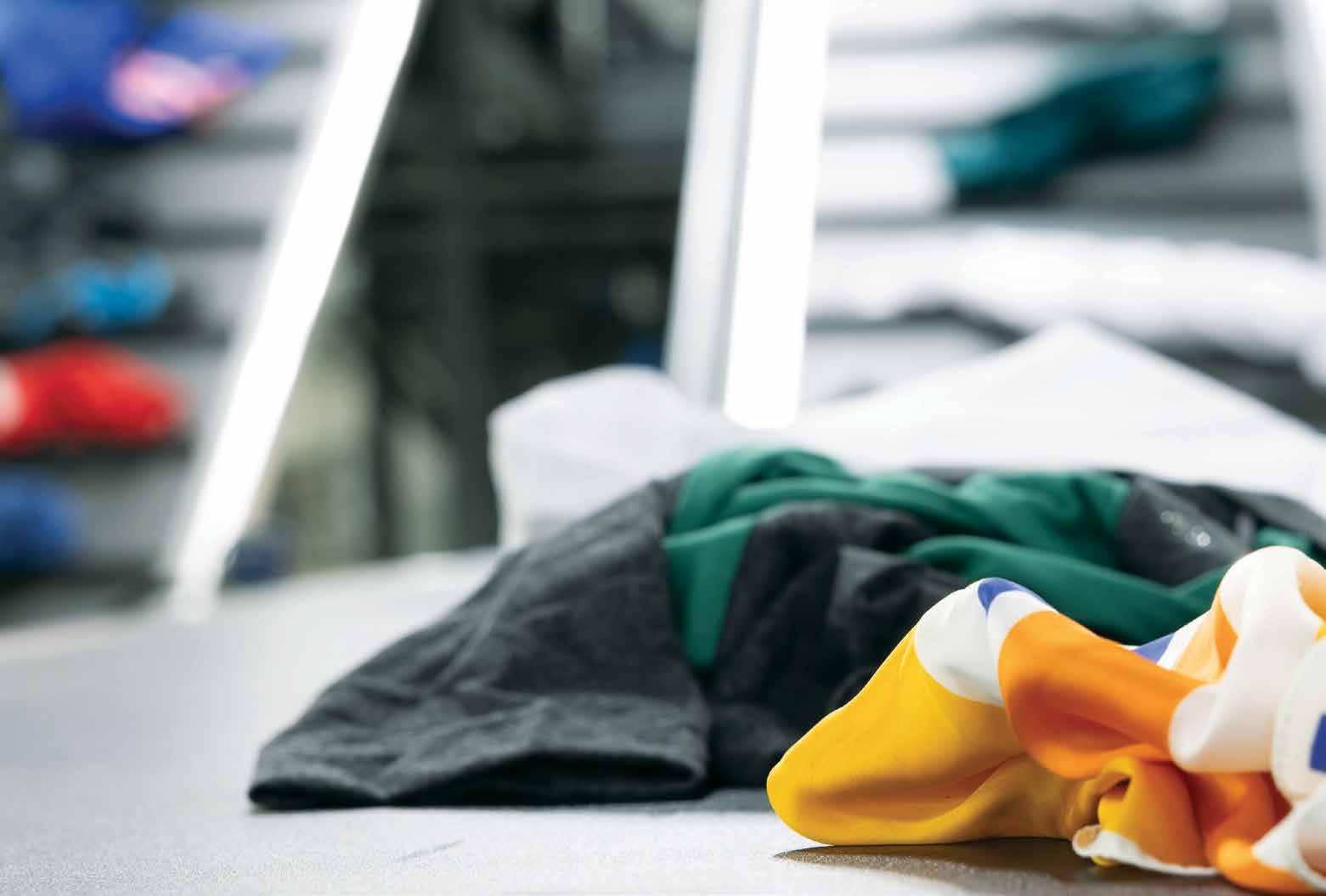
re&up recycling technologies is a company with no time to waste. Or textiles, for that matter. By 2030, the Sanko Group spinoff aims to hit an annual recycling capacity of 1 million metric tons. That means it has to hustle. c Since announcing itself to the world at the Global Fashion Summit in Copenhagen in 2024, the textileto-textile recycling firm has completed two industrial-scale plants in Turkey, where it can pump out a collective 80,000 metric tons of recycled polyester and recycled cotton every year; inked a multi-year “circular textile solution” agreement with Puma; and set a new industry standard by becoming the first to be Cradle to Cradle-certified circular for all its products. c In this condensed and lightly edited interview, we caught up with Re&Up’s general manager Andreas Dorner to learn more about the challenges of operating in today’s geopolitical quagmire, and how environmental policy can be both a boon and a bane, and where the company is headed next.
You got up and running quickly!
Andreas Dorner: Last year was just an announcement of Re&Up ramping up. We are very proud that the machines are running at full capacity. So that’s the reason why we can now offer 80,000 metric tons at scale to the market, where 50,000 metric tons is cotton textile-to-textile recycling and 30,000 metric tons is polyester textile-to-textile recycling. The next step is to plan to have a site in Europe. We have some very strong negotiations with some sites in two different countries. And the next direction would be Asia, to expand some bigger lines there. The plan is also to continue to increase our capacity in Turkey, in parallel with the other developments.
Re&Up is a bit different from the current breed of advanced recyclers, which wholly use chemical methods to separate polycotton blends. You’re using a combination of mechanical and thermomechanical, instead. Why is that?
AD: While we see that the market is going toward depolymerization, which is either the glycolysis or monomer process, we went another direction, with an extrusion process. This gives us the opportunity to have Global Recycled Standard certification. The harsh chemicals in the glycolysis process don’t allow for GRS certification, but our process structure and process design allowed us to get there. And we wanted to be more innovative in our technique, too.

What inspired the move to C2C certification?
AD: Cradle to Cradle as a standard has been a bit quiet in recent years, but we think it’s a good standard in the industry. And we saw a big opportunity that reduced a lot the complexity, which before was very high, very costly and didn’t provide a real service to brands and to producers. And it only required us to do some assessments to shape the data points. So why not integrate it into our system? Ebru Özküçük Guler, our chief sustainability officer, really led that effort. We did not have to change any processes. It was just a matter of understanding what data points they needed, what kind of reporting
they were looking for. So we were able to do this very quickly with a few visits. But, of course, saying that now is easy, but it involved a lot of work to get all the things together: uploading the platform data and doing some iterations to see how it works. And Cradle to Cradle hadn’t done this with other textile companies, so it was a learning process for both sides.
Who are the main buyers of your recycled cotton and polyester?
AD: When we started in the beginning, Sanko was a very good mother company to help us prove the concept. But this year we developed a matrix of additional spinners, filament producers and staple fiber producers for polyester. And the brands helped us, too. We talked to brands in Europe and in America and said, “Hey, help us guide this to the right mills.” We’re still a small company; we can’t just go to a fair and say, “Here we are,” and then have 300 customers who’ve never used our fibers before to want to use them.It was more clever for the leading brands who are already making commitments for circularity to say, “OK, I want to have your fibers. And here are the mill metrics to integrate the fibers into our systems.” And all I can say is that we’re in the end phase of building some long-term agreements with some major fashion and sportswear brands in addition to Puma.
Re&Up’s partnership with Puma focuses on regional strategies. How does that work exactly?
AD: It makes no sense, because of CO₂ emissions, to ship fibers or fabrics around the world, from east to west, from north to south. So we wanted to develop regional supply chains. Like for us, we go for the United States, we’ll try to build something in Mexico. Puma is working in Europe, so we try to have Turkey as a kind of central hub for the North African and European markets.
And we are working with Puma and a supplier in Asia to find a way to produce recycled fibers with the lowest possible CO₂ emissions. So it like looks like shipping polyester chips is the best way, instead of sending yarn or fabrics. So we want to use the opportunity to think about a holistic way of. We want to use the opportunity to think holistically about how to reducing the overall environmental emissions and burden.
How do you expect the U.S.’s tariff revisions to affect business overall?
AD: This impacts the global fiber business tremendously. Yes, we have the advantage if we’re sending the fibers out of Turkey to the United States, but we need to understand better what it means if we’re sending them to, say, Asia. What are the consequences? China, Bangladesh and India are still the biggest manufacturing areas.
And when the tariffs are changing every other week, it’s very difficult to build a strategy. When they were first announced, a lot of companies had to assess their own value chains to try and mitigate the risk. And when they were finished, suddenly there was an announcement for another change. And I think that’s giving the entire industry a big headache.
THERE'S PLENTY OF TEXTILE WASTE IN EUROPE AND THERE ARE ENOUGH WAYS TO CONVERT THEM INTO NEW FIBER THAT CREATES A BETTER PRODUCT.”
Andreas Doner, Re&Up general manager

What do you see as the main challenges of making textile-to-textile recycled fiber the status quo, rather than something that’s a niche product?
AD: The challenges are threefold. First, you need brands that are interested. The second is to understand the legal framework. The United States has very clearly dropped back. Europe is pushing forward still but Europe is very complex, with 17 legislation points we need to comply with, plus differences in the way member states approach different regulations, like extended producer responsibility—it’s not one EPR, it’s 27 EPRs.
And the third is that Europe is mostly considering only post-consumer recycled textiles for its recycled content targets. From the industry side, there’s a push for postindustrial recycled, too. So we need some clarification because this is a global business. We need to make sure that waste isn’t traveling all over the world. It doesn’t make sense to send waste from China to Europe and then fiber back. Our mission is to clean up Europe first. There’s plenty of textile waste in Europe and there are enough ways to convert them into new fiber that creates a better product.
There are reports of brands pulling back from their sustainability commitments. What has your experience with this been like? And has that made for increased competition with other textile-to-textile innovators?
AD: We’re seeing this because there’s a lot of uncertainty. The brands we are working with, they still have very strong recycling commitments. Are they able to execute them as quickly as they want? No. There’s a lot of recalculation that is happening into the value chain because of the tariffs. So we’re seeing the speed of business slow slightly, but no one’s dropped out of their commitments. I think overall, if you look at the global market, it needs multiple solutions. There is not one. But our differentiation is that we’re focusing on majority cotton because there is, per se, a shortage of cotton due to the annual harvest and stock situation. And we have a unique position that we offer cotton and not cellulose powder to the market. With polyester, I would say that competition will get stronger because there is less of a differentiation, but as I said, our process is GRS certified. We see the other companies, and we read about them are very curious of what they’re doing. But I think most of them will only be ready to ship out in 2028, 2029, 2030. Whereas we’re already at 80,000 metric tons today, so we have at least a few years of an advantage there.
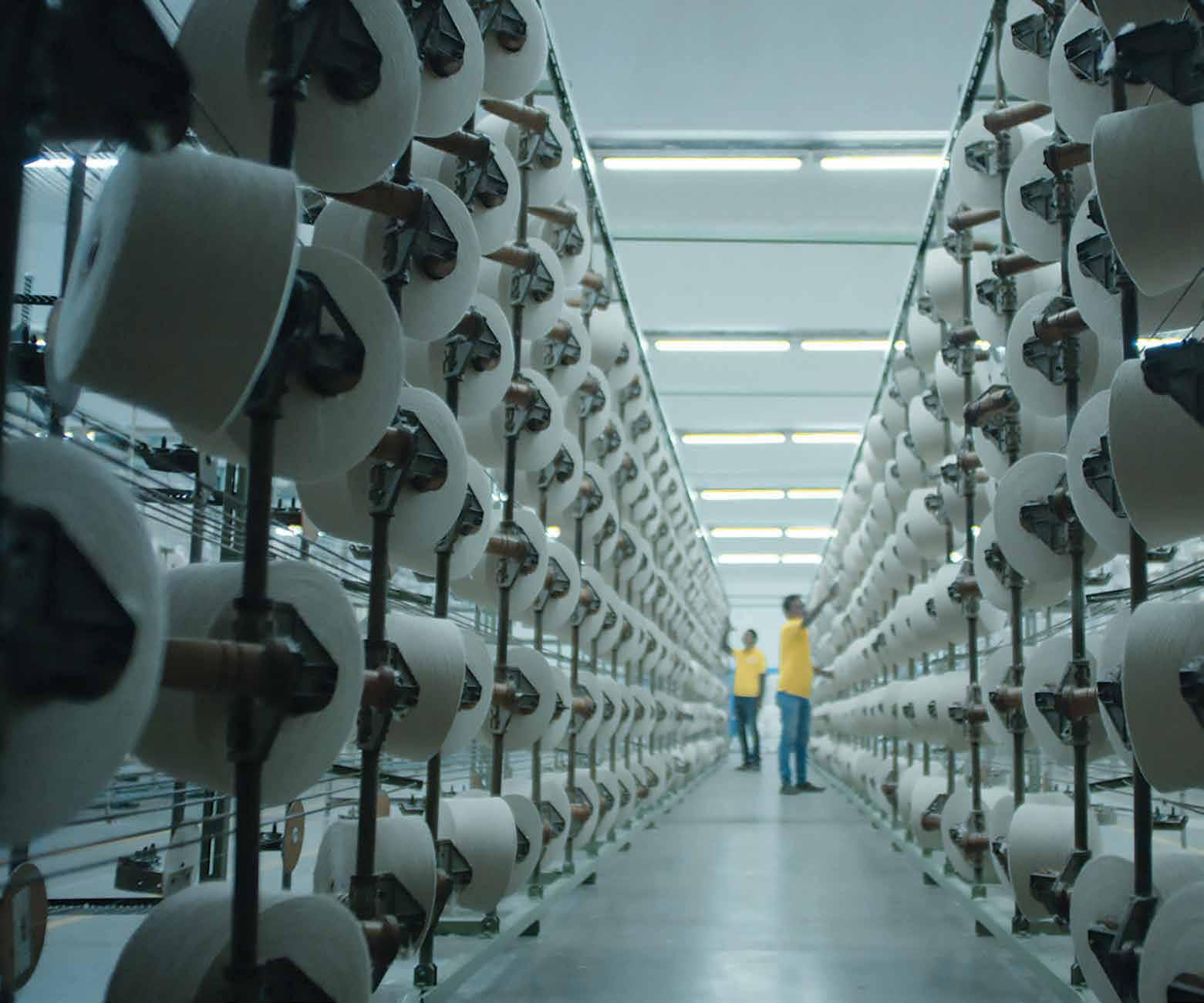
mills are seeing clients take a more cautious approach to seasonal sourcing, prioritizing versatile, value-driven fabrics over trend-driven novelties and new sustainable ideas. Across the supply chain, companies are tightening investments, reflecting a broader sense of conservatism in challenging times. c “Companies are less likely to experiment with new ideas or products. Everyone—from customers to brands—are really focused on the value proposition of products. Everyone’s goal is to have the best product for a great price,” said Zahra Ahmed, ADM head of sustainability and marketing. c One area that leading mills hope will remain resilient is the denim industry’s commitment to circularity and recycled cotton. While demand for innovation has softened, Ahmed noted that recycled cotton is increasingly viewed as an industry standard—bolstered by scaled production capabilities and advancements in traceability technology. c ADM’s partnership with Recover Textile Systems is an example of how a circular solution, supported by transparent and concise messaging, can scale up. In 2021, the Pakistani vertical mill entered a strategic partnership with the Spanish material sciences company to establish a recycling facility and to use its certified and traceable recycled cotton in its collections.
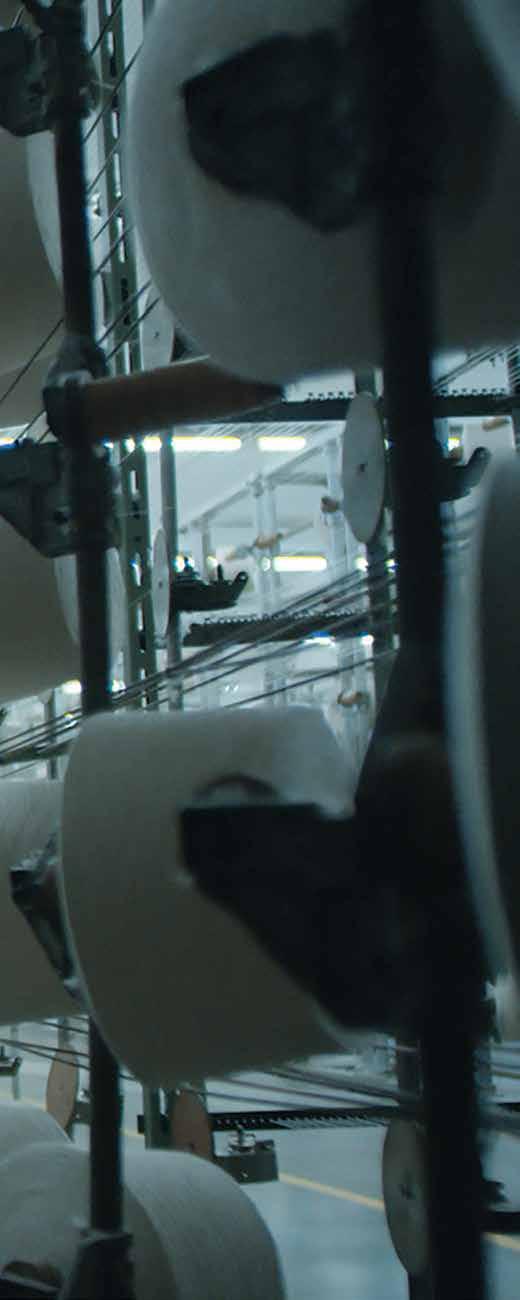
Today, ADM produces 12,000 tons Recover recycled cotton fiber per year at a facility 10 minutes away from its main spinning hub. The family-run company also produces Recover fiber for other businesses in the region.
Per Recover’s 2024 LCA for production hubs in Pakistan and Bangladesh, the environmental savings of 1kg of Recover recycled cotton fiber verses convention cotton is 100 percent water, 93 percent CO2, 99.9 percent eutrophication, 96 percent energy and 100 percent land use.
“We have been so passionate about incorporating recycled cotton fiber into our products for the last five years. Seeing the customer response has been amazing, and seeing our customers across the board in both the EU and the Americas incorporating it has been a real exciting chapter for us,” Ahmed said.
Pitching recycle cotton wasn’t always this easy. In the early years, Ahmed said she often had to actively advocate for its potential. Many clients were experiencing innovation fatigue, having seen too many sustainability trends fail to launch. There was also a significant knowledge gap—Ahmed frequently found herself explaining technologies like laser finishing and water recycling, which have since become industry standards.
Nowadays, recycled cotton is featured in most of ADM’s textiles.
A key distinction for ADM was offering Recover fiber at cost. Another was Recover’s ability to verify claims through third-party certifications and verifications (including GRS, OCS, UN Global Compact, Higg FEM/ FSLM) and LCAs.
“We are committed to Recover because they’re a global company that offers traceability and have the set standards that are setting the mark for the industry,” Ahmed said. “Anyone can set up a recycling machine in their plant, but to set up a recycling facility is a very different thing, and then to do it at scale is a very different thing. That’s always our competitive edge. We’re not just pumping out a fiber; we’re offering a product that comes with its own assurances, most importantly, its own traceability and scalability.”
At the end of 2024, Recover had 156 active customers. Alfredo Ferre, Recover chief product, innovation and sustainability officer, said denim continues to be a strong and growing area for Recover. Partnerships with leading brands like DL1961 (part of the ADM family), Revolve, Lands’ End and Perry Ellis not only demonstrate the increasing demand for sustainable denim solutions, but also the proven performance and quality of the firm’s recycled fiber. At the same time, the company continues to proactively address ongoing concerns around regenerative fiber.
“There are many misconceptions about denim made from recycled cotton fibers, one of the most common being that they don’t respond well to finishing processes. This perception can sometimes hinder wider adoption,” said Ferre. “That’s why we continuously challenge the status quo and advocate for the idea that more sustainable fibers are not a barrier to creativity.
One way how Recover quells concerns is through proof-of-concept collections with supply chain partners. In 2023, Recover launched the Reiconics collection with Spanish finishing technology firm Jeanologia, showing how it’s possible to create stylish and unique pieces using sustainable finishing techniques, with denim containing up to 32 percent recycled cotton.
More recently, Recover partnered with Neela by Sapphire Fibers to develop a circular, dye-free denim with recycled fibers. Ferre said the collection was designed to deliver authentic denim aesthetics while minimizing environmental impact, achieved through zero dyeing, 100 percent traceability, and the integration of our Recover Trace technology, which embeds a physical tracer in the fiber to verify its presence and ensure full transparency throughout the supply chain. “One of the key considerations when scaling recycled cotton in denim is managing performance expectations. While many brands aim to replicate the characteristics of virgin cotton, it’s important to recognize that recycled cotton behaves differently. Rather than viewing this as a limitation, it opens the door for innovation and collaboration across the value chain,” Ferre said.
The perception that recycled cotton compromises quality is increasingly being disproven by innovation and real-world products, according to Laura Vicaria, Denim Deal program director.
Denim Deal helps tackle recycled cotton issues by creating strong cross-value chain collaboration, bringing together recyclers, mills, brands, and other value chain partners to remove the roadblocks together. The industryleading initiative is committed to standardizing circular practices in denim production and to catalyze the production of 1 billion pairs of jeans containing at least 20 percent postconsumer recycled cotton by 2030. The 20 percent minimum was established as both an ambitious and achievable starting point for stakeholders. “It sends a strong signal to the market that scaling circularity in denim is possible today, not in some distant future,” Vicaria said. “This threshold strikes the right balance between environmental impact and production feasibility, encouraging brands to act while allowing room for innovation,
improvement, and scalability. Our goal is to show that integrating post-consumer recycled at scale is not only necessary but also viable.”
Isko is seeing growing interest in textileto-textile solutions. “Our clients care deeply about look, feel, and performance and when they see that our recycled denim checks all those boxes, the sustainability story becomes an even stronger bonus. It’s that blend of fashion and function that makes it work,” said Mirela Slowik, Isko category leader.
For Spring/Summer 2026, the Turkish mill introduced Recode Denim, a fabric concept that leverages next-generation recycled fibers and “groundbreaking fiber recovery techniques.”
Slowik describes Recode as an evolution of Ctrl+Z—Isko’s earlier collection of Bluesignapproved fabrics made exclusively from recycled and regenerated fibers, introduced in 2022.
With Recode, Isko offers greater flexibility in the composition of fabrics, allowing brands to choose varying levels of GRS-certified recycled and FSC/Canopy-certified fibers to better align with their unique circularity goals. The goal is to deliver premium performance and style while maintaining high sustainability standards—proving that elevated design doesn’t have to come at the expense of quality.
“Our approach is now even more strategic: we’re integrating recycled content where it truly performs best. As circularity is at the heart of what we do, this shift helps us get the most value and impact from the fibers we recover,” she said.
Isko utilizes Re&Up, the textile-to-textile recycling firm by parent company, Sanko Group, for recycled cotton and polyester. Slowik said recycled cotton continues to be the most in-demand as polyester is more nuanced. Most clients request around 30 percent recycled content to aligns with regulatory benchmarks.
“What sets us apart is how we engineer recycled fibers into the core of the yarn giving us exceptional durability that has tested over three times better than other recycled fabric options currently on the market,” she added.
The optimal percentage of recycled cotton in denim can vary depending on several factors, including brand requirements, performance requirements of the end-product, fiber type, yarn count, spinning system, production setup and even the type of cotton waste used, according to Ferre.
“While there’s no fixed range that guarantees both quality and durability, the most common percentage of mechanically recycled cotton found in denim in the market typically falls between 10 percent and 20 percent,” he said. “This range reflects a balance that many brands strike between improving sustainability and maintaining fabric performance, aesthetics, and durability. As technologies evolve and supply chains adapt, we expect to see this percentage gradually increase across the industry.
He added that it’s worth noting that industry standards like GRS often default to a 20 percent recycled content threshold.
On average, ADM incorporates 20–30 percent recycled cotton into its denim fabrics. According to Ahmed, this range represents the “sweet spot” where the performance and feel of recycled denim match those of non-recycled fabric. Anything higher can impact product viability, she added.
“We never want to degrade a product’s quality to just say that we’re achieving XYZ sustainability goal. The goal is always to keep product integrity at the standards we set for ourselves and what our customers expect
WE’RE NOT JUST PUMPING OUT A FIBER; WE’RE OFFERING A PRODUCT THAT COMES WITH ITS OWN ASSURANCES, MOST IMPORTANTLY, ITS OWN TRACEABILITY AND SCALABILITY.” Zahara Ahmed, ADM
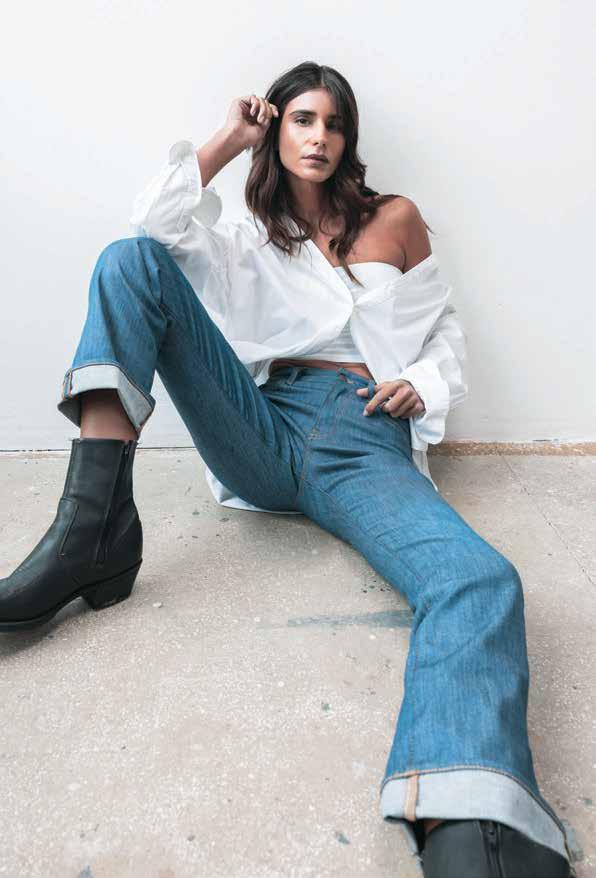
E
Isko utilizes Re&Up, the textile-to-textile recycling company by parent company, Sanko Group.
from us, while also successfully incorporating recycled component,” Ahmed said.
Jeans made entirely from recycled cotton are now a reality. Gabriela Hearst recently launched a collection of 100 percent recycled cotton jeans priced at $950. Vicaria said the collection is a powerful statement on what’s possible in sustainable denim design.
“We’ve also seen other brands such as Tommy Hilfiger and Kuyichi reach similar milestones, showing that this is not an isolated effort but part of a broader shift in the industry. More and more brands are aiming for higher recycled content, which speaks volumes about the growing commitment to circularity and specifically, to the use of recycled cotton,” she said.
Vicaria added that in most cases of 100 percent recycled jeans, brands use blends of post-consumer recycled and pre-consumer recycled cotton. “Achieving 100 percent recycled content is still a challenge, particularly when focusing exclusively on post-consumer recycled due to its limited availability and processing complexity. But with continued collaboration and innovation, like what we foster in the Denim Deal, this level of ambition is becoming increasingly feasible,” she said.
While 100 recycled cotton denim collections are important milestones for the industry, Ahmed noted that these jeans may not have broad mass-market appeal—and it’s not only because of the luxury price tag.
The challenge lies in the fabric itself: as the amount of recycled cotton increases, the denim tends to become stiffer due to
the shorter staple length of the fibers—an attribute that runs counter to consumer preferences for softness and comfort.
“You can always increase the percentage of recycled content, but then the product begins to change,” she said. “Today, what consumers are looking for is always a soft hand feel.”
While mills remain optimistic about the staying power of recycled cotton amid economic challenges, its position is not entirely secure.
Looking ahead, Ahmed anticipates companies to shift their sustainability focus to actionable items that can deliver both value and quality to consumers. Whether circularity guidelines and ESG targets focused on regenerative fibers will meet these demands remains to be seen.
Slowik points to several key challenges hindering the broader adoption of recycled cotton: limited availability of high-quality fibers, higher costs, technical difficulties in blending, and concerns about product durability.
“There’s definitely a gap and often it comes down to regulations versus intention,” Slowik said. “Many brands are working to meet evolving compliance frameworks, which is a crucial first step. But for recycled fibers to scale meaningfully, they need to be embraced not just as a requirement but as a strategic material choice. That shift is starting to happen, and we believe rising pressure from climate realities and resource scarcity will only accelerate it.”
Vicaria identified sourcing, consistency in fiber quality, and supply chain alignment as some of the most pressing obstacles. She stressed that post-consumer textile recycling requires reliable systems to collect, sort, and process at scale—systems that are still being developed and scaled globally.
Ferre underscored the importance of quality control to ensure consistent integration of recycled cotton into supply chains. “Managing raw material inputs and segmenting textile waste streams is also critical, as each recycler has specific requirements for feedstock quality and composition. Supporting recycling actors with better sorting and classification systems can significantly improve fiber yield and performance,” he said.
However, membership in initiatives like the Denim Deal offer a pathway forward, enabling brands to share knowledge, pool resources and access ready-made solutions like plug-and-play supply chains.
“Denim Deal provides circular guidelines based on industry feedback and legislative requirements. Members benefit from collaboration, education, exchanging information, action-driven pilots and workshops. A collective effort ensures that no single organization is working in isolation, the organization states,” she said.
Ahmed emphasized that meaningful, industry-wide change in recycled cotton adoption hinges on greater commitment from major players. Primark was one of ADM’s first customers of Recover fiber and is one of the biggest customers to this day.
“Customers have many options, but just a few brands rise to the top when it comes to driving industry change,” she said. “When big brands decide to put their money behind these initiatives, the trickle-down effect is positive because the industry moves at volume. When you have a volume driver that that is sustainable, it all kind of clicks into place.”

Hemp and linen are paving the way for a broader shift toward innovative, low-impact fiber alternatives.
by Angela Velasquez
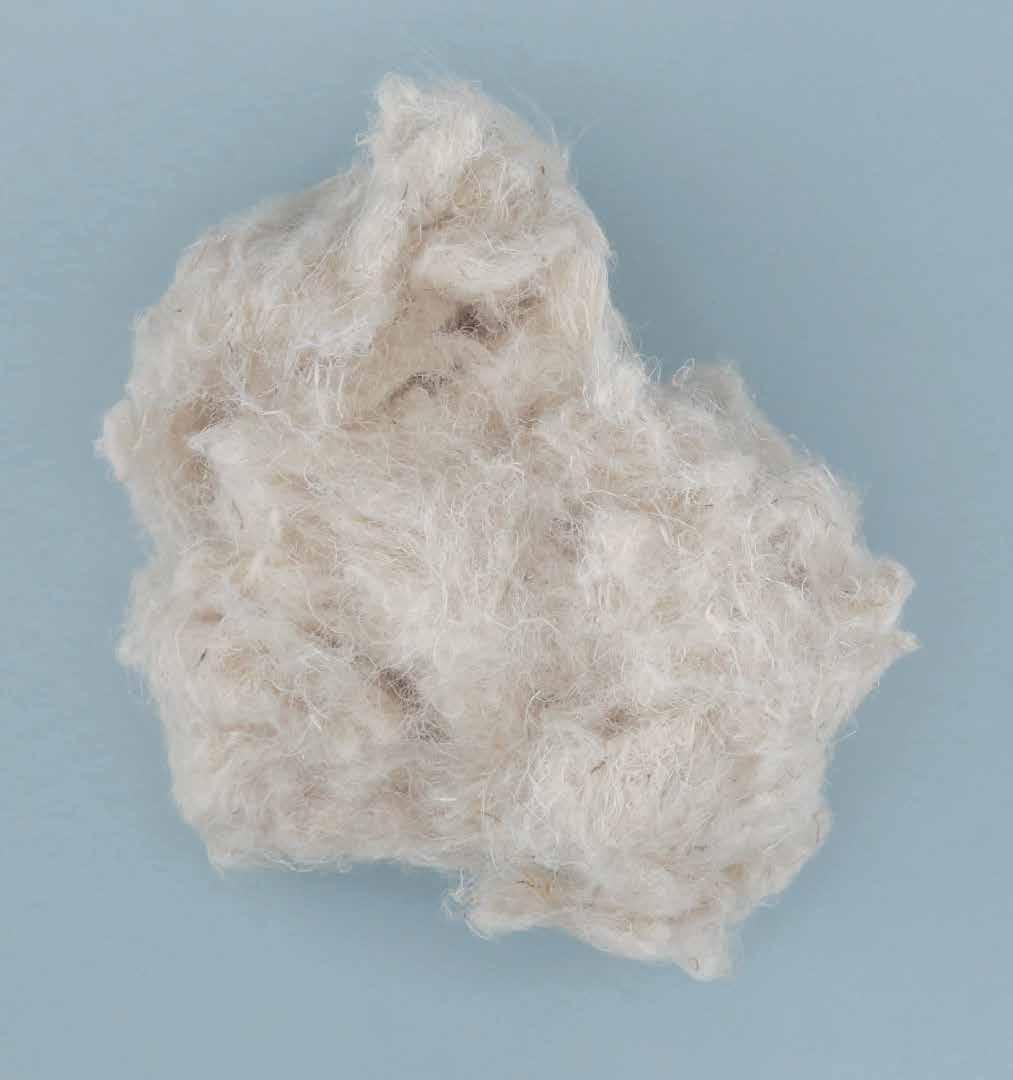
the era of denim made exclusively from cotton is over—but that doesn’t mean synthetics have taken over by default. Today, denim producers have access to a wider range of fibers than ever before, including natural alternatives like hemp and linen. Recent mill collections have highlighted the diverse aesthetics these fibers can bring to denim—some introduce a subtle texture or lightness, while others enhance the fabric with distinctive tactile effects. Regardless of the look or feel, the priority remains the same: creating denim with a reduced environmental impact. c “Alternative natural fibers that can work independently and in combination with cotton have gained significant attention in the last two years. This surge in interest is driven by the industry’s efforts to reduce environmental impact, diversify supply chains, and enhance product performance,” said Nicole Ajimal, WGSN sourcing editor. c Ana Paula Alves de Oliveira, founder and strategic director of the consultancy Bwe Disobedient, said regenerative fibers are gaining attention for good reason: they require less water, fewer chemical inputs, and are more adaptable to sustainable practices. “Overall, these fibers allow us to diversify the material base of denim beyond the traditional cotton-elastane-polyester mix, which is long overdue,” she said.
Though the fibers gained popularity for their low environmental footprint, innovative products like Smart Linen from The Flax Company are taking sustainability even further.
In 2022, the French company launched Smart Linen, a GRS-certified recycled cottonized linen fiber made of pre-consumer waste. Applicable to denim, knitwear and home textiles, the fiber is reportedly stronger than cotton and contains antimicrobial and moisture-wicking properties.
The Flax Company offers two versions of Smart Linen: one is a 55/45 recycled linen/ virgin linen blend, and the other is 100 percent recycled linen. “As with all linen blends, the linen comfort starts to be felt in blends in 40 percent or higher,” said Denis Druon, The Flax Company CEO. “Also, these blends start giving a linen drape to the fabric and the unique, irregular look of linen, which is a huge difference.”
From a plant and fiber standpoint, Druon noted that Smart Linen carries ‘no additional environmental premium’ compared to traditional linen. However, it tackles the industry’s waste problem by enabling brands to repurpose industrial waste in a more meaningful way—rather than relegating it to low-value uses or discarding it entirely.
Additionally, Smart Linen is just 10 to 20 percent more expensive compared to virgin fibers when the price of virgin is at a low level. “In today’s market price, the virgin and recycled prices are very similar,” he said.
The Flax Company’s core business is in linen fiber, both for the pure linen industry and cotton spinning applications. Hemp accounts for just 5 percent of The Flax Company’s turnover.
Thirty years ago, Druon said linen was considered a “fashion fiber,” with sales largely dependent on whether designers chose to feature it in their collections. That mindset has since shifted. “Nowadays, linen is purely a commodity fiber that can be found in all collections. We have a strong feeling that hemp will follow the same path in the years to come,” he said.
The Flax Company anticipates that the looming regulation requiring companies to include 30 percent low environmental impact fibers in all clothing by 2030 will have a major impact on the use of Marmara Hemp. The company launched the brand of cottonized hemp fiber in 2021. It is the first hemp fiber to be certified as sustainable, Cradle to Cradle (Platinum level) and with a Life Cycle Assessment performed by a certified body. No chemicals are used in its production.
Though hemp is prevalent in mills’ concept collections, market options of the natural bast fiber are less common—at least at scale.
“Demand is up and down, and we can see that hemp has not yet found its place in industrial bulk production,” Druon said. “However, there are more capsule collections being produced for the big names in denim. We take this as a positive sign for the continued interest in hemp fibers.”
U.S. brands have shown interest since the beginning of Marmara Hemp. Some are purely for the novelty and eco-friendly message, while others are for the unique look of hemp fabrics. Others need the nudge from policymakers.
“Many of them are showing an interest but are perhaps waiting for the regulations to impose a minimum percentage of recycled or low environmental impact fiber before using our certified fiber,” Druon said. “The economic environment does not necessarily encourage brands to pay a little more to offer a more virtuous product, especially as consumers are still showing a reserved interest in sustainable products. Our supply chain is ready.”
Mills are also ready. Denim’s adoption of hemp is an example of how the industry innovates for sustainability. For spinners, hemp is a harsh fiber compared to cotton, but more compatible spinning techniques have been developed, allowing hemp to easily blend with cotton or man-made fibers. On average, mills use 20 percent Marmara Hemp in their blend ratios. The Flax Company does not recommend ratios of more than 30 percent.
“The mastery of hemp and the level reached by manufacturers has been spectacular over the last three years. Hand feel has now been mastered to perfection, and it is now hard to tell a cotton hand feel from a hemp one in denim,” Druon said.
Stephanie Poon, Twin Dragon’s director of marketing and merchandising, agreed, describing how early generations of hemp fabrics often had limitations in softness and consistency.
“Over time, improvements in fiber processing and spinning have allowed us to create fabrics with a much cleaner hand and more consistent performance. Today, hemp can be blended seamlessly into premium denim, offering not only sustainability but also a differentiated look and drape that designers love,” she said.
G

Making hemp denim is “getting easier every day,” according to Dixie Carter, president of Panda Biotech. For mainstream denim, Carter said a 30 percent hemp blend has proven optimal for both performance and economics.
Premium denim brands tend to look at 50 percent or higher for unique texture, style and a bolder sustainability story.
The Dallas-based, privately-owned company celebrated the opening of its 500,000 square foot gin in Wichita Falls, Texas in June. The facility can process 22,000 lbs. of hemp stalk per hour, producing up to 150 million lbs. annually. It is the largest hemp decortication facility in the Western Hemisphere.
Earlier this year Twin Dragon launched fabrics made in Mexico with Panda Biotech’s sustainably sourced, American-grown hemp, backed by the Southern Ute Indian Tribe Growth Fund. The collection includes 11oz. to 13oz. constructions, offering weights for bottoms and jackets. Most are cotton-rich blends enhanced with 20–30 percent hemp, tailored to achieve the desired balance of aesthetic and performance. While the current range is indigo-based, Poon said the mill is preparing to expand into natural grounds for garment-dyed applications.
“Brands are excited by the sustainable angle, but equally important is the hand feel and modern look we’ve been able to achieve with hemp—it’s not the coarse, rustic fabric many people expect,” she said.
Sourcing traceable hemp from Panda Biotech was an important milestone for Twin Dragon, which previously sourced the fiber from China. Having access to U.S.-grown fiber not only shortens the supply chain, but it also strengthens the mill’s “Made in the Americas” story, which is increasingly important to brand partners. Poon said it “resonates particularly with clients who want to minimize supply chain risk and emphasize regional sourcing for speedto-market, transparency, and sustainability.”
While those articles made with Chinese hemp remain available, Twin Dragon’s focus now is on scaling its partnership with Panda Biotech to strengthen local sourcing. “We are applying insights gained from established hemp manufacturers to refine our processes and hone our craft on this side of the world,” Poon said.
With hemp being a relatively new crop in the U.S., Panda Biotech is refining seed varieties, genetics, processing settings, and cottonization methods to deliver consistent, spinnable fiber. Carter said partnerships with mills like Twin Dragon and Global Denim have been invaluable, providing feedback that has helped the firm steadily improve fiber quality and deliver denim that meets both performance and design expectations.
“Collaboration is essential. Processors and spinners must work hand-in-hand to achieve the right yarn quality,” she said.
Hemp and linen are not the only options. Ajimal noted that mills are exploring fibers like pineapple, banana, soy, ramie and silk blends—alternatives that offer various natural properties, promote recyclability and even biodegradability—though they’re being adopted at a much slower pace.
“It’s not about fitting new fibers into old molds—it’s about redesigning the mold altogether,” Alves de Oliveira said.
“Innovation doesn’t have to follow the rules of legacy systems.”
Scaling these fibers will require a fundamental shift in how the supply chain is built. “Right now, most industrial systems are designed around standardized cotton and synthetics and not equipped to handle differentiated fibers like hemp or linen at scale. We need more flexible and regionalized processing infrastructure, and above all, the ability to offer a wider variety of yarns that are compatible with both traditional and more conscious consumption patterns,” she said.
More education about the characteristics of alternative fibers is crucial, as different blends serve distinct purposes based on performance and aesthetics. “We need to ensure that industry buyers and consumers can fully appreciate the diverse attributes these natural fibers offer, their key benefits and price points and why that differs from 100 percent cotton composition,” Ajimal said.
The industry also needs to ask the right questions. “But more than just asking if they’ll go mainstream, we should be asking: what’s holding them back? Often the issue isn’t feasibility, but lack of visibility, funding, or risksharing,” Alves de Oliveira said. “As industry players, we can’t wait for these materials to be ‘ready.’ We need to be the ones stress-testing them, co-developing, and communicating their value in ways that reach both brands and consumers. We’re curating ecosystems.”
BRANDS ARE EXCITED BY THE SUSTAINABLE ANGLE, BUT EQUALLY IMPORTANT IS THE HAND FEEL AND MODERN LOOK WE’VE BEEN ABLE TO ACHIEVE WITH HEMP.” Stephanie Poon, Twin Dragon

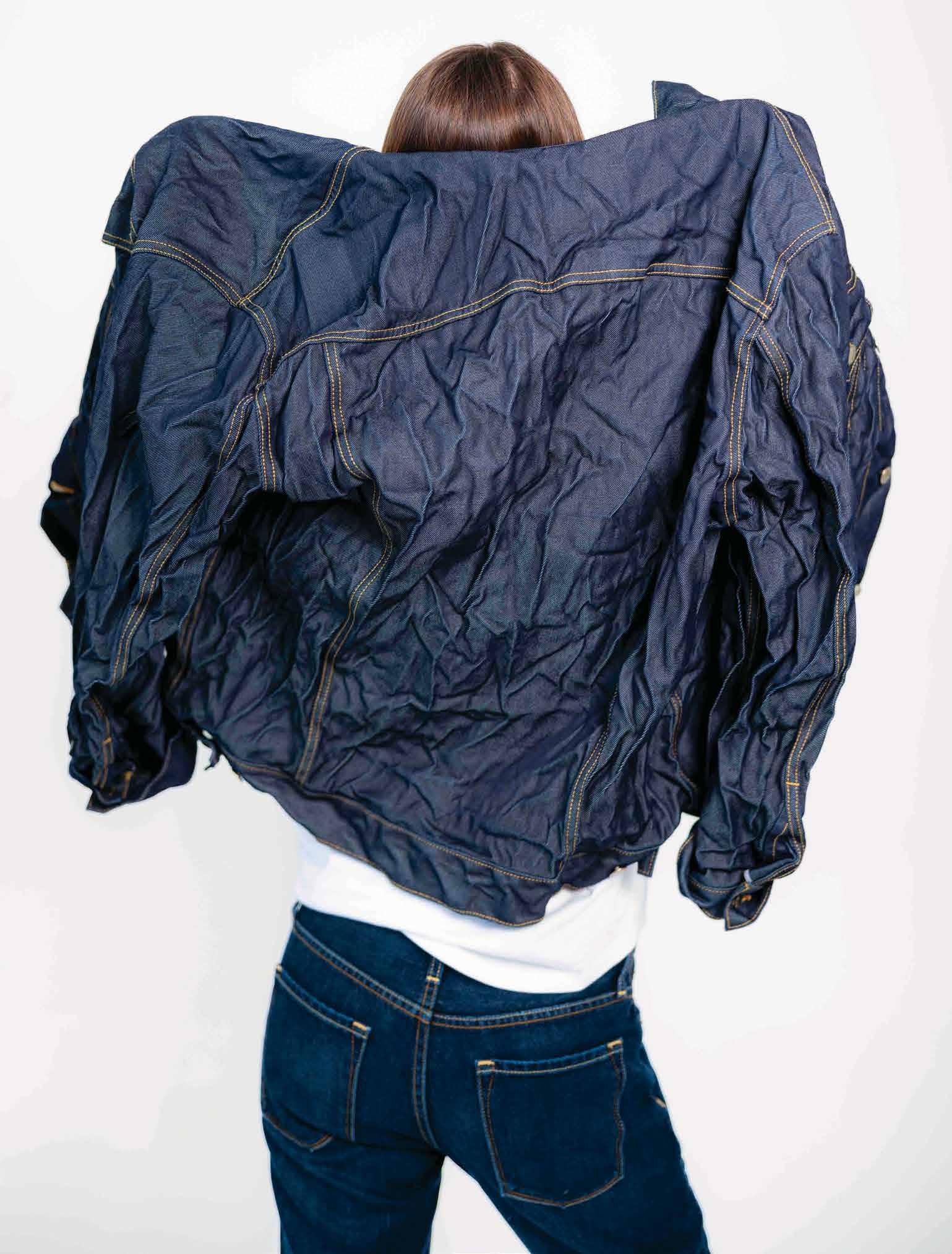
Mills and brands explore the performance and sustainable benefits
wool isn’t just for winter , knits, or outdoor gear anymore. It’s also the secret behind some of the most luxurious and high-performance denim on the market. But here’s the good news: the wool and denim industries are ready to let that secret out.
In May, The Woolmark Company, the global authority on Merino wool, launched “The Wool Lab Denim Edition,” a comprehensive digital sourcing guide for wool denim fabrics. As the conversation around sustainability and innovation in denim accelerates, Clementine Hurley, The Woolmark Company’s business development manager, fashion and product, said the organization recognized it had the opportunity to lead by providing real, tangible tools to the industry.
With this expert-driven resource, designers and manufacturers can explore the full potential of wool in denim, combining innovation with technical precision. The guide presents seven wool denim categories: A Revised Classic, Special Treatments, Denim Shirting, The Denim Suit, Signature Denim, Thread Rebels, and Denim-Inspired Knits and Jerseys. An accompanying toolkit, developed in collaboration with Woolmark’s global network of textile experts, provides in-depth insights into wool’s performance in denim applications, offering guidance on fiber selection, fabric construction, finishing techniques and sustainability practices.
However, the guide is not just a trend forecast. Hurley said its a materials roadmap, bringing together the latest commercially available wool denim developments, making it easier for industry players to experiment, collaborate and bring new products to market faster.
The Wool Lab Denim Edition is Woolmark’s most targeted response yet to the increasing number of requests the organization receives from mills, brands, and designers exploring the role of wool in denim innovation, according to Hurley. From jeans to shirting, indigo-dyed knitwear and chambrays, the previous season swatch requests highlighted how in demand the wool denim category has become.
“Over the past few years, we’ve seen a clear shift: denim is no longer viewed as a purely cotton-dominated category. The interest in wool denim is absolutely growing—and we’re seeing that first-hand at Woolmark,” she said.

The interest is coming from multiple directions. “On the supply side, mills are seeking to differentiate with hybrid yarns and more sustainable dyeing methods, many of which are uniquely compatible with wool. On the brand side, we’re seeing a clear adoption for natural fiber alternatives that align with their sustainability goals—without compromising on performance or design,” she said.
Wool-blended denim is increasingly popular for its premium and sustainable qualities, but it’s also capturing attention for its versatility.
Nicole Ajimal, WGSN’s fabric sourcing editor, said the fabric is especially favored
and consumers
in outerwear, tailored styles and high-end casualwear, highlighting how “the boundaries between smart and casual fashion continue to blur, drawing inspiration from one another.”
“The primary focus appears to be on comfort, as the soft, luxurious feel of the material is appreciated, and finishing techniques enhance its surface texture. With the introduction of machine-washable wool, more affordable and accessible options for denim-wool blends are now available, appealing to a wider audience,” she said.
Indeed, denim is a fiber-obsessed category, from mono-fiber constructions for recyclability to more innovative, blended or alternative approaches.
Hurley said this shift reflects a broader evolution in mindset: from chasing lowcost volume to prioritizing functionality, sustainability, and innovation. “Wool’s resurgence in denim isn’t just about novelty. It’s about meeting modern expectations. It offers natural stretch, breathability, odor resistance, and thermoregulation. That resonates in a market where consumers are demanding more from their garments both technically and ethically,” she said.
For wool, undoing long-held misconceptions that designers and consumers have about the fiber and its purpose in textiles is a unique hurdle to face. For decades, designers and consumers have been taught to believe it’s a winter fiber and is complicated to care for. “One of the biggest misconceptions about wool-blended denim is that it’s only suited for colder weather, when in fact it’s often softer, more breathable, and more versatile than traditional 100 percent cotton denim,” Hurley said.
Consumers also assume it’s highmaintenance or won’t wear well, but many wool blends can be cold-washed at home in a washing machine and develop a unique patina over time. “Wool adds elasticity, temperature regulation, and drape to improve comfort, especially for the active consumer. It’s not just a luxury fiber, it’s a versatile fiber that gives a technical and innovative upgrade to traditional denim,” Hurley said.
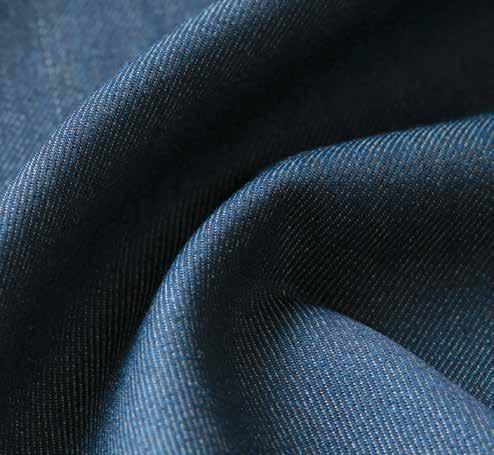

In 2022, Pioneer Denim became the first Bangladeshi mill to introduce wool denim and has been growing the category ever since. Using wool sourced from Australia, Pioneer offers wool denim made with 10-30 percent Merino wool in weights ranging from 7oz. to 12.5oz. and in a variety of indigo and black washes.
“We are observing a visible market shift at this moment in terms of customers’ preference for premium and luxurious fibers. Customers nowadays are interested in denim with more unconventional and premium fibers like merino wool, silk, nylon, hemp, linen and pineapple,” said Christian Reca, head of marketing and merchandising at Pioneer.
While cashmere has been part of Berto’s collection for several seasons, the Fall/Winter 2026-2027 collection marked the first time the Italian mill used 100 percent Merino Tec wool weft. The special wool means the fabrics are easy to handle, machine washable and even suitable for tumble drying.
“At Berto, we see a fair level of demand for fabrics made with these types of fibers,” said Francesca Polato, Berto’s marketing manager. “They help our clients attract their end customers, who recognize and appreciate the value of noble fibers in a garment.”
Berto sources the Merino wool from Südwolle. The collection includes three fabrics in different weights, ranging from 8oz. to 12oz. They all feature a blended composition of approximately 60 percent cotton and 40 percent wool. The Merino Tec wool weft means the fabrics are easy to handle, machine washable, and even suitable for tumble drying.
While Polato said customers choose the fabrics for wool’s inherent tangible qualities like softness and warmth, they’re also drawn to its exclusive nature. “I believe they’re drawn to it because wool denim is still quite rare, so it may represent something new and appealing to their own customers,” she said.

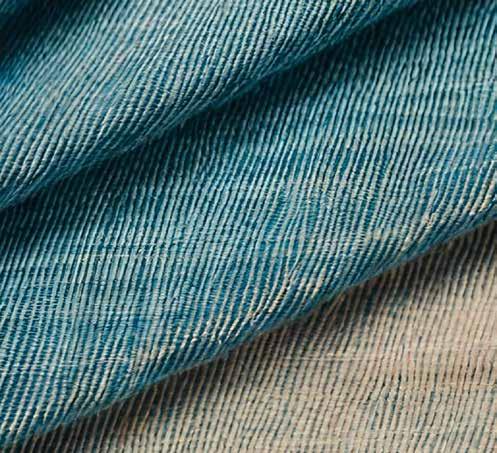
The Woolmark Company recommends merino wool ranging from 17.5 microns to around 22 microns for denim, with 19.5 microns being the most common. Yarn counts vary from finer counts used in lightweight shirting fabric, to coarser yarns suited to heavier bottom-weight fabrics. Wool can be used in both warp and weft yarn.
Given denim’s global popularity, Hurley emphasized the importance of ensuring that wool denim is equally accessible across the market—from luxury fashion to the high street. Though more mills are expanding on their core ranges and are now offering an extensive diversity of wool denim across various categories, from luxury to streetwear, wool denim previously only sat firmly in the premium to luxury tier of the market—and that was reflected in the cost.
The premiumization of wool denim may be due to its challenging nature to work with. Hurley said wool and cotton behave very differently during spinning, dyeing and finishing. Cotton is a short staple, while Merino wool has crimp and natural elasticity, which could challenge some traditional denim weavers. Working with it requires specialized dyeing and finishing techniques that aren’t part of conventional denim production.
“It’s not that easy. Wool yarn is very delicate, so great care must be taken during both the weaving and finishing phases. Additionally, extra caution is needed when washing the garment—stone washing or chlorine-based treatments should be avoided, as they would damage the wool component,” Polato said.
Traditional denim treatments like heavy washing and finishing once risked damaging wool, but Hurley said new dyeing and finishing methods have been developed to overcome this. Notable solutions include the Sara
Process, which allows fabric-level dyeing that replicates the high-contrast fades of ring-dyed indigo denim without the need for yarn dyeing. Hurley said this not only suits wool’s structure but also dramatically reduces water, chemical, and energy usage.
“Huilai Biotechnology is another innovation, using natural indigo screen printing and cold dye bath techniques to create rich, textured, and faded looks on 100 percent wool fabrics— achieving the aesthetic of worn denim without harsh processing,” she said.
For pigments, COLOURizd’s QuantumCOLOUR technology infuses pigments directly into the fiber, eliminating traditional wet dyeing altogether. This approach allows a wide range of effects and maintains wool’s integrity.
“While wool can’t withstand traditional denim finishing cycles, these modern technologies provide equally effective—and environmentally responsible—alternatives, paving the way for pure wool denim fabrics,” Hurley said.
Wool brings a host of natural performance benefits to denim, enhancing both comfort and functionality without compromising the classic denim look. The optimal wool content in denim depends on the intended product and performance, but 30 percent wool is generally the minimum level that consumers noticeably experience the benefits—including enhanced warmth, moisture management, elasticity and wrinkle resistance.
When used in the weft yarns, Hurley said wool sits against the skin, adding warmth and eliminating the chill often associated
I BELIEVE THEY’RE DRAWN TO IT BECAUSE WOOL DENIM IS STILL QUITE RARE, SO IT MAY REPRESENT SOMETHING NEW AND APPEALING TO THEIR OWN CUSTOMERS.” Francesca Polato, Berto
with traditional denim—especially in colder climates. It also improves moisture management, keeping the fabric feeling drier and more comfortable when wet, which is a major benefit in unpredictable weather. Meanwhile, wool’s natural elasticity allows the fabric to stretch and recover more effectively, helping denim maintain its shape over time. This makes wool denim ideal for travelers.
Hurley said wool is mostly blended with cotton to retain denim’s structure and traditional aesthetic, but newer combinations like wool-lyocell, wool-linen/hemp, and woolsynthetic blends are gaining traction. These alternative blends offer unique sustainability and technical performance advantages that are being explored more widely to meet the diverse needs of global denim markets. Brands such as Max Mara have used innovative 100 percent wool denim fabrics that replicate the look and style of traditional denim, with the added natural benefits of Merino wool, including increased softness and warmth.
On the practical side, specially treated wool can be made fully machine washable, making wool-blended denim just as easy to care for as traditional jeans. Added to this are wool’s natural stain resistance—thanks to its lower surface energy—and its ability to resist odors, which aligns perfectly with denim’s wash-seldom culture.
“All of these properties combine to create a smarter, more versatile version of denim that performs better in everyday life,” Hurley said.
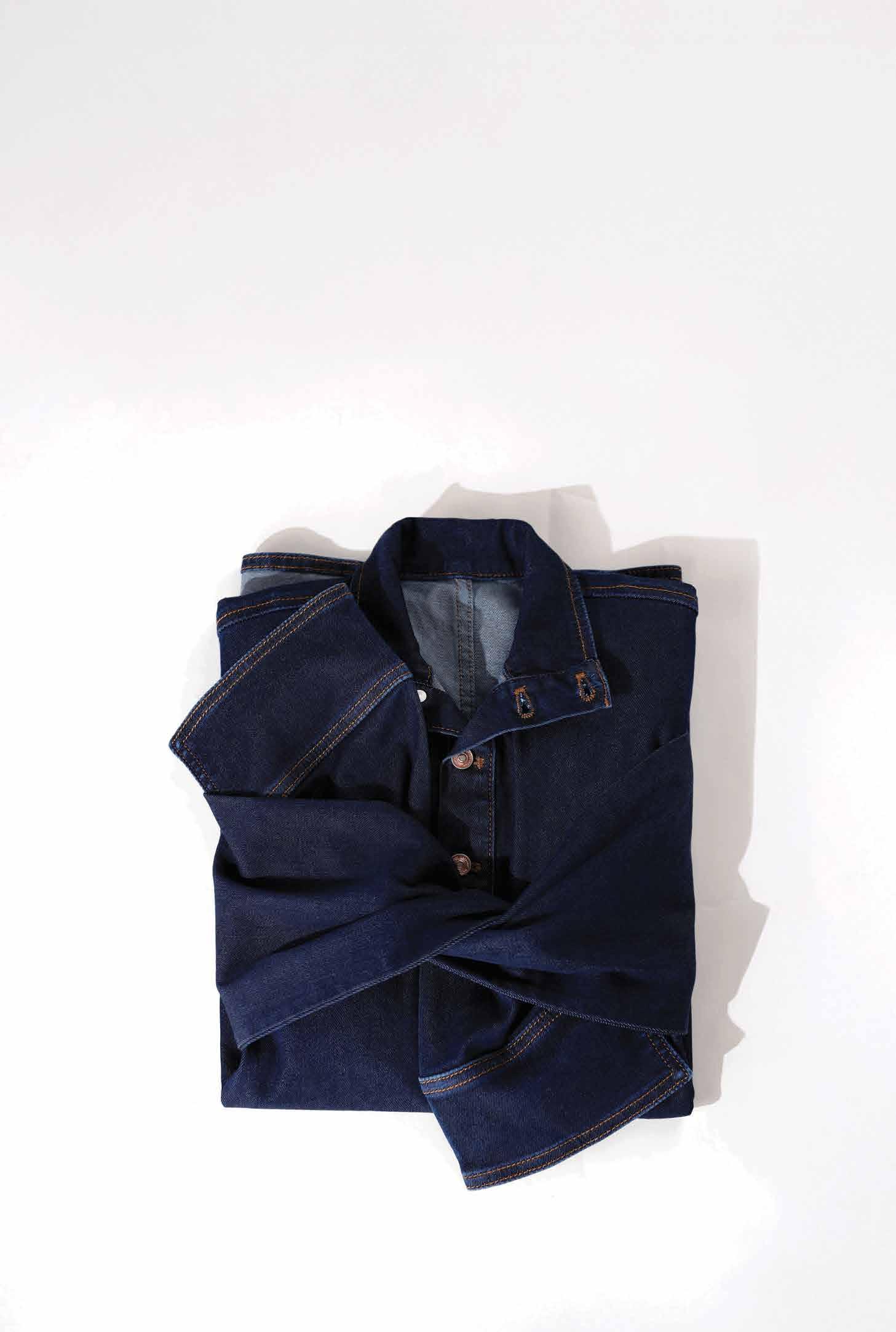
Rooted in the land, held by care. Gentle then, gentle still. A softness time did not steal.
SJ Denim has captured the changing landscape since 2015.
by Angela Velasquez
the year was 201 5. Barack Obama was in the White House. “Uptown Funk” by Bruno Mars was streaming. Avocado toast was a brunch essential, and consumers were addicted to pinning their aspirational life on Pinterest, while showing their curated real life through filters on Instagram. c Athleisure was also all the rage, driven by influencer marketing and the allure of status brands like Lululemon, Nike and Athleta. c The global denim industry was undeniably feeling the impact of leggings’ rise in popularity. After a decade of conditioning consumers to embrace high-stretch, form-fitting pants through the skinny jeans trend, the industry had, in many ways, paved the way for this shift. The denim category was at a turning point, and it seemed like a good time to launch a trade publication dedicated to covering industry news and trends as well as the opportunities and challenges it faces. c Enter Rivet—launched in 2015 as a denim-focused publication by Sourcing Journal and rebranded as SJ Denim in 2024. Born as a true startup— with the help of interns and student designers—it quickly carved out its niche, covering everything from supply chain updates and sustainability trends to brand insights and fashion news. c In 2017, Rivet got a significant upgrade when Sourcing Journal was acquired by Penske Media. Despite the transformation, its mission has remained steady: delivering industry-driven news that empowers decision-makers to stay ahead and take action. c Look back at a decade of denim highs and lows.

X Denim head culture was celebrated at Amsterdam Denim Days. X Skinny jeans were the most talked-about trend of the year, according to Edited. X Jeanologia removes potassium permanganate with the launch of Light PP Spray laser technology.
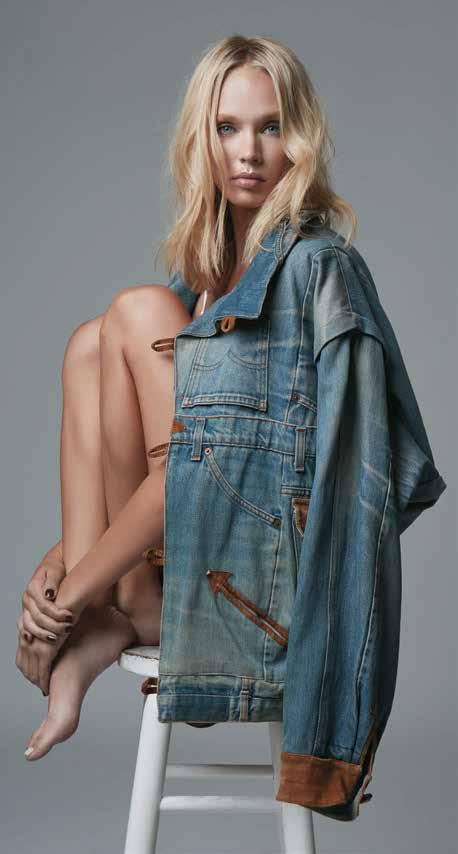
X Athletic and activewear categories influence denim designs. X U.S. denim sales rebound as brands balance bestsellers and new products.
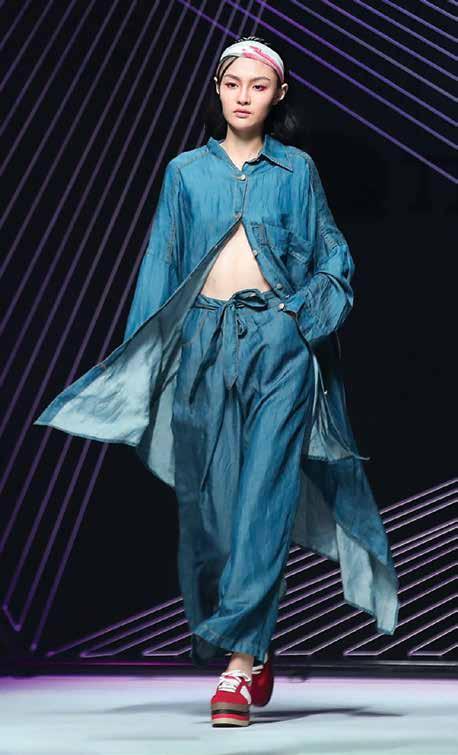
X Lenzing unveils Refibra, he first cellulose fiber featuring recycled material to be offered on a commercial scale. X The documentary “RiverBlue” exposes the denim industry’s significant contribution to global water pollution. X White Oak in Greensboro, N.C. shuts down after 112 years in operation.

X Rivet 50 debuts, serving as an annual who’s who in the denim industry.
X U.S. began to import more denim and China and Mexico begin to lose ground to suppliers in Southeast and Central Asia and Africa.

X VF Corp. completes the separation of VF’s Jeanswear organization into the independent, publicly traded company called Kontoor Brands, Inc. X Levi’s and Outerknown introduces denim made with cottonized hemp.
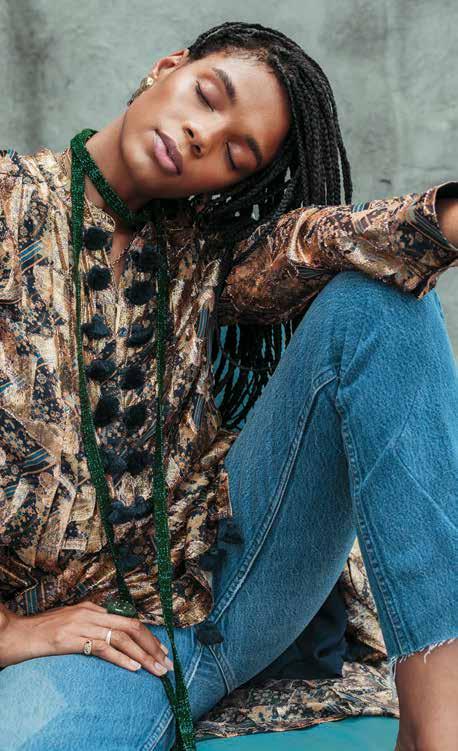
X Covid-19 results in a global shutdown, leaving many to toss their jeans aside for sweats and pajamas at home. X Companies undergo layoffs and restructuring as consumers stay home and shop less. X Rivet debuts “In Season” a look book showcasing new collections from mills and trim suppliers.
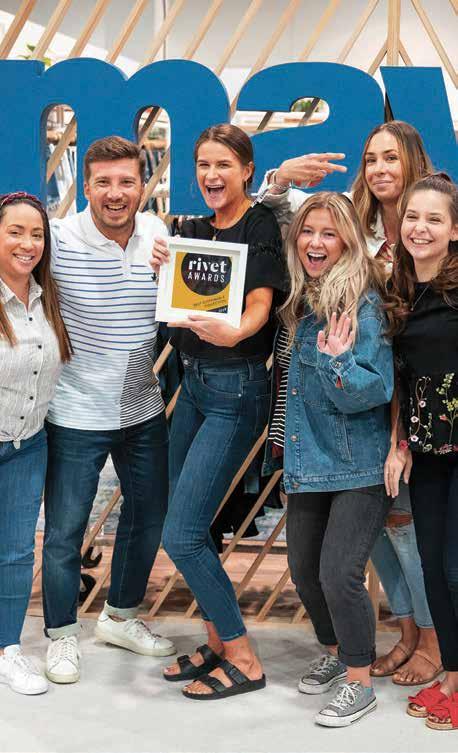
X What began as a pandemic hobby evolves into a renewed appreciation for handcrafted detail, fueling the rise of DIY culture.
X Jeans become wider, looser and baggier.
X Rivet x Project Awards launches, recognizing the brands bringing newness and creativity to the jeans market

X Kingpins Amsterdam holds its first inperson trade show since 2019. X Saitex opens a state-of-the-art fabric mill in Vietnam. X Straight-leg jeans the top-selling fit among women in the U.S. surpassing the once universally popular skinny jean.
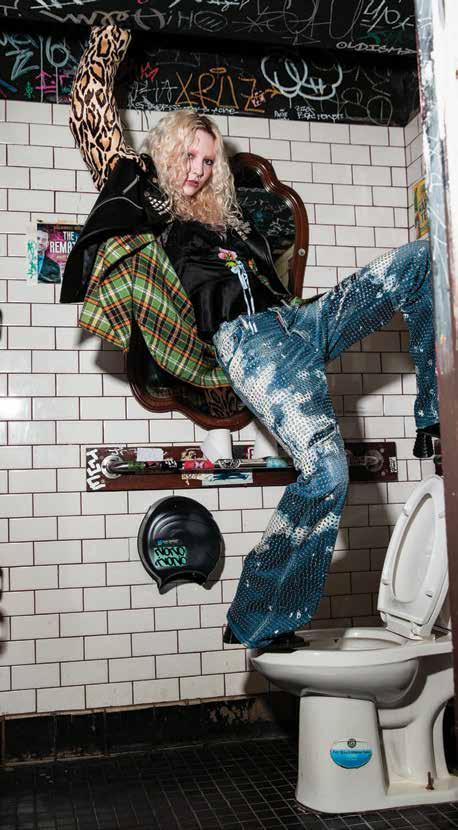
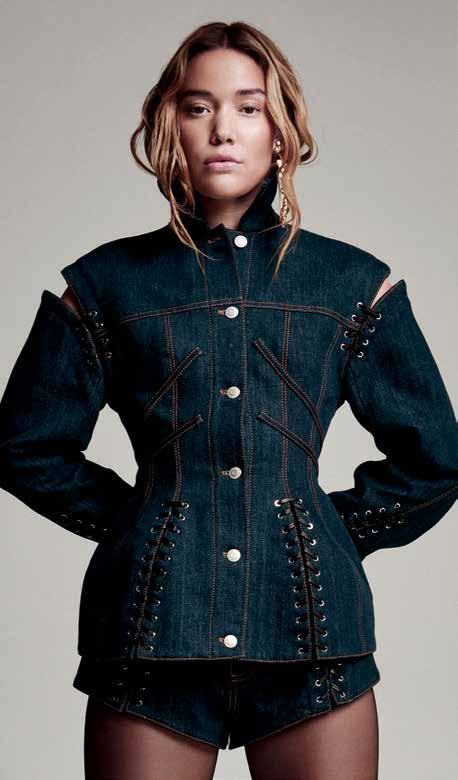
X Pop culture and denim heritage collide as Western fashion take over. X Sourcing Journal x Rivet debuts a sustainability event in Los Angeles. X The industry sees an uptick in bio-based alternatives to petroleumbased dyes and synthetic fibers.

is
SJ
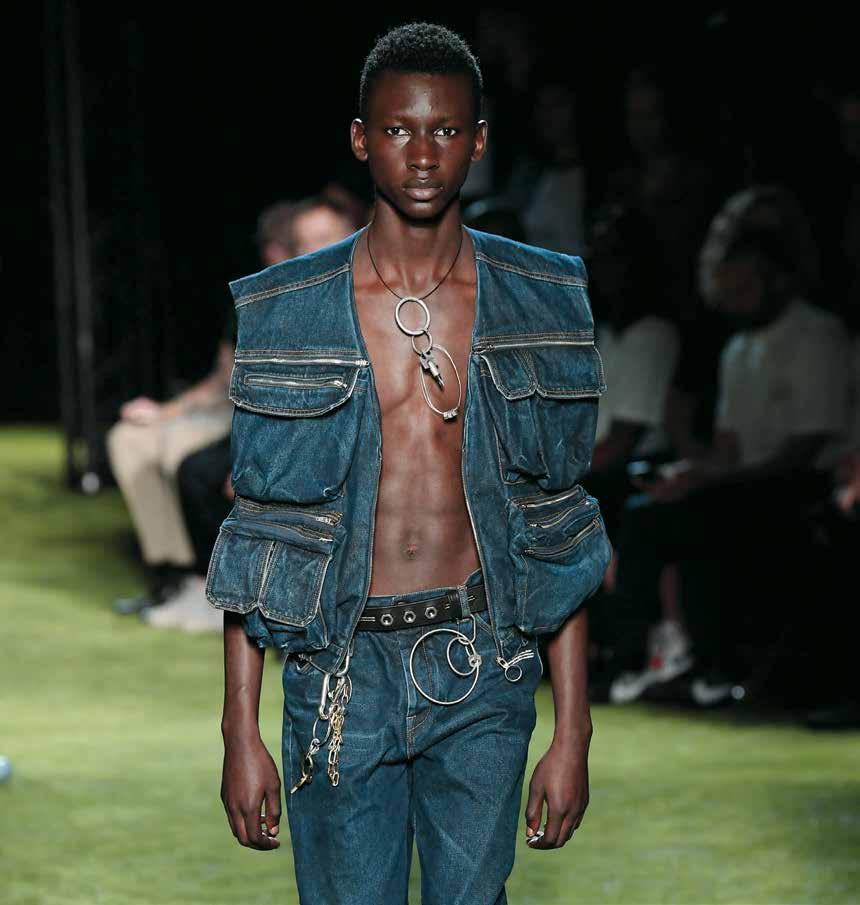


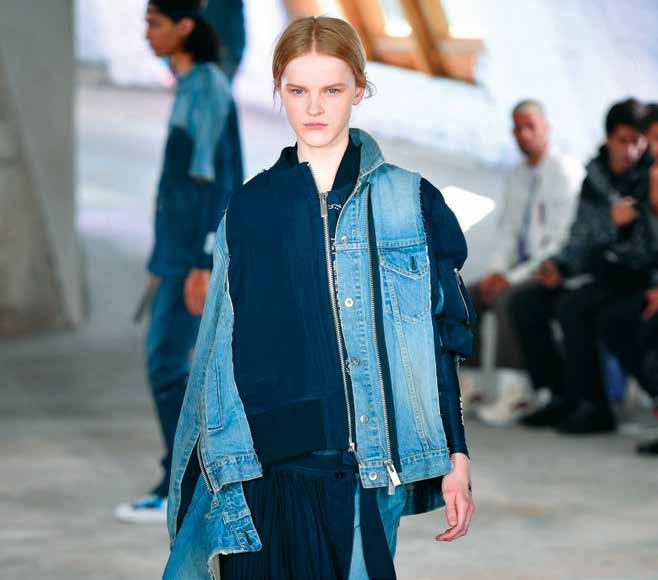

Over the past decade, denim’s versatility—merging global nostalgia with fashion-forward fits and timeless appeal—


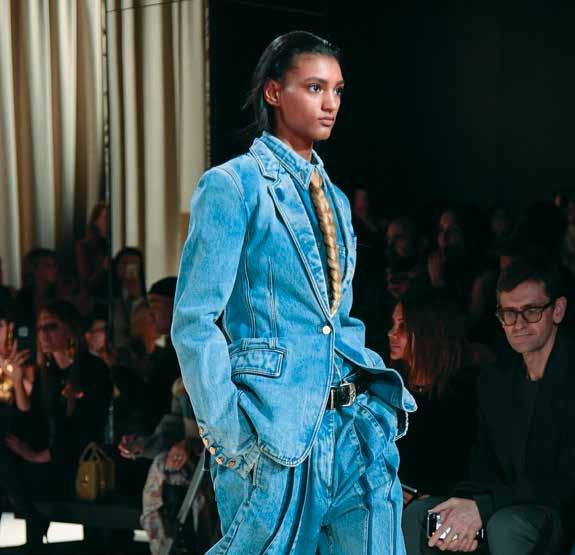

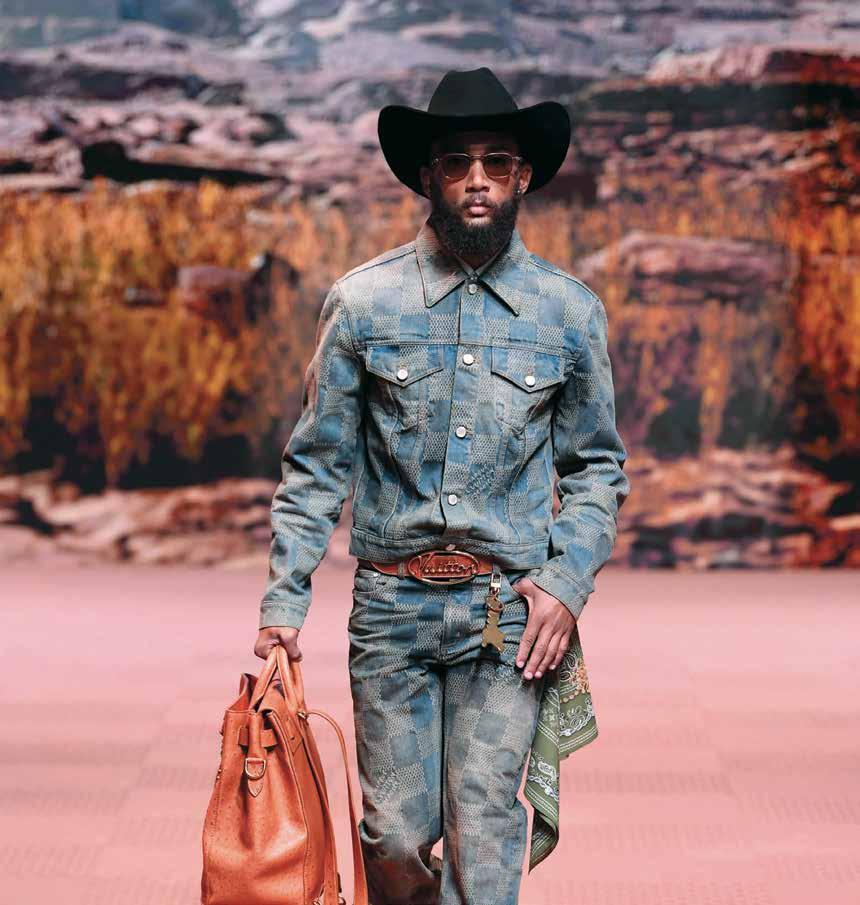

The top denim producing nations are in tariff crosshairs. by
the first half of 2025 has been defined by tariff turmoil, threatening global industry and export sectors across the globe.
The top denim producing countries—China, Pakistan, Bangladesh, Turkey, India, Egypt, Mexico and more—are all currently subject to, or under threat of, punishing tariffs that could hamper the production and export of denim and jeans to the U.S. market.
China, the world’s largest denim supplier, is engaged in a three-month tariff détente with the U.S. The country currently faces 10 percent duties across the board, but that rate will jump to 30 percent if an alternative trade agreement isn’t brokered by early November.
Meanwhile, Pakistan, which has long been a bastion of denim production, housing highprofile mills like Naveena and Soorty, now faces 19 percent duties on U.S. imports—a 10 percent reduction from President Donald Trump’s previously stated rate announced on “Liberation Day” on April 2, but nonetheless, a sizable jump. Turkey, home to denim production stalwarts like Isko and Orta, saw its tariff rate upwardly revised from April, from 10 percent to 15 percent. Egyptian suppliers will face a 10 percent universal baseline tariff—the lowest rate available to U.S. trade partners. However, the new tariffs call into question the benefits of cross-border cooperation with Turkey.
For India, now the third most utilized clothing production base for U.S. companies, Trump’s tariff treatment will be bruising.
Kate Nishimura
The country currently faces 50 percent tariffs on exports to the American market—the amalgamation of a 25 percent “reciprocal” duty rate and a punitive tax levied by the administration to account for India’s purchase of Russian oil.
Bangladesh faces 20 percent duties—a downgrade from the 35 percent announced in April, but still a burden for a country which relies so heavily on the read-made garments sector, which represents about 85 percent of the country’s total exports, sending $7.4 billion in apparel to the U.S. last year alone.
Mexico, which has seen its apparel sector, and its denim production capacity more specifically, blossom in recent years, has seen its future as a U.S. free-trade agreement partner called into question—a fact that will have massive ramifications on cross-border trade.
Products not covered by the U.S.-MexicoCanada Agreement (USMCA) are currently subject to 25 percent tariffs with a threat of 30 percent if the U.S. and Mexico aren’t able to reach a trade truce. Apparel and footwear imports—including denim and jeans—are covered products under USMCA, meaning that they will continue to enter the country duty free. However, they must meet specific rules of origin.
All countries involved in trading denim products with the U.S., with the exception of free-trade agreement partners, will face higher duties.
Lesotho, once a small-but-mighty powerhouse of denim production characterized as the “denim capital of Africa,” saw its free-trade status with the U.S. evaporate overnight as the Africa Growth and Opportunity Act (AGOA) expired on Sept. 30. Now, the country will see 15 percent tariffs on exports including denim unless the Trump administration or Congress opts to renew the trade preference program.
With America’s allies and competitors alike now subject to shifting trade tides, it’s yet to be seen how Western firms will revamp their sourcing structures. Some may attempt to weather the storm by sticking with the partners they know, regardless of new duties, in the interest of long-term investment.
But price increases are imminent, if they haven’t taken effect already, as evidenced by recent earnings announcements. American shoppers stand to see higher MSRPs at retail this season, and that includes denim and jeans.
Dr. Sheng Lu, professor of fashion and apparel studies at the University of Delaware, reviewed the pricing and merchandising of jeans sold by Gap, H&M, Kohl’s, Lee, Levi’s, Macy’s, Nordstrom, Target, Walmart and Zara in the U.S. retail market between May 1 and Sept. 30, and found that most have already raised their selling prices—though “the magnitude varied significantly.”
The biggest price hikes—over 30 percent— were visible among retailers like Zara and H&M, while the department stores and specialty retailers “raised their prices more modestly,” he said, noting that the increases were on average less than 10 percent.
“One reason is that fast-fashion retailers rely more heavily on man-made fibers, including in many of their denim products, which face higher tariff rates than jeans made from 100 percent cotton,” Lu said. “Nevertheless, fast-fashion retailers continue to demonstrate competitiveness in terms of their absolute price levels.”
In addition to raising prices, retailers are also offering fewer discounts. Zara and H&M only sold 23 percent of jeans at a discount this year, compared to 51 percent during May through September 2024. Specialty stores like Gap saw similar patterns—86 percent discounted denim sold through in 2025, compared to 96 percent last year.
“This suggests that brands and retailers are becoming more cautious about protecting their profit margins, especially given the limited flexibility to raise selling prices further,” Lu explained.
Perhaps not surprisingly, retailers aren’t reupping on orders as frequently, either.
“Tariff uncertainty has disrupted supply chains, leading most retailers to report
BRANDS AND RETAILERS ARE BECOMING MORE CAUTIOUS ABOUT PROTECTING THEIR PROFIT MARGINS...” Dr. Sheng Lu
lower product replenishment rates in 2025 (May–September) than in 2024 over the same period,” Lu said. “For example, in 2024, between 40 percent and 60 percent of jean SKUs were restocked at both specialty stores and fast-fashion retailers from May to September. However, in 2025 this rate dropped significantly to around 30 percent.”
That should cause some consternation among eagle-eyed economists, sourcing agents, retailers and shoppers alike. Given its status as a “staple product” for American shoppers, the academic said, “we typically see frequent replenishment for jeans.”
SSOKO INTRODUCES a new dimension of innovation, transforming the way garments are washed and cared for. Instead of modifying formulas by adding or removing ingredients, Hydrogel changes the very nature of water, turning it into a gel. This transformation opens the door to a completely new washing experience: fabrics and finishing agents react differently inside the gel bath, enabling smarter, simpler and more creative processes.
Hydrogel’s formulation already contains everything needed to achieve a natural stone-wash effect, while garments are gently wrapped in a gel bubble. This creates a protective environment for fibers, ensuring both exceptional aesthetics and lasting quality.
“By reshaping water itself, Hydrogel is more than just a treatment, it is a new standard of innovation with reduced impact, offering the fashion industry beautiful results and endless new possibilities,” said Luca Braschi, marketing and technology manager, Soko.
Traditional denim washing methods often subject fabrics to abrasive chemicals and mechanical stress, which can weaken elasticity and durability— particularly in stretch, lightweight, or delicate materials like knitwear.
Hydrogel offers a gamechanging alternative: the gel’s bubble-like structure
cushions garments, reducing stress on fibers, while the nature of water still allows it to uniformly distribute and cover any surface evenly.
The power of the gel also prevents or slows down the penetration of the chemical into the fiber, thus maintaining the performance and at the same time protecting the fabric. Even the most sensitive materials emerge from the process intact, soft and strong.
“Hydrogel is the perfect solution for today’s increasingly innovative and premium fabrics, ensuring they remain uncompromised,” Braschi said.
Hydrogel is an all-in-one compound that simplifies the denim washing process. Once mixed with water, it forms a gel bath containing all the necessary ingredients for a complete stone-wash effect. This means that raw denim can be transformed into a bleached, finished look in just one step— eliminating the need for multiple treatments. Not only does this save time, but it also minimizes resource consumption (water, energy, washing cycles), reducing the overall environmental impact. Hydrogel combines innovation and efficiency for truly remarkable results.
SUSTAINABILITY AND SAVINGS IN ONE
Hydrogel is designed with sustainability at its core.
Traditional denim washing consumes over 30 liters of water per garment, whereas the Hydrogel process achieves the same result with only 4 liters. This drastic reduction in water usage represents a significant leap forward in eco-friendly denim production. Additionally, Hydrogel streamlines the process into a single step, reducing production time and resource use without compromising quality.
One of Hydrogel’s strongest advantages is its simplicity—it requires no special equipment and integrates seamlessly with existing washing machines. This makes it practical, scalable and accessible for laundries


“HYDROGEL, BY TRANSFORMING WATER INTO GEL, MAKES IT POSSIBLE TO CARRY OUT THE WASHING PROCESS FROM RAW GARMENT TO BLEACH IN A SINGLE BATH, WHILE PROTECTING FIBER STRENGTH AND SAVING WATER.”
LUCA BRASCHI , marketing and technology manager, Soko
worldwide. “By delivering superior fiber protection, significant water savings and process simplification, Hydrogel is more than just a new product. It’s a paradigm shift in denim treatment,” Braschi said.
Hydrogel represents a bold leap forward for the fashion industry, offering a revolutionary washing method with reduced environmental impact. By reshaping water into a protective gel, Soko has created a new standard for denim care—one that embodies aesthetics, durability and sustainability, while unlocking endless creative possibilities for garment finishing. ■
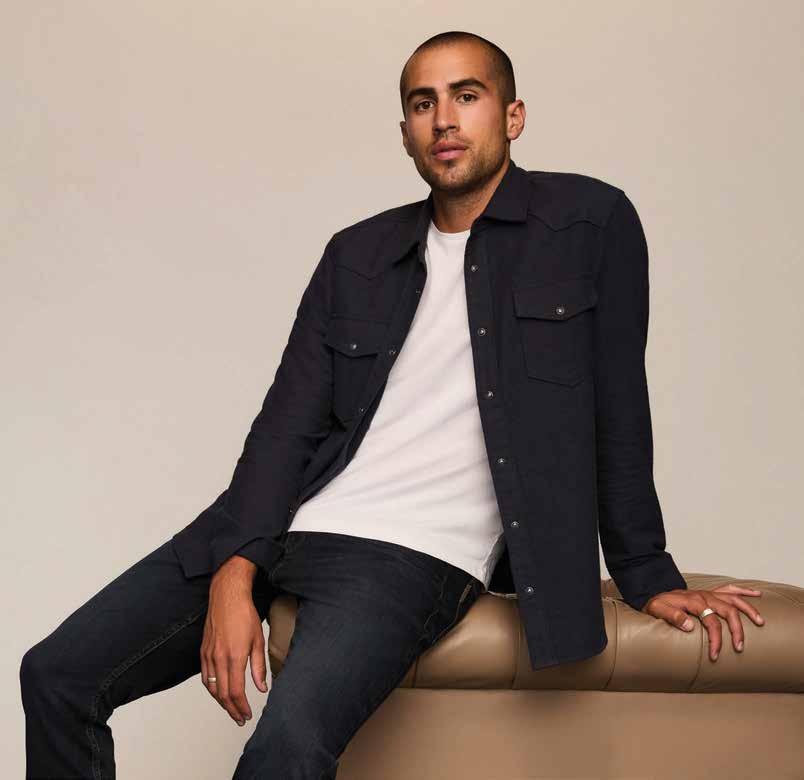
in a category dominated by legacy brands, it’s a feat for any newcomer to make a name for themselves, let alone have a fabric become instantly recognizable by consumers. However, that’s exactly what Paige Denim achieved with Transcend, a stretch fabric that has quietly redefined the way men experience jeans by providing unmatched comfort and superior fit. c This fall marks 10 years of Transcend for men, a turning point for the Los Angeles premium denim brand and a shift in the men’s denim category’s perception of stretch denim. c Paige has sold more than 10 million pairs of Transcend jeans to men to date, but that was never part of the plan. Rather, it was a Hail Mary attempt to keep buyers interested in Paige for men.
“At the time, we didn’t have a strong presence in major department stores for men’s products—those relationships were mostly established on the women’s side. I’d get meetings with the men’s buying teams, but more out of courtesy than real interest,” said Jon Geller, men’s president of Paige. “The feedback was consistent: there wasn’t a clear point of view for Paige’s men’s offering. Honestly, I agreed. I shared my frustration and eventually was given the green light to get involved on the product side and try to develop it.”
Geller’s solution—to introduce Paige’s No. 1 women’s fabric Transcend—was initially met with resistance. “Stretch was something that had really been kept out of the men’s market, and there was an assumption that guys wouldn’t wear it,” he said.
However, the prototypes were the most comfortable Geller had ever felt in jeans, and after making a few tweaks to washes, the Nordstrom team in Seattle—which Geller had previously been unsuccessful getting an order from—saw the appeal of Transcend too.
“When I showed them Transcend for the first time and explained what I was trying to do, the buyer looked at me and said, ‘This is it. This is what you guys do.’”
Nordstrom bought it on the spot, initially for 15 doors and quickly expanding to 50 in just months. Geller recalled the sell-throughs being “unlike anything they had ever seen.” It was the right fabric at the right time as
H G
Transcend accounts for 60-70 percent of Paige’s men’s business.
men’s fits were becoming slimmer, and consumers were prioritizing comfortable and versatile jeans. By the next market week, two competitors were touting their own versions of the fabric.
A decade later, the market is dominated by stretch and comfort stretch fabrics—but Geller attributes Transcend’s enduring success to its consistent performance and exceptional ability to absorb and hold color. Its consistency gives loyal customers the confidence to build their entire wardrobe around a single fit and fabric, changing up the color or wash depending on the season. It also eliminates the guesswork that comes with ordering jeans online.
The original mill continues to supply Paige with the specialized fabric, though many have tried to duplicate it.
“Everyone I’ve worked with, from retailers to designers who have joined us from another

EVERYONE’S ALWAYS TRYING TO FIGURE OUT THE SECRET TO IT, AND 10 YEARS LATER, NO ONE’S COME CLOSE.” Jon Geller, paige

brand in the men’s space, says, ‘Oh, we’ve got piles of this stuff at our office.’ Everyone’s always trying to figure out the secret to it, and 10 years later, no one’s come close.”
Every brand aspires to create a consistent hero product—and for Paige, that’s exactly what Transcend has become. Accounting for 60–70 percent of the brand’s men’s denim business, Transcend denim has proven its staying power.
“From the beginning, we’ve built our brand on the strength of our product—not on gimmicky marketing,” Geller said. “I never wanted to position this as a ‘travel pant’ or denim that feels like sweatpants. This is denim—our version of denim—and that’s why it’s still leading the market ten years later.”
